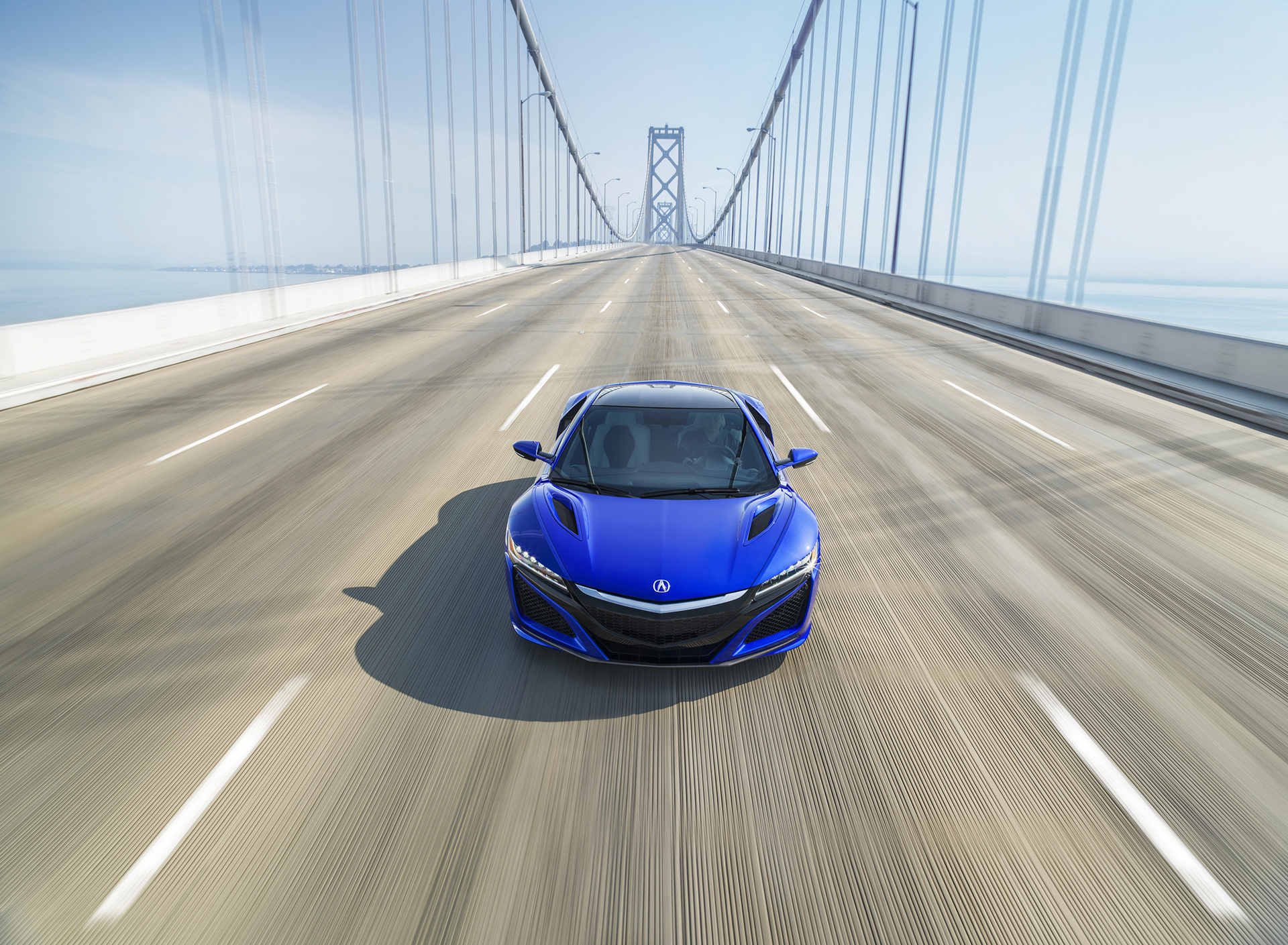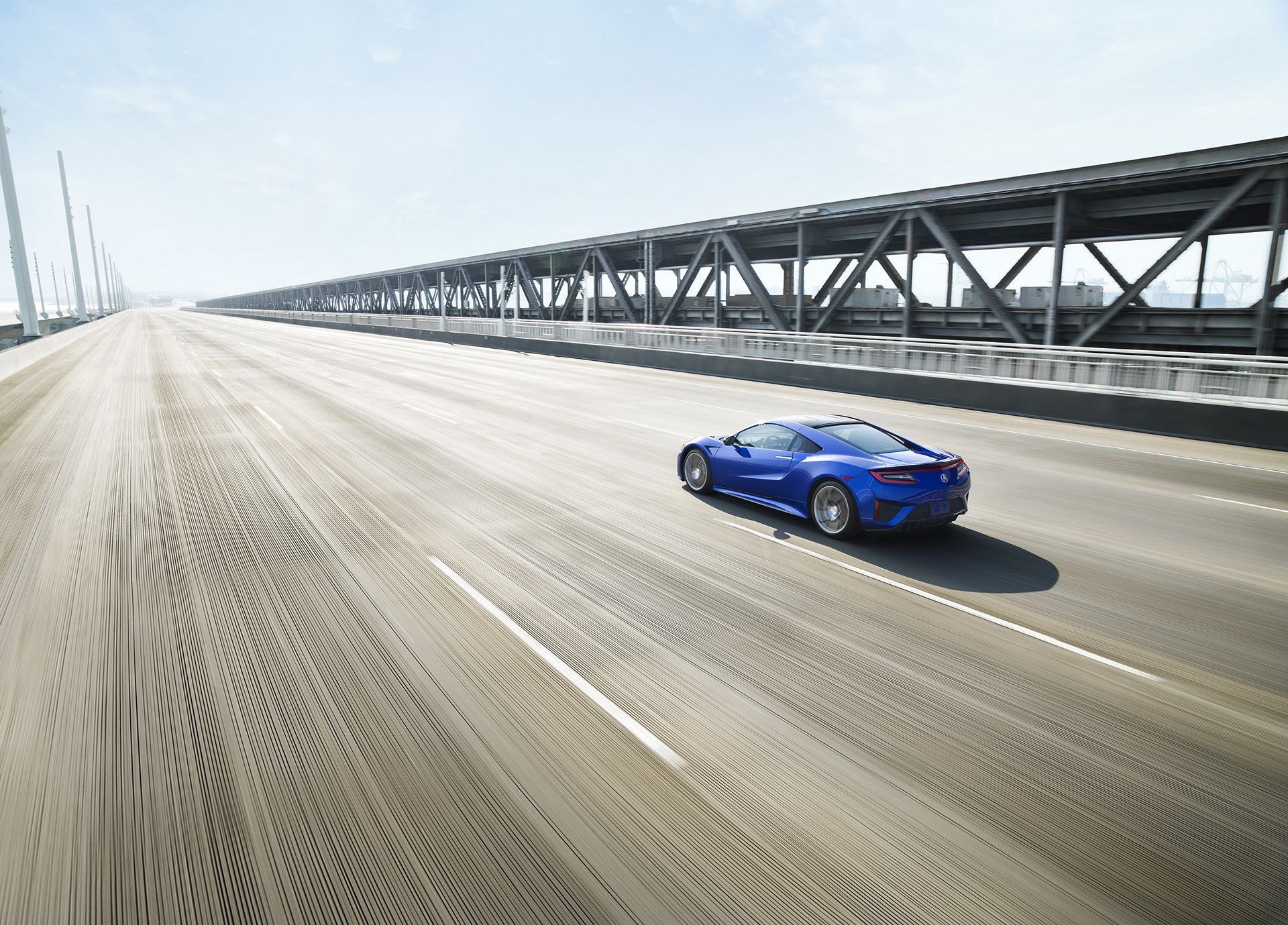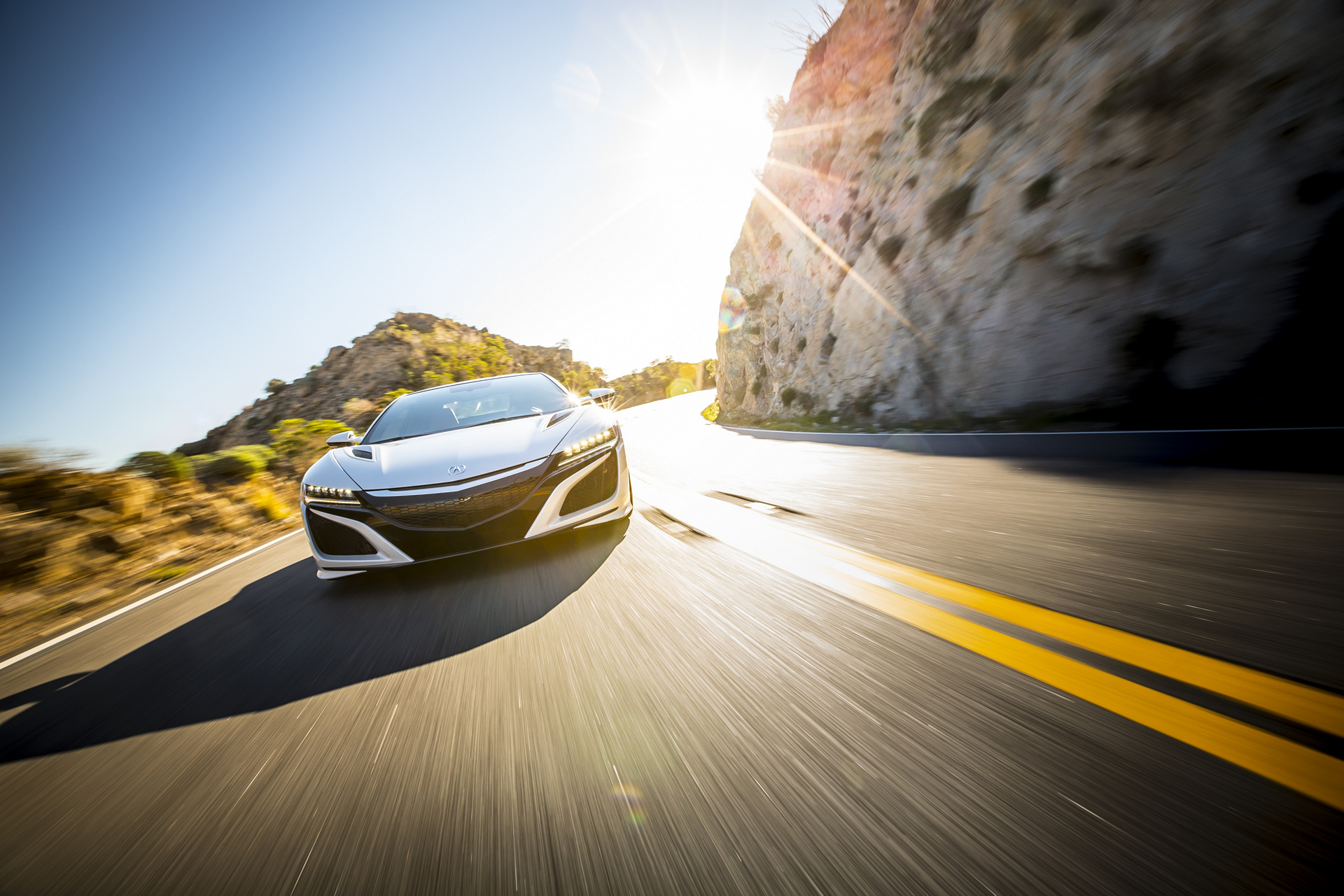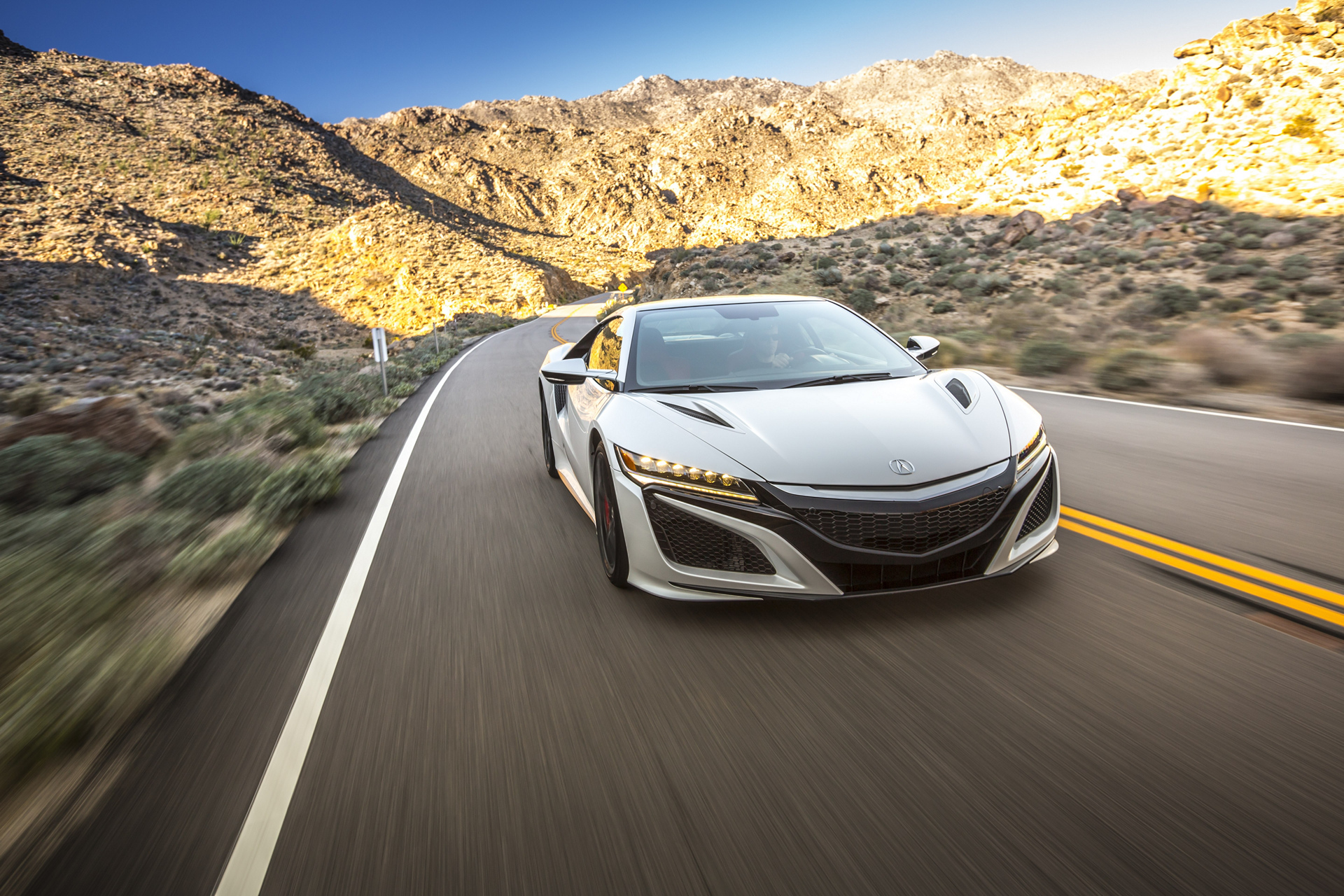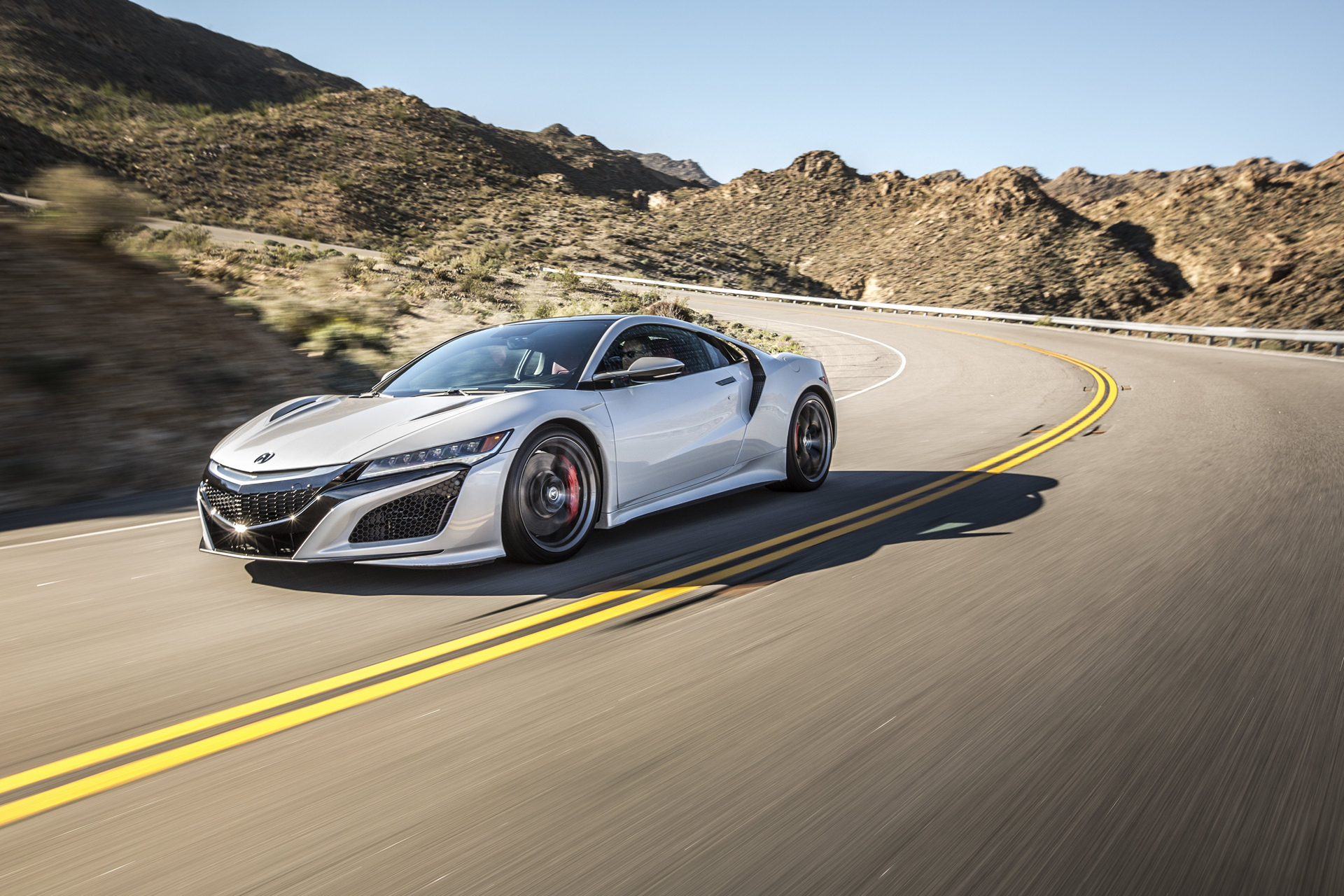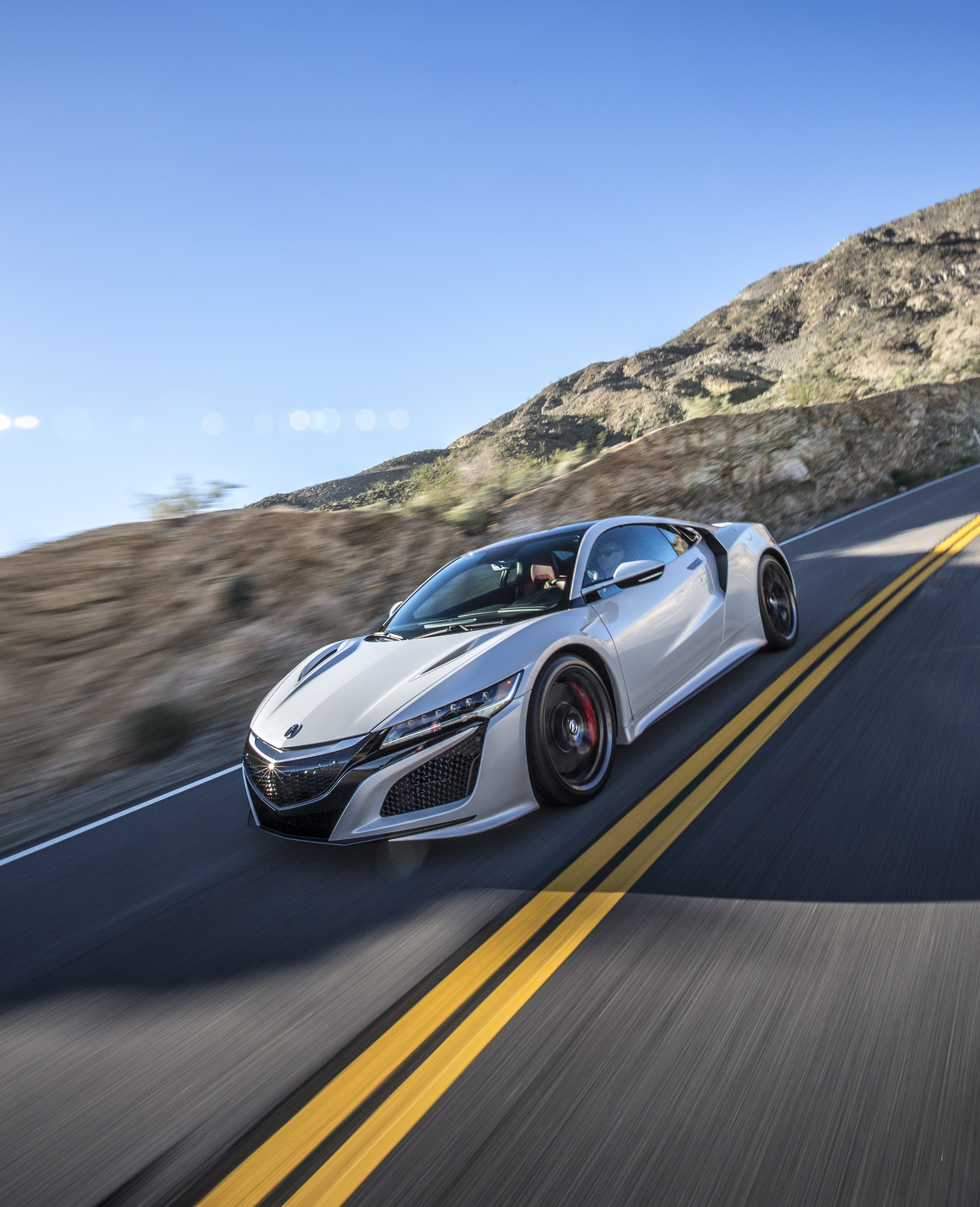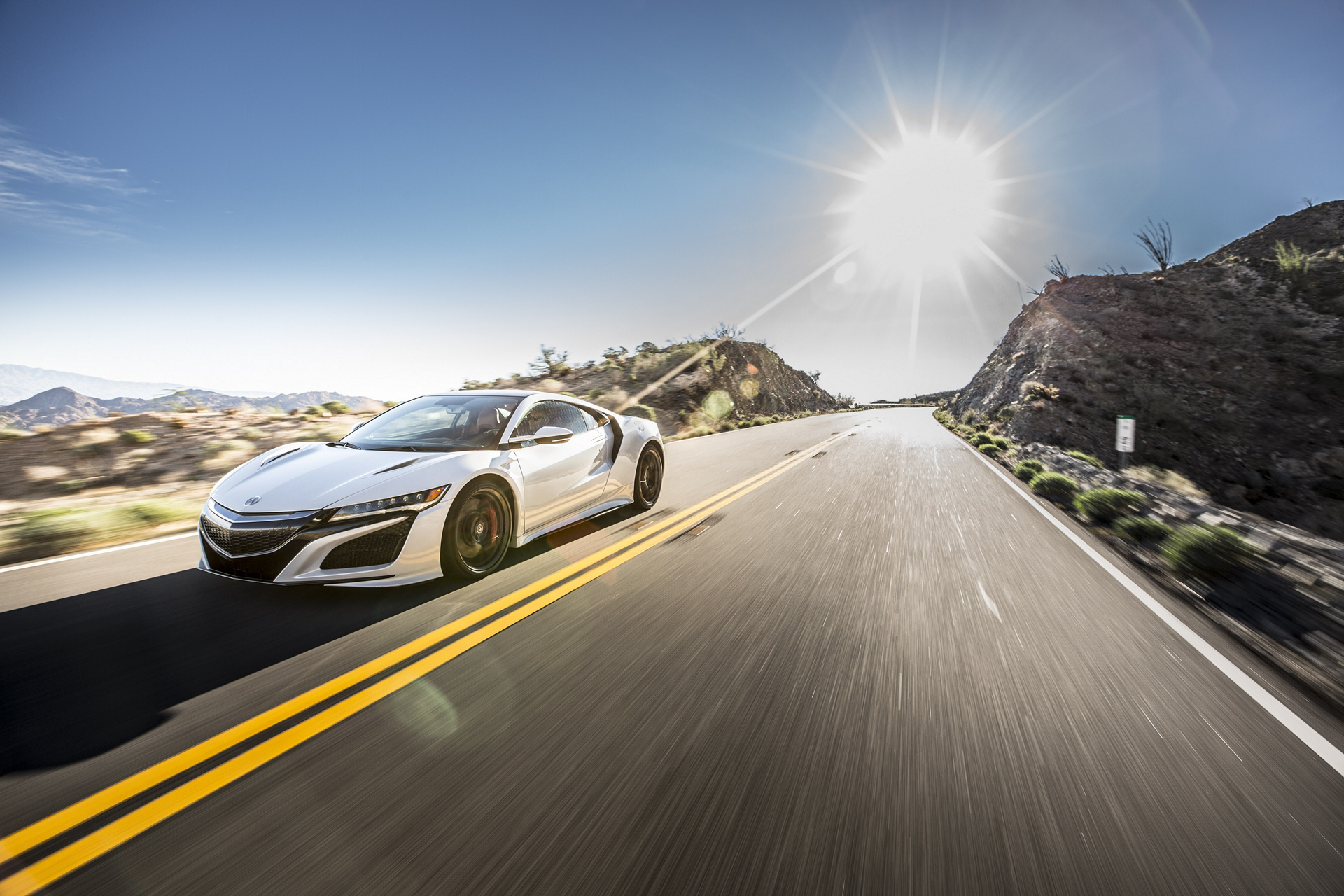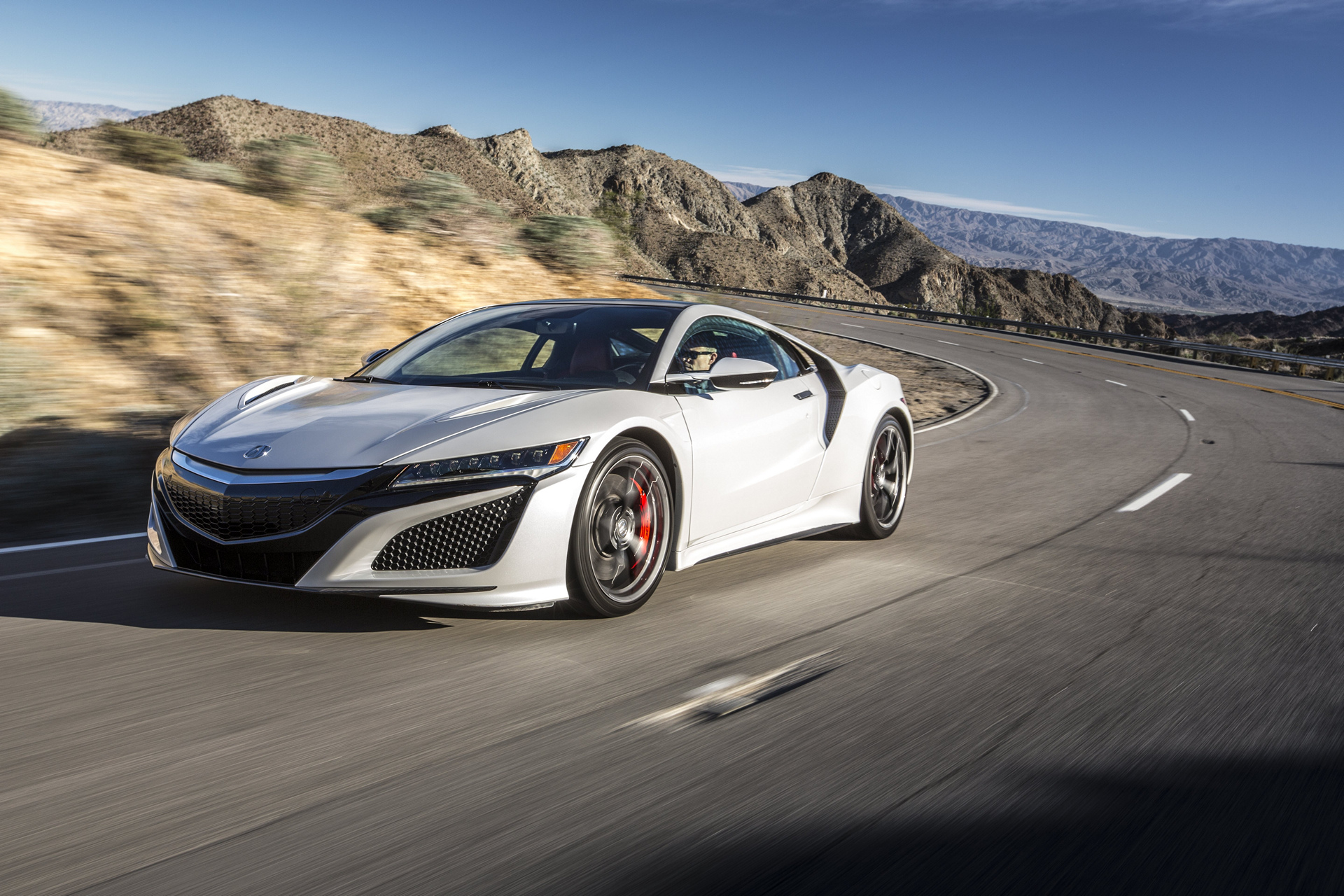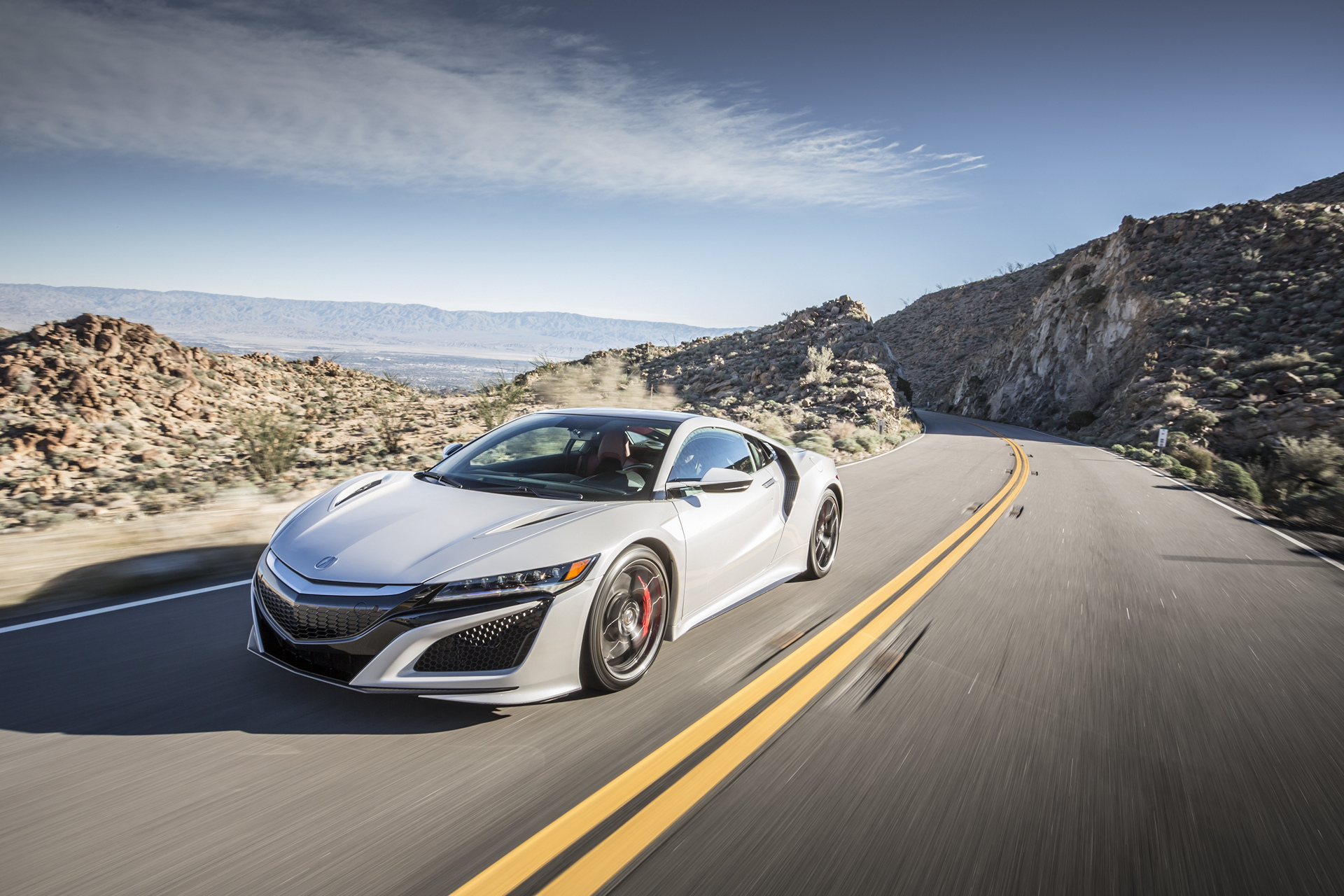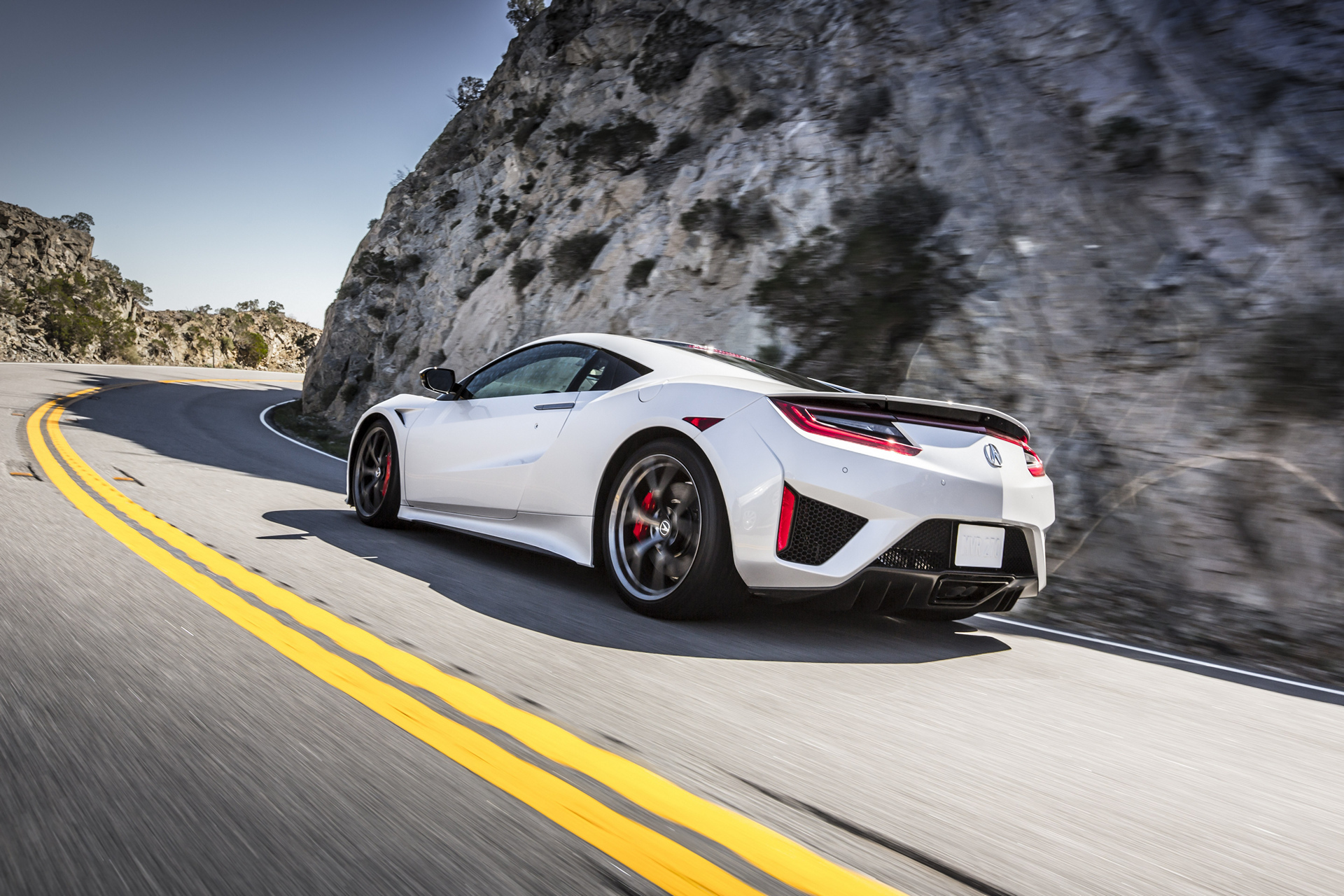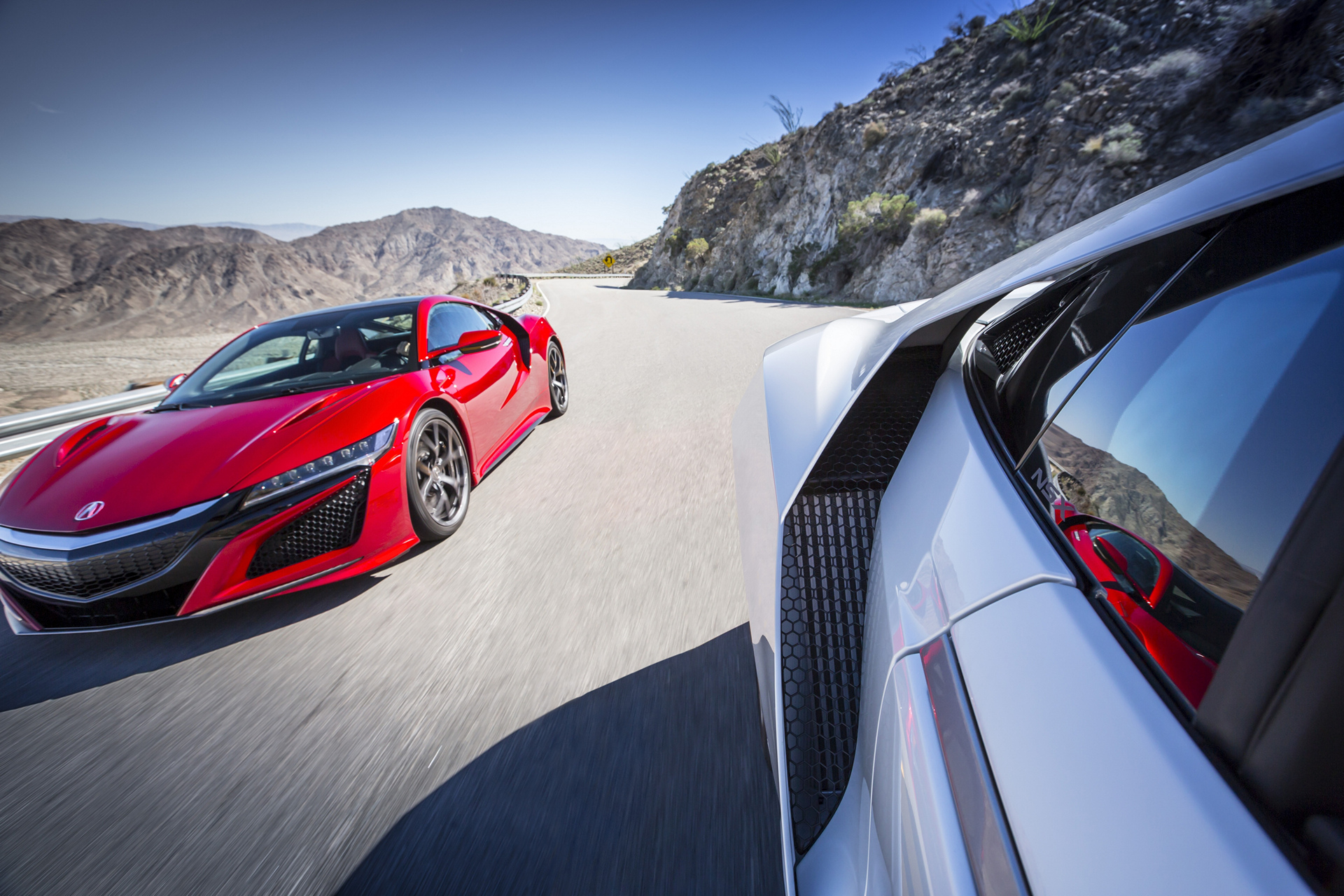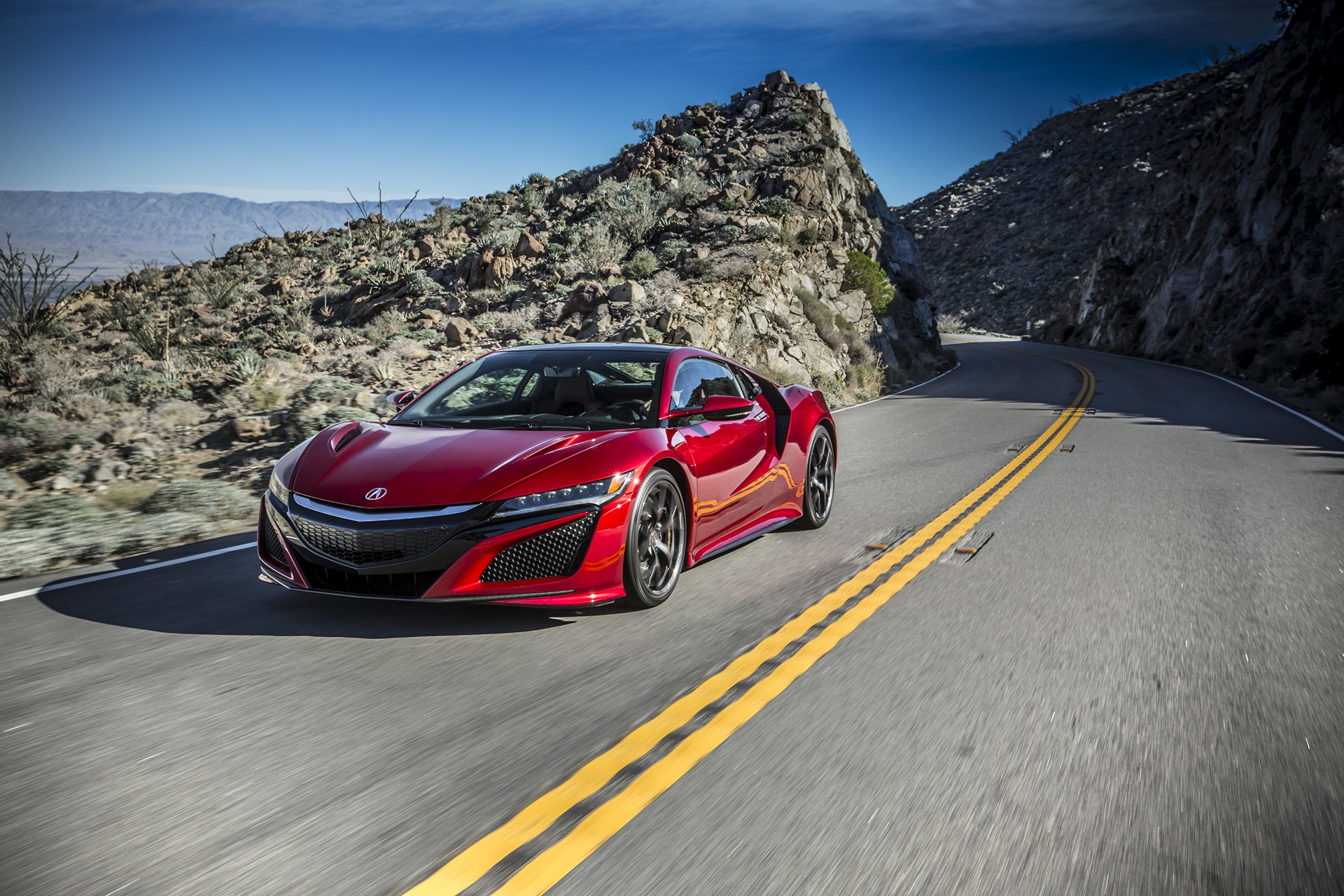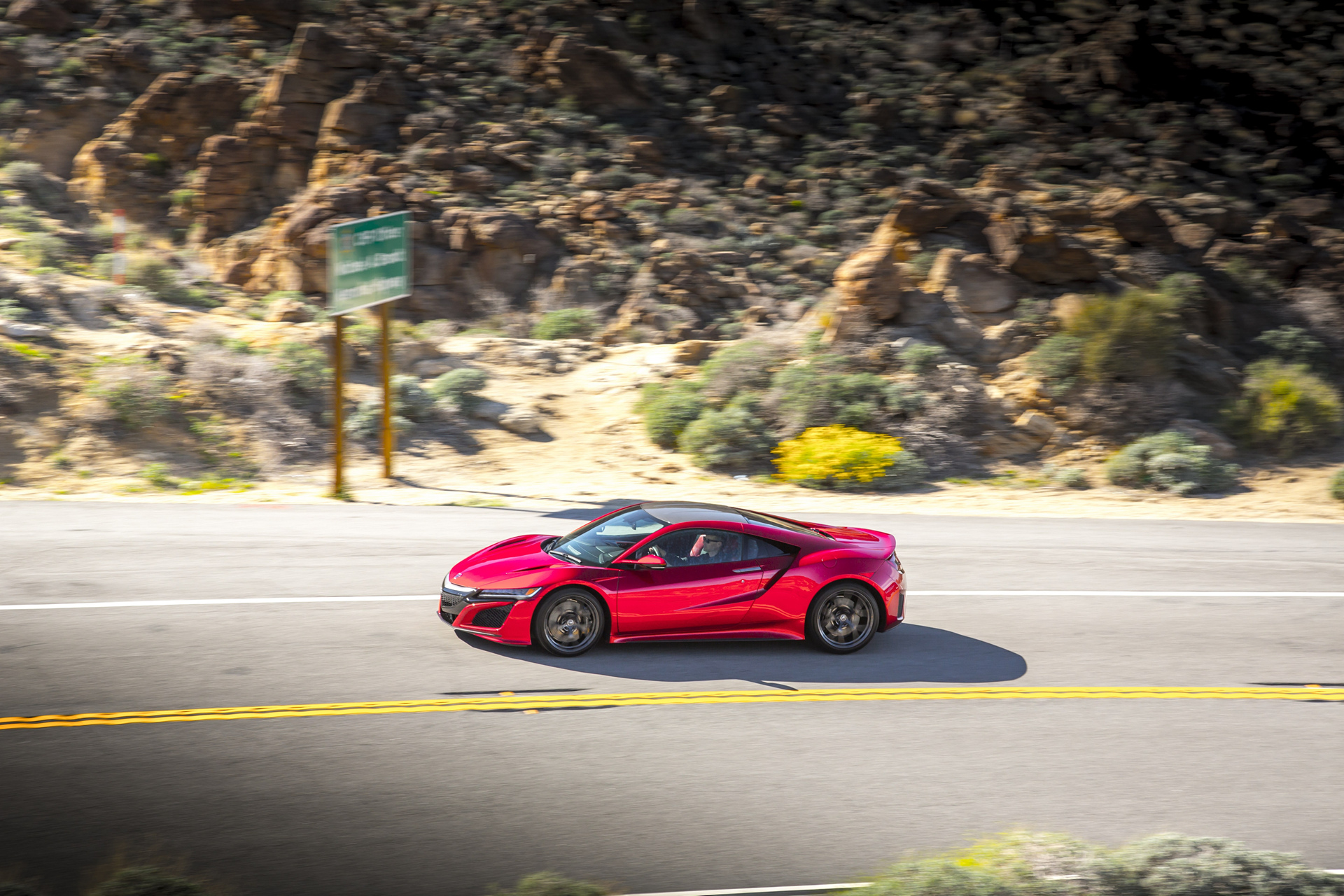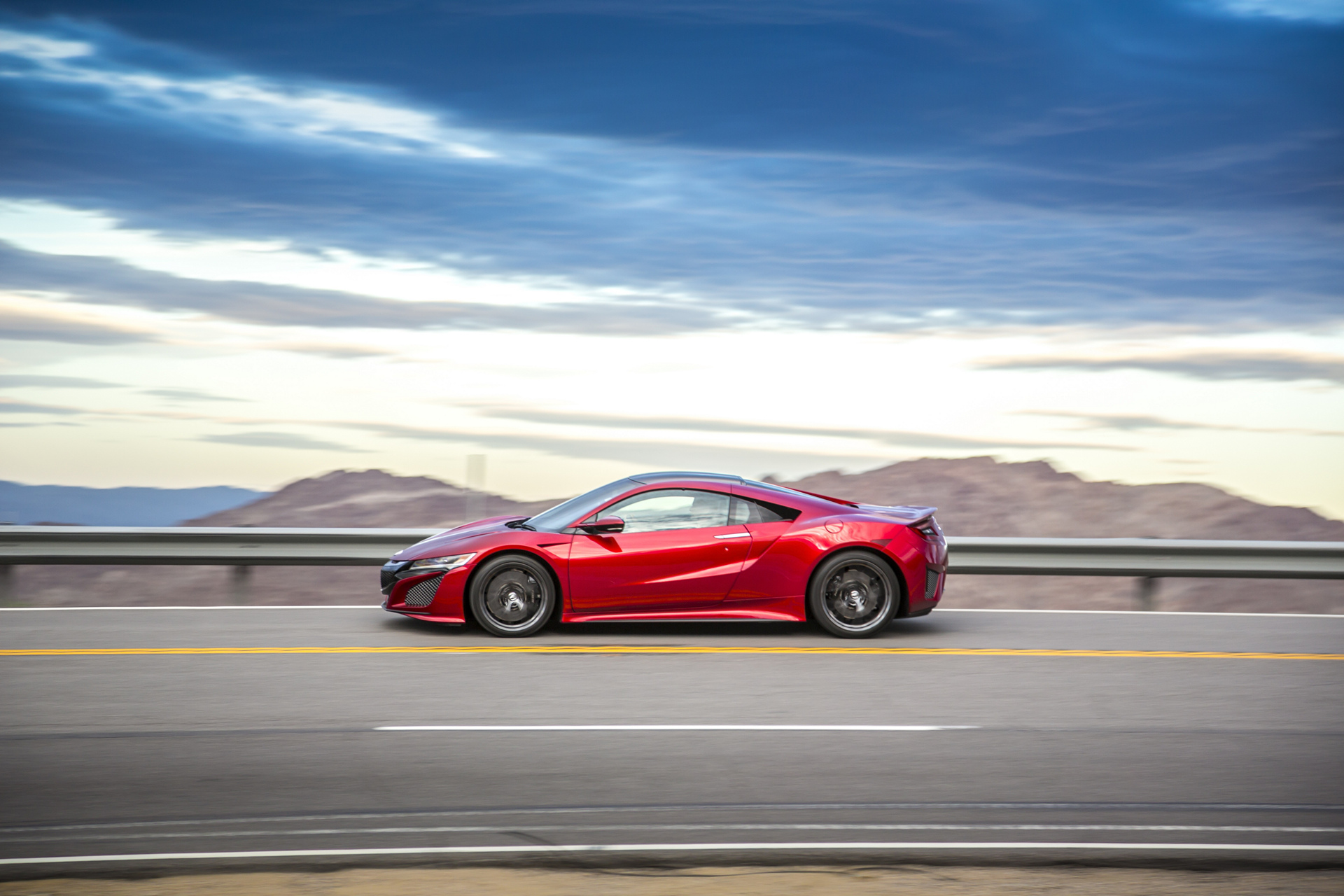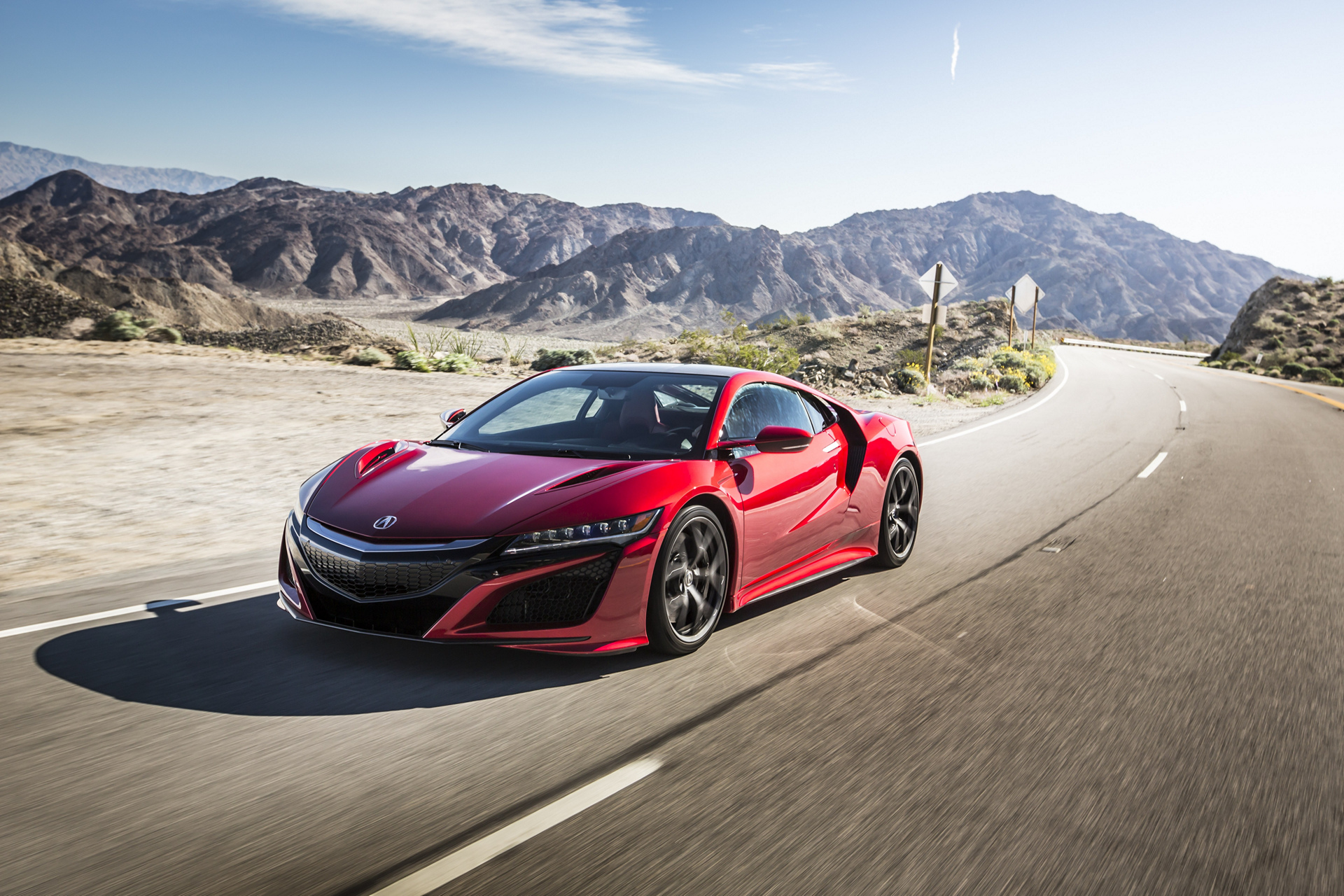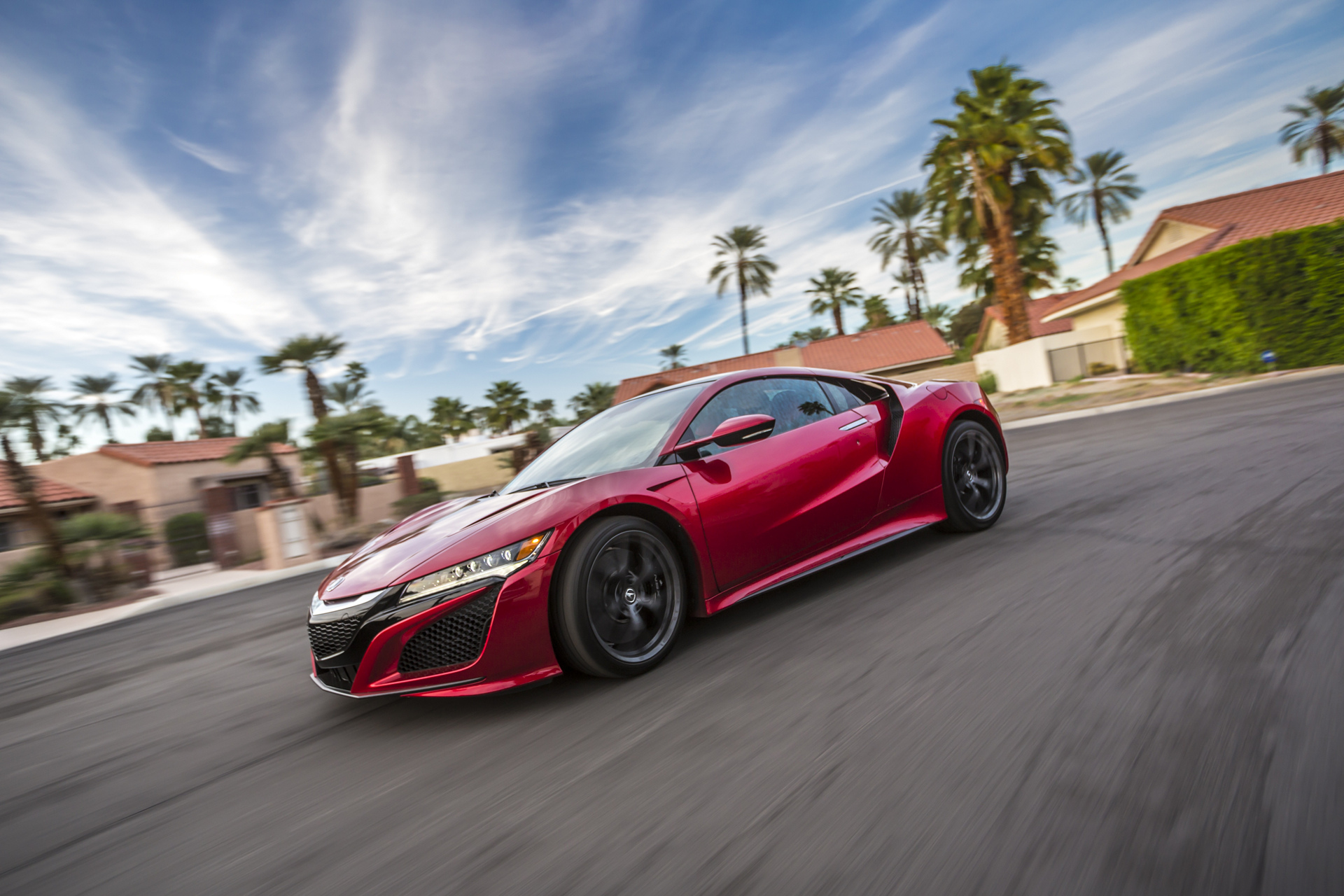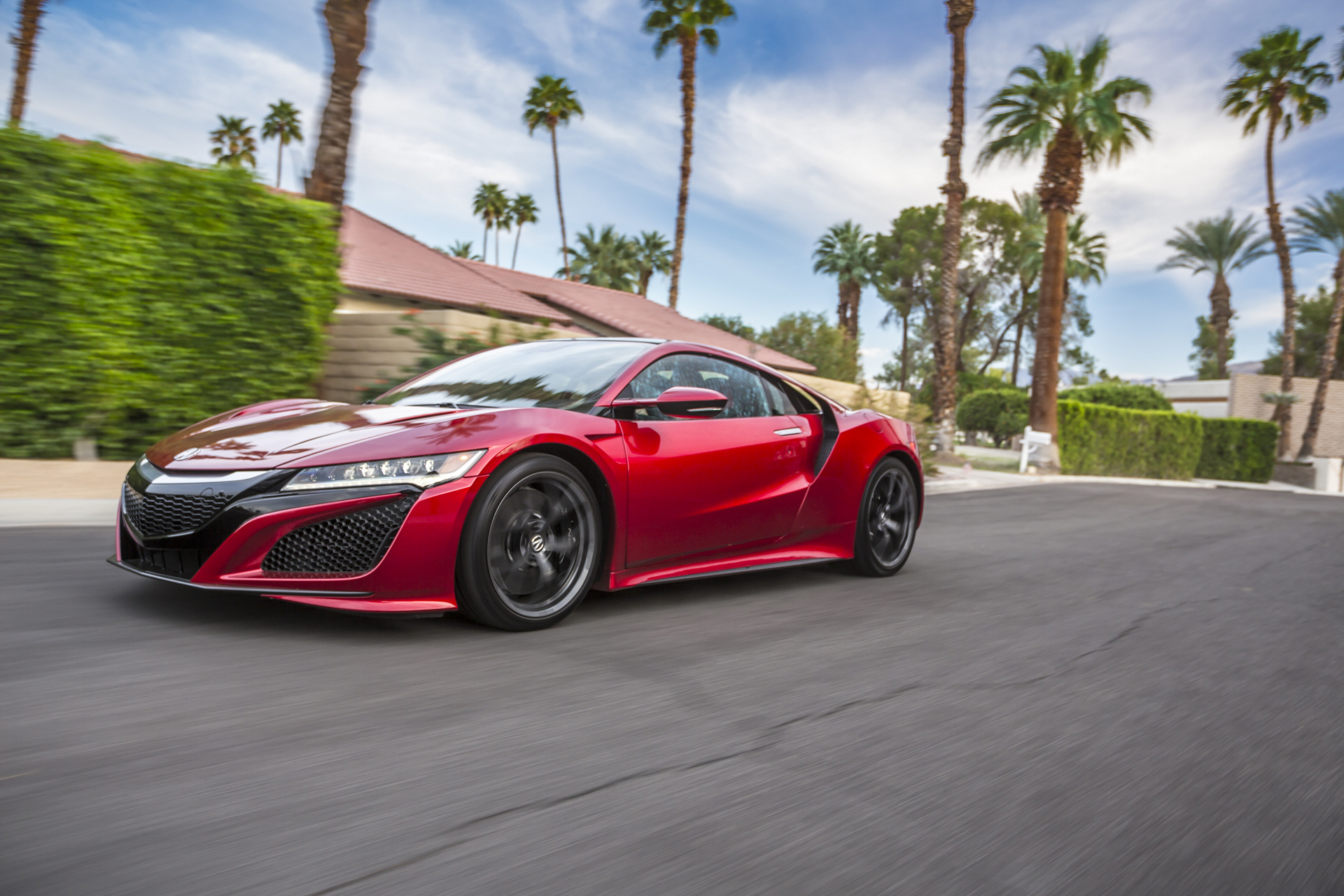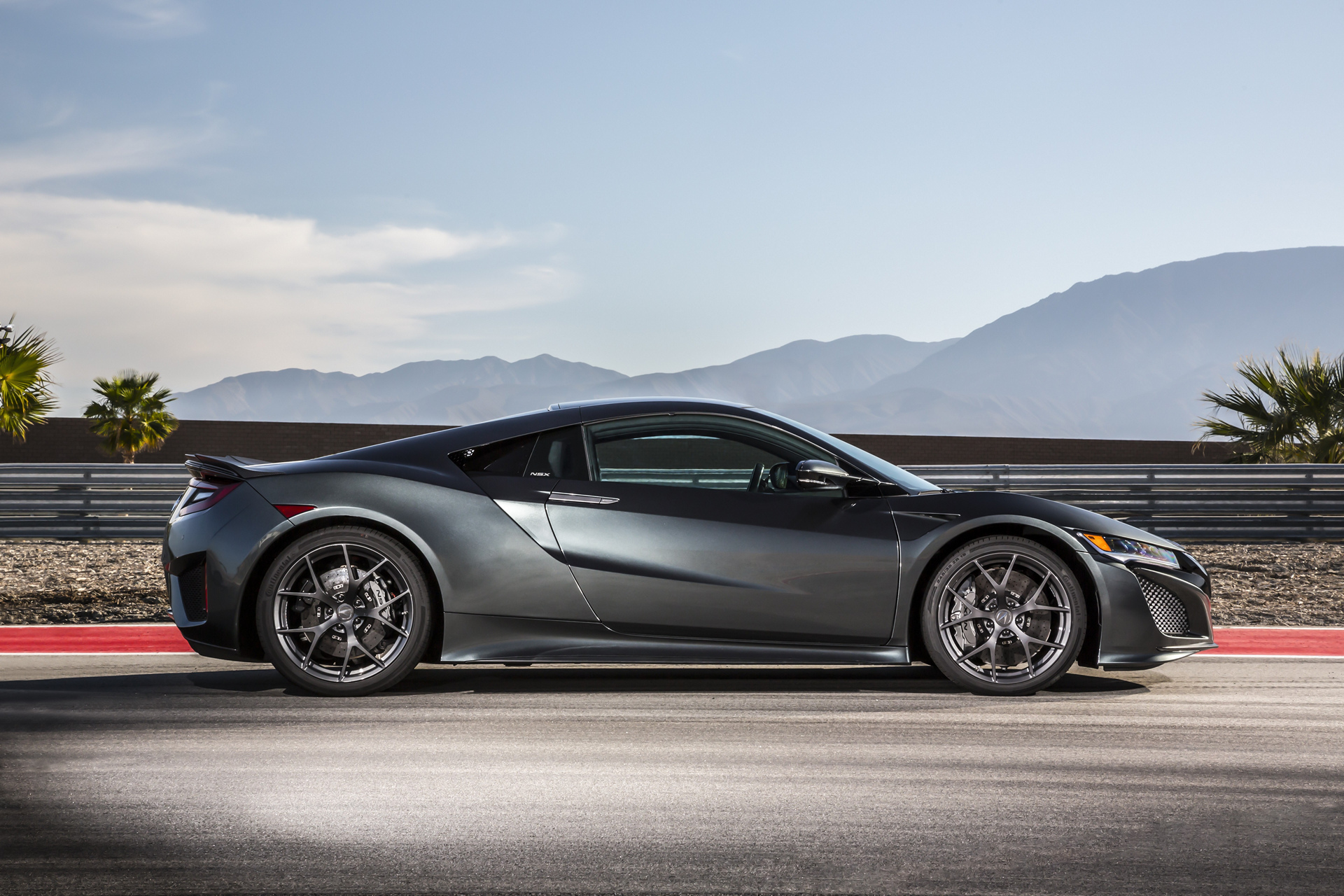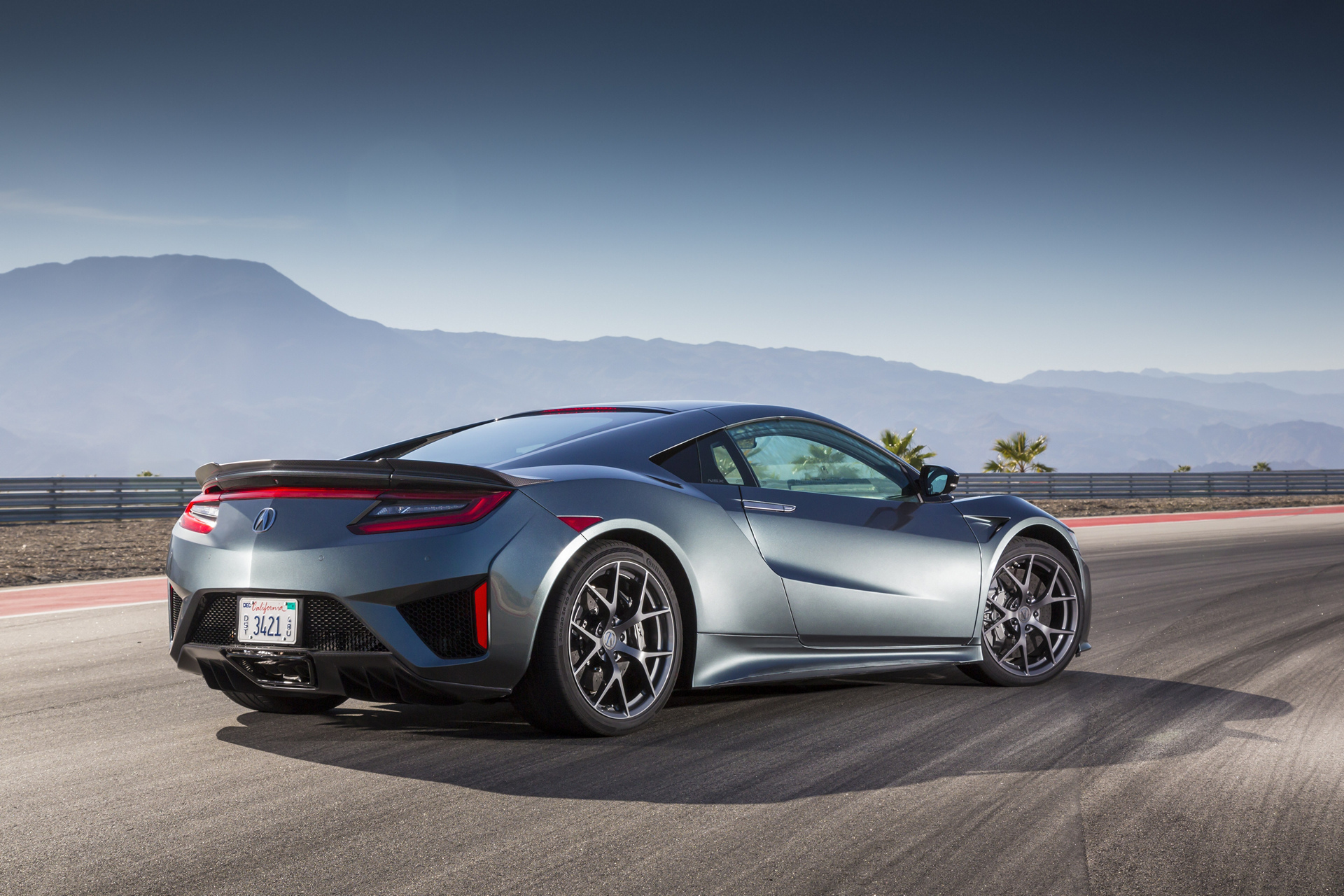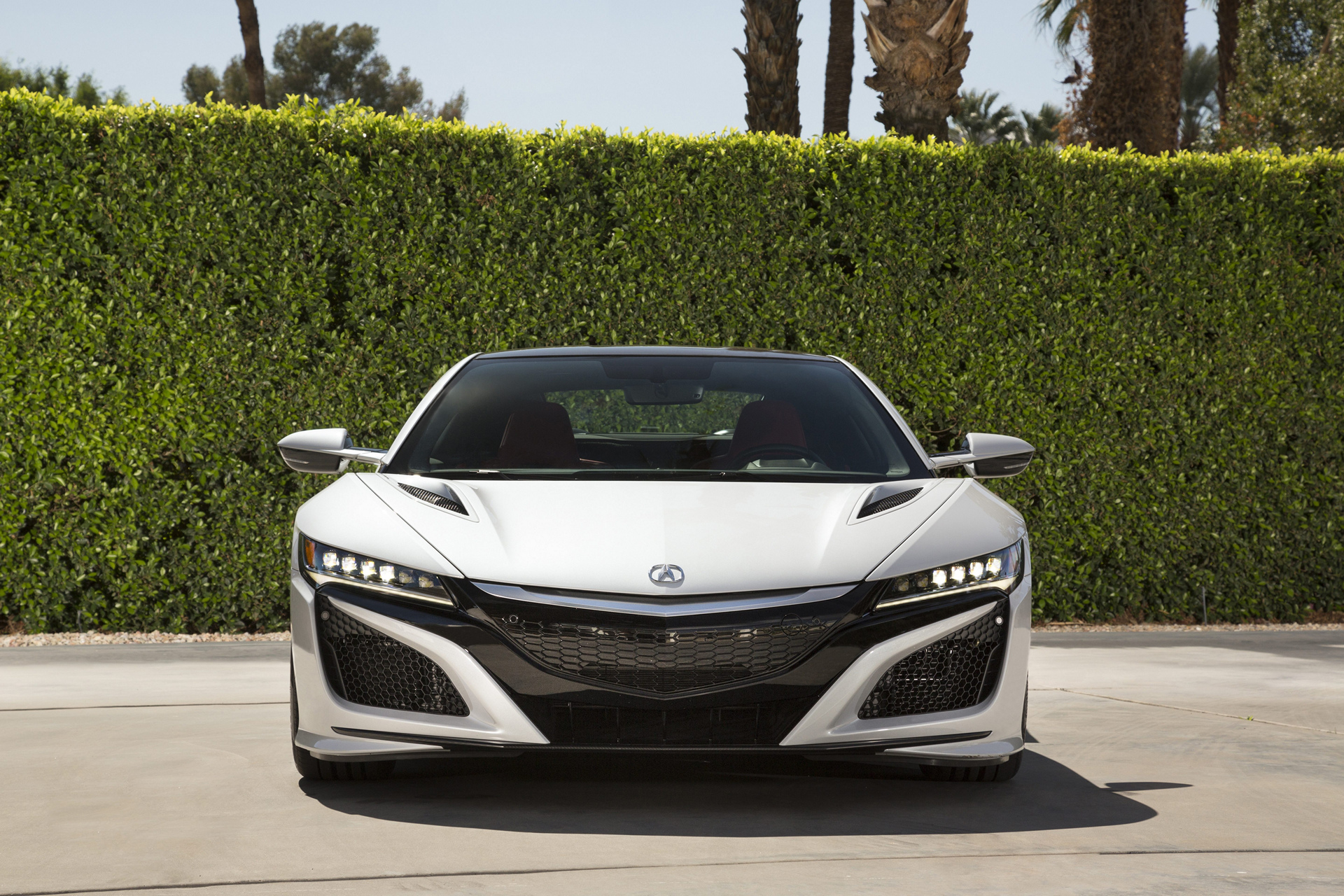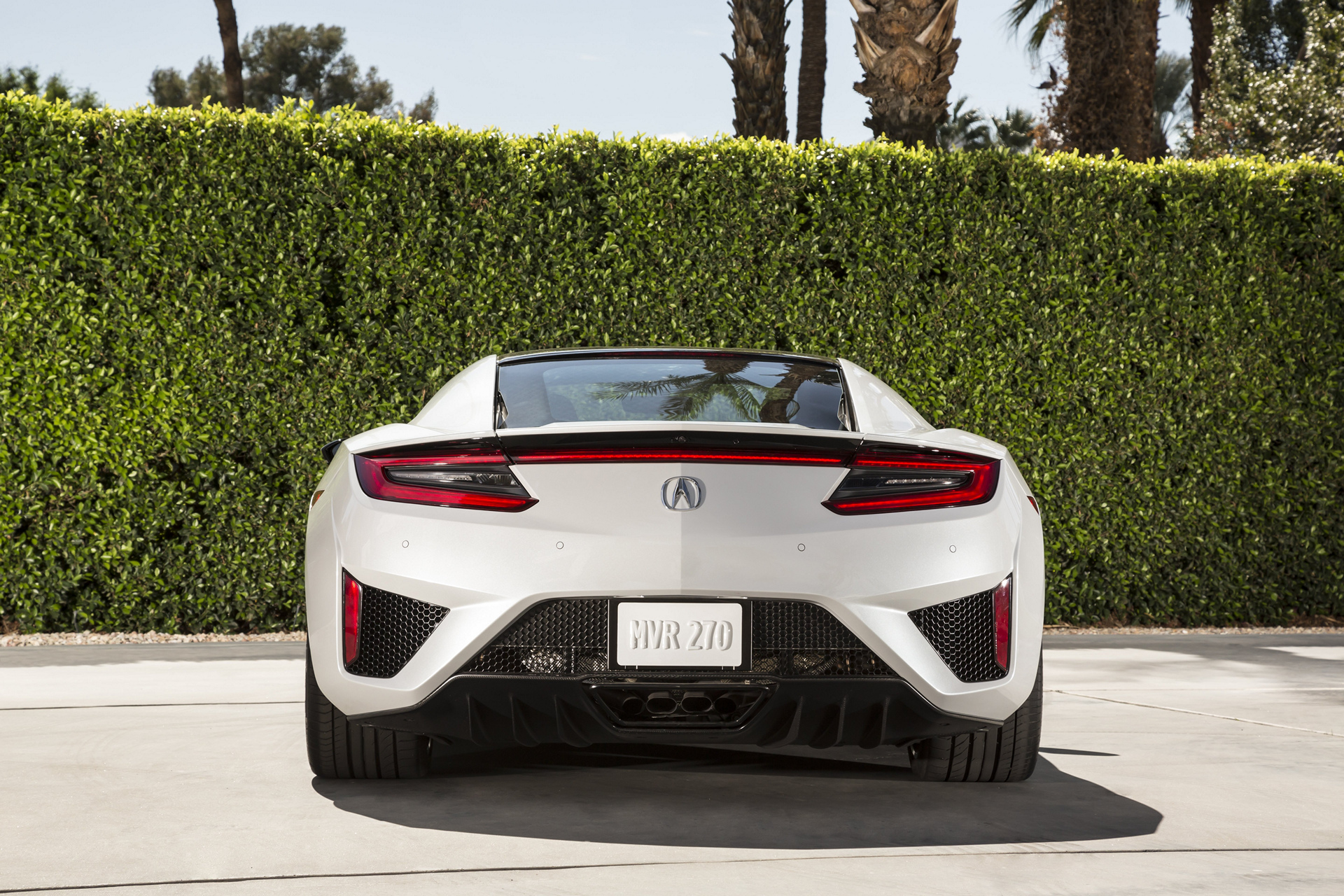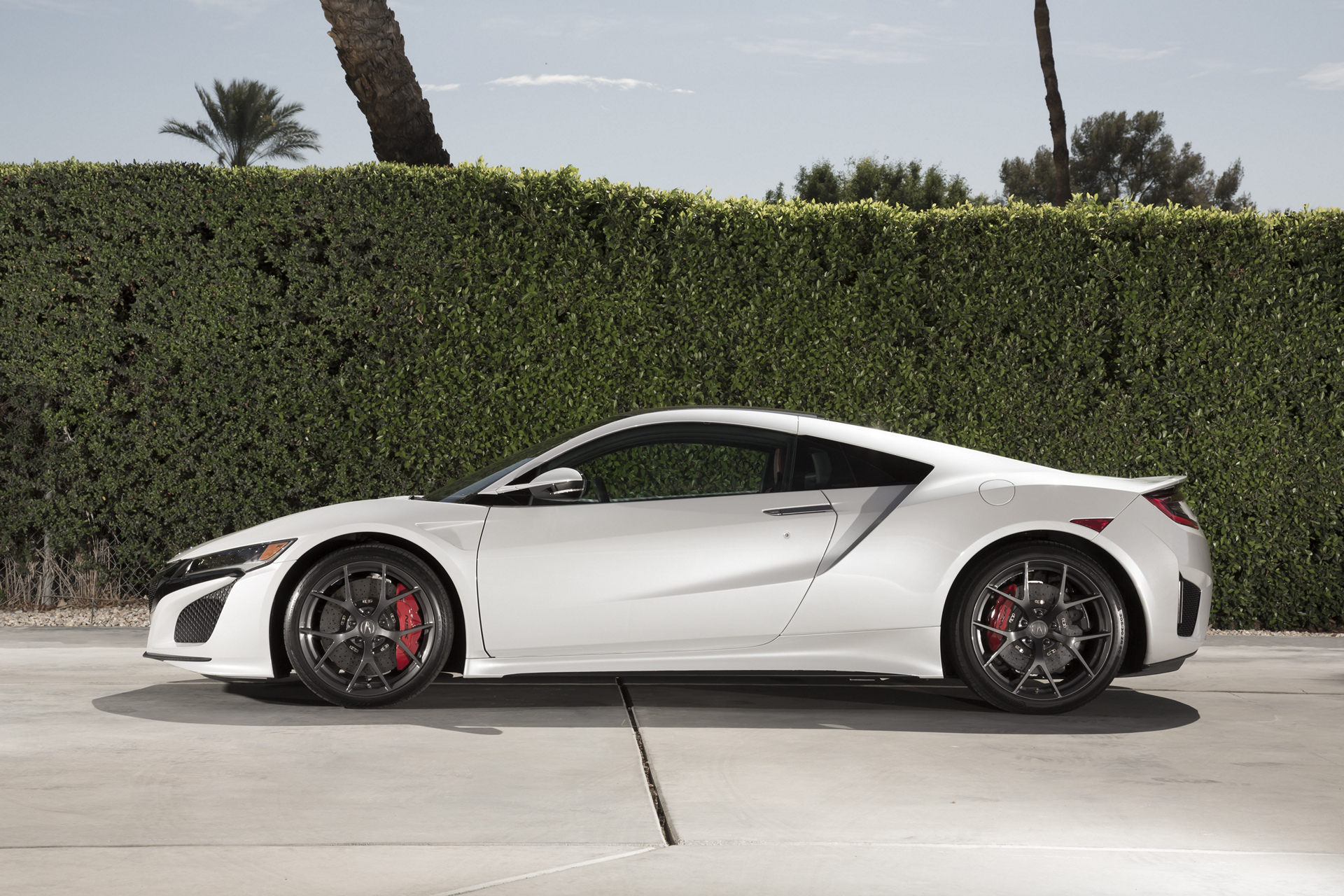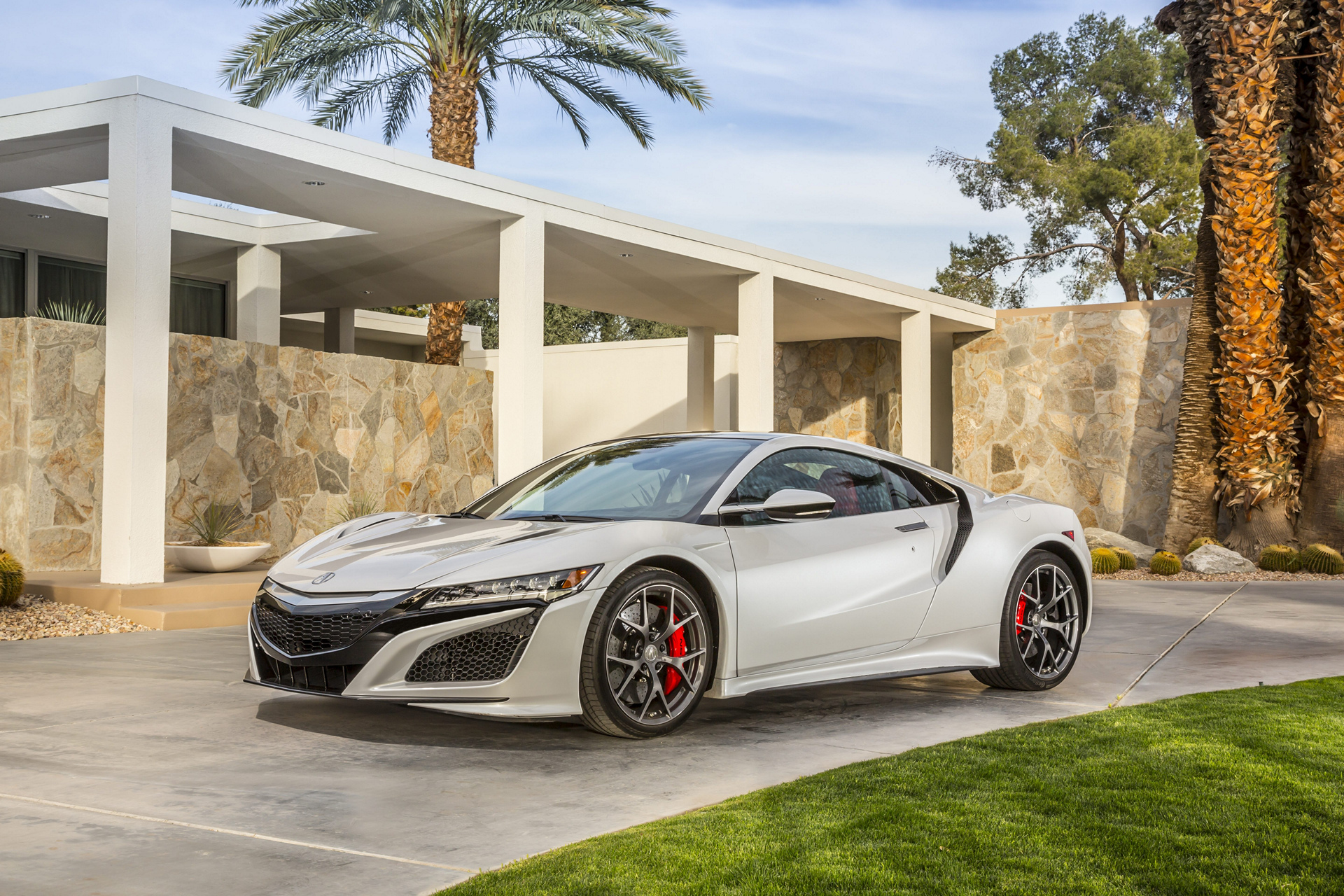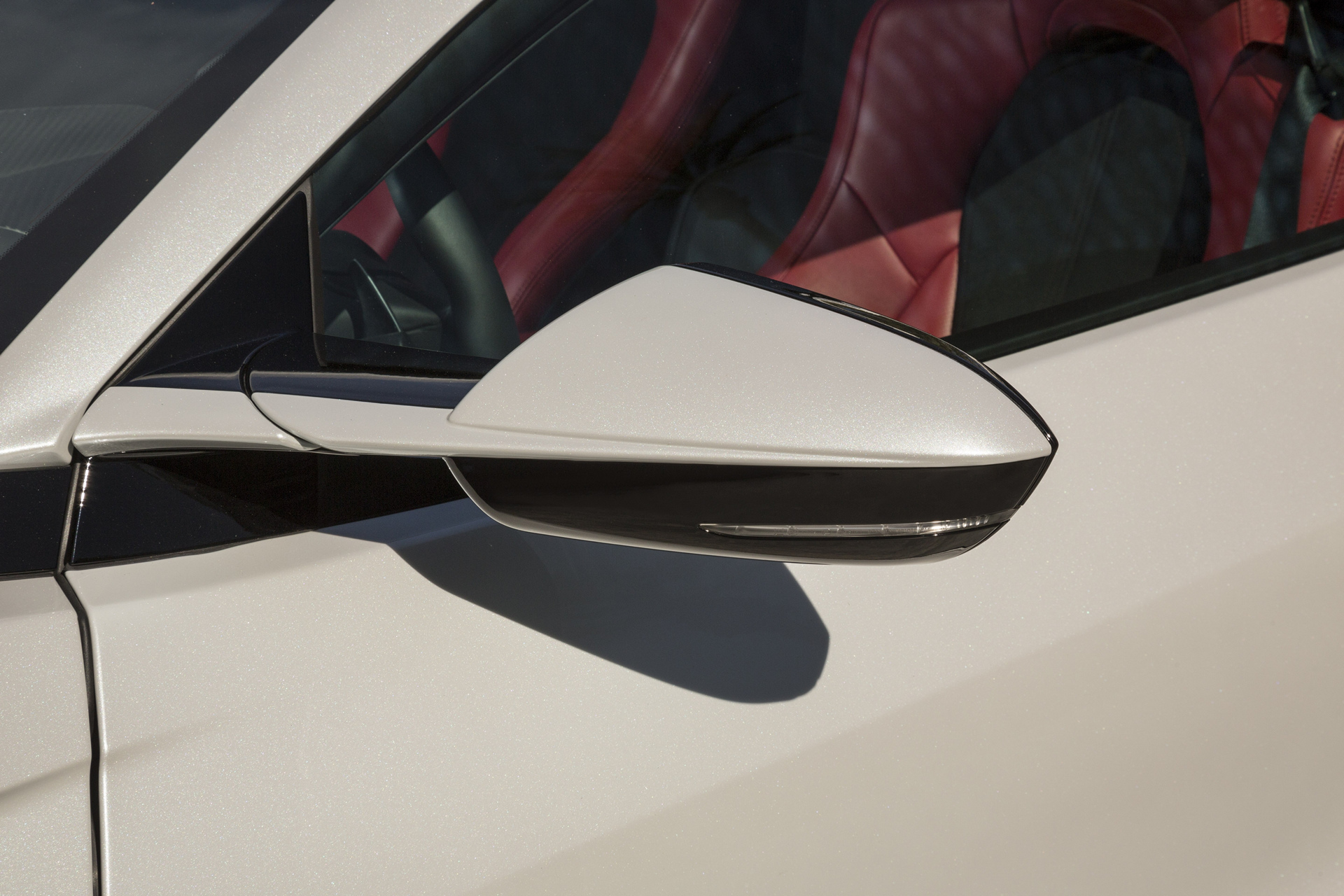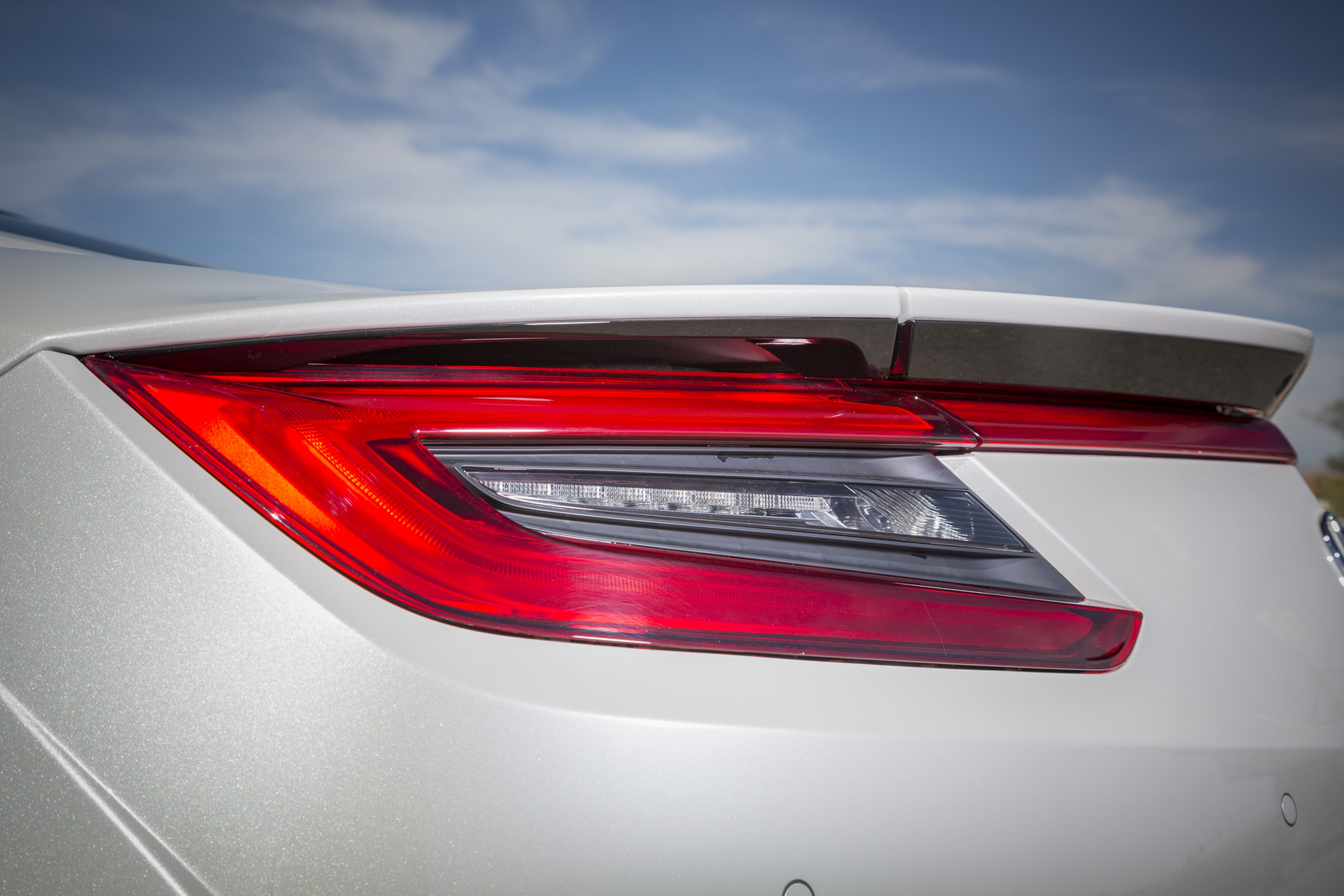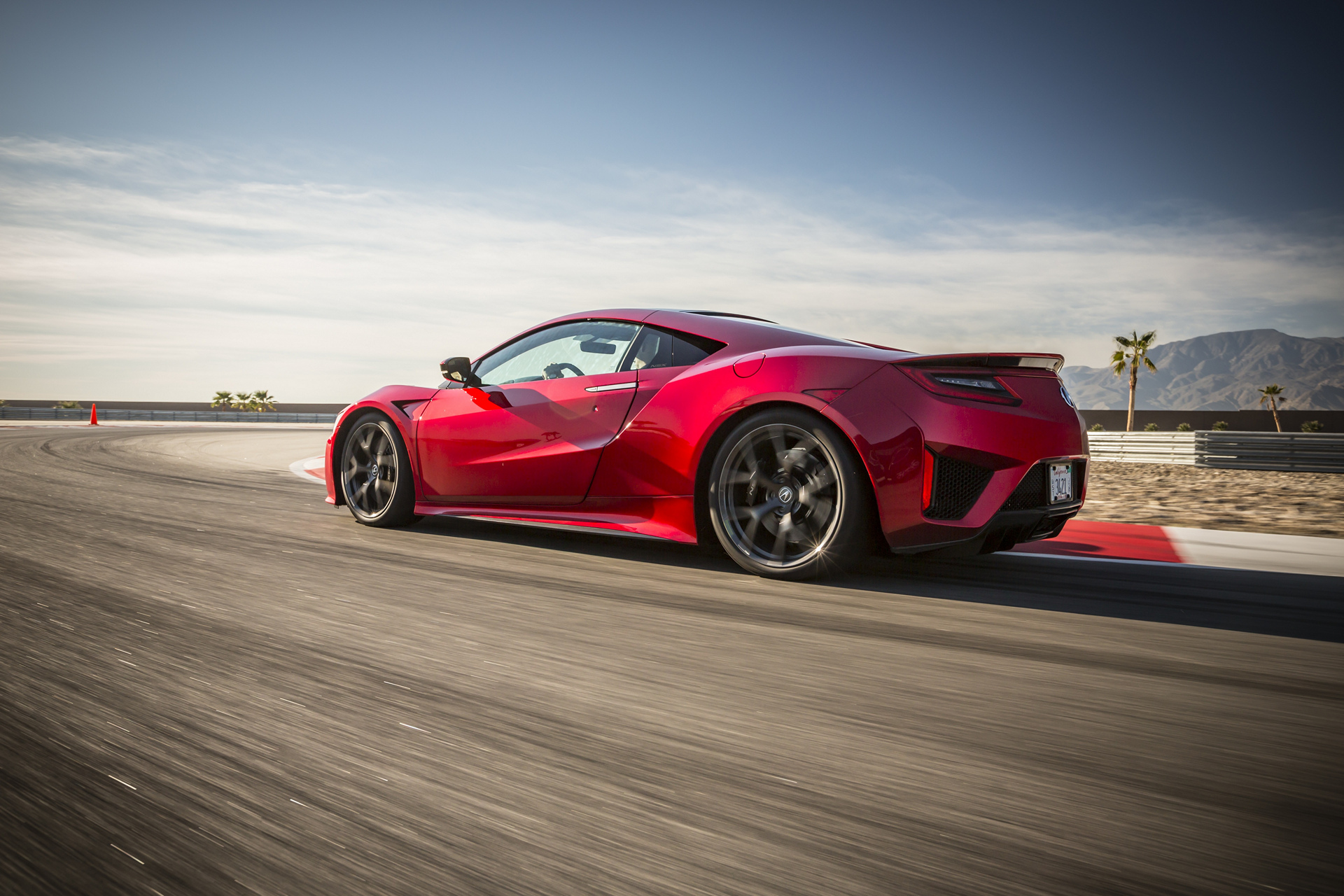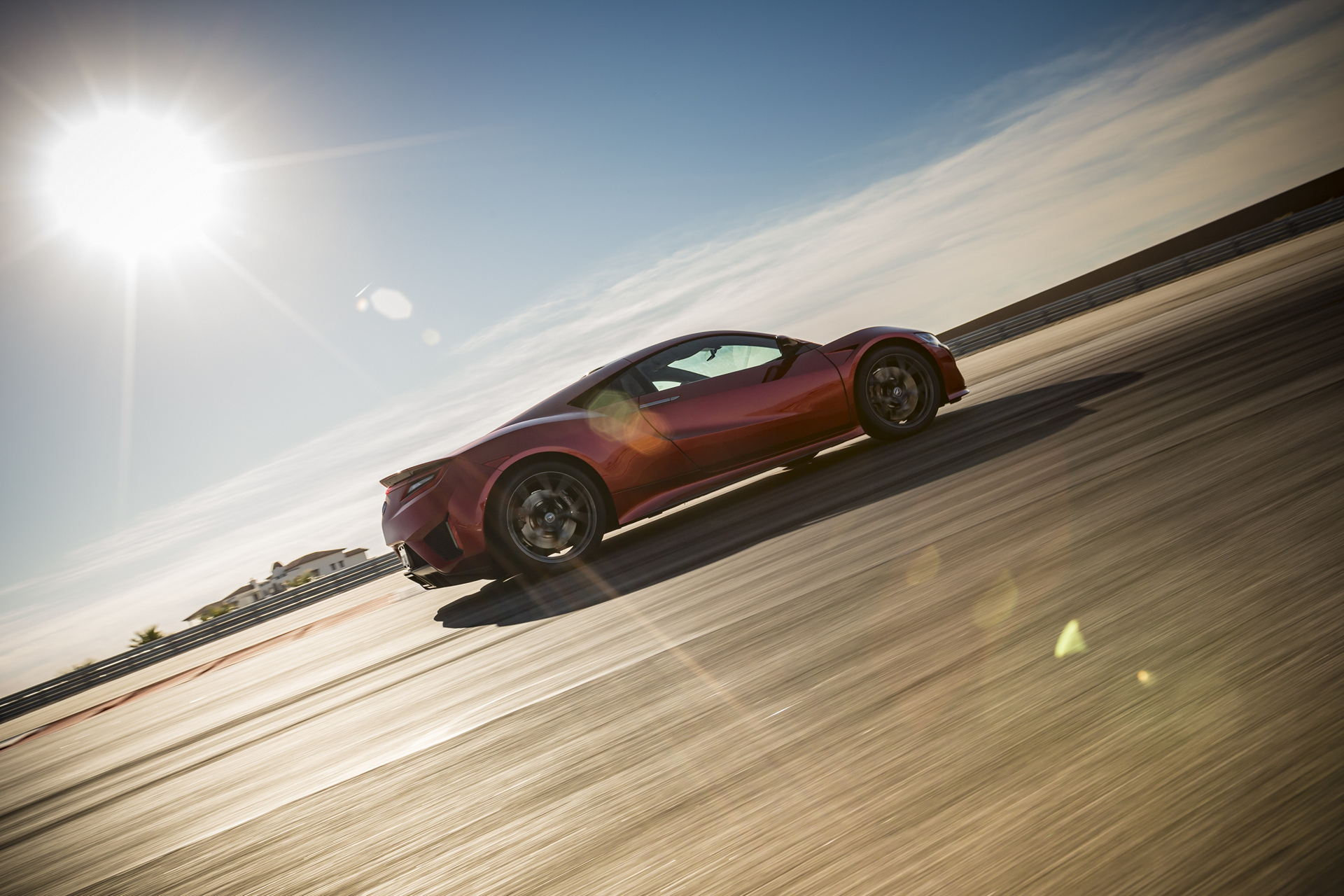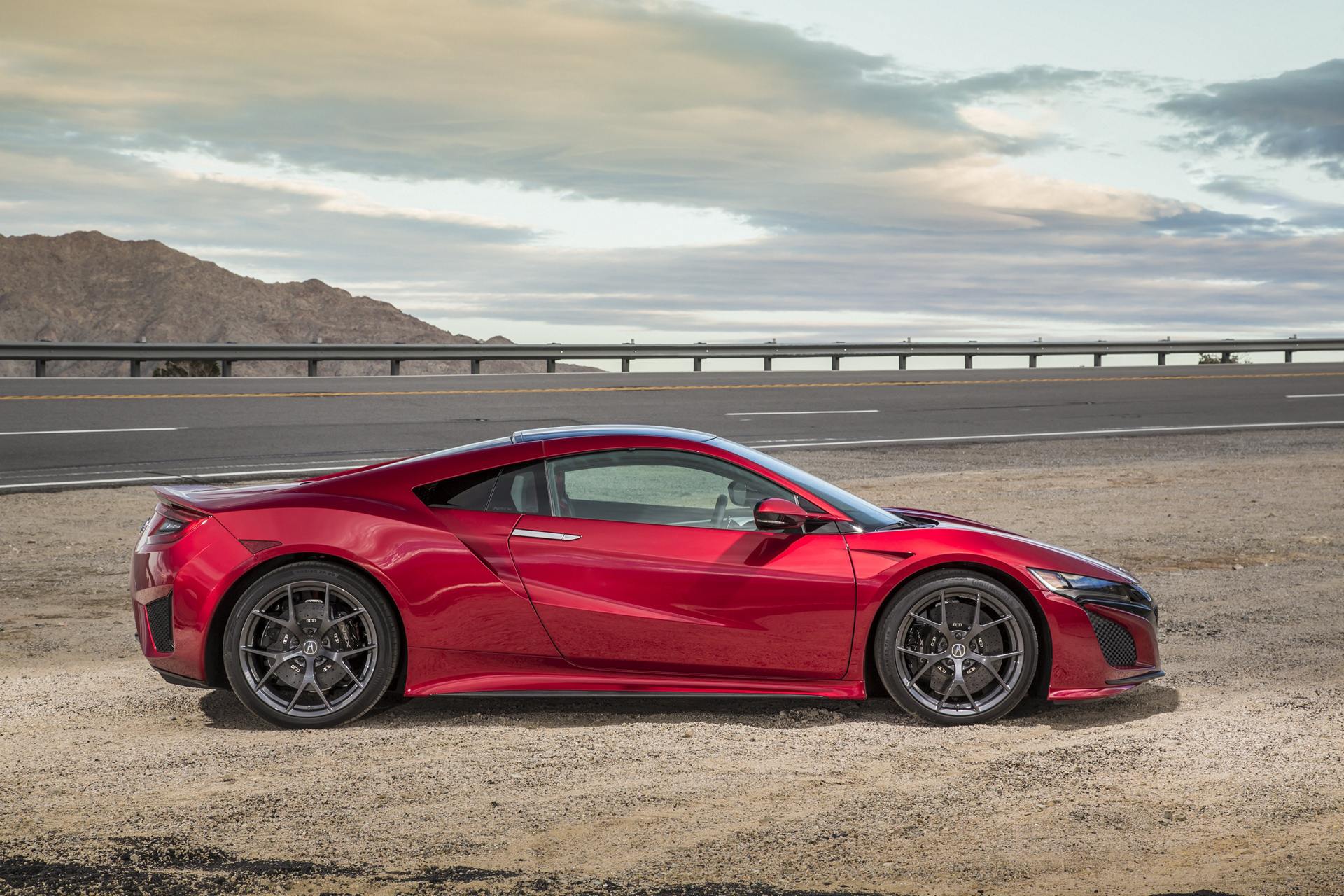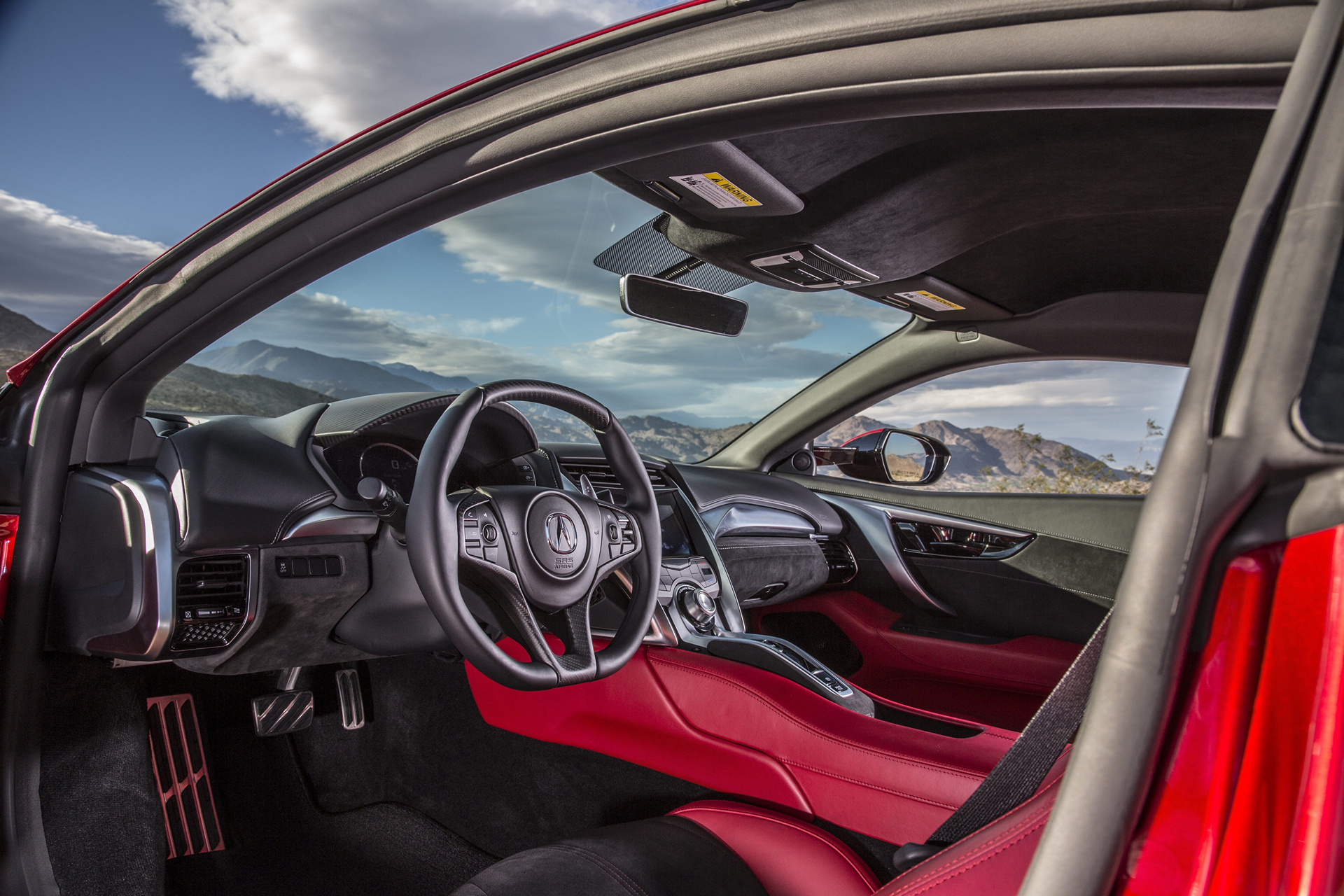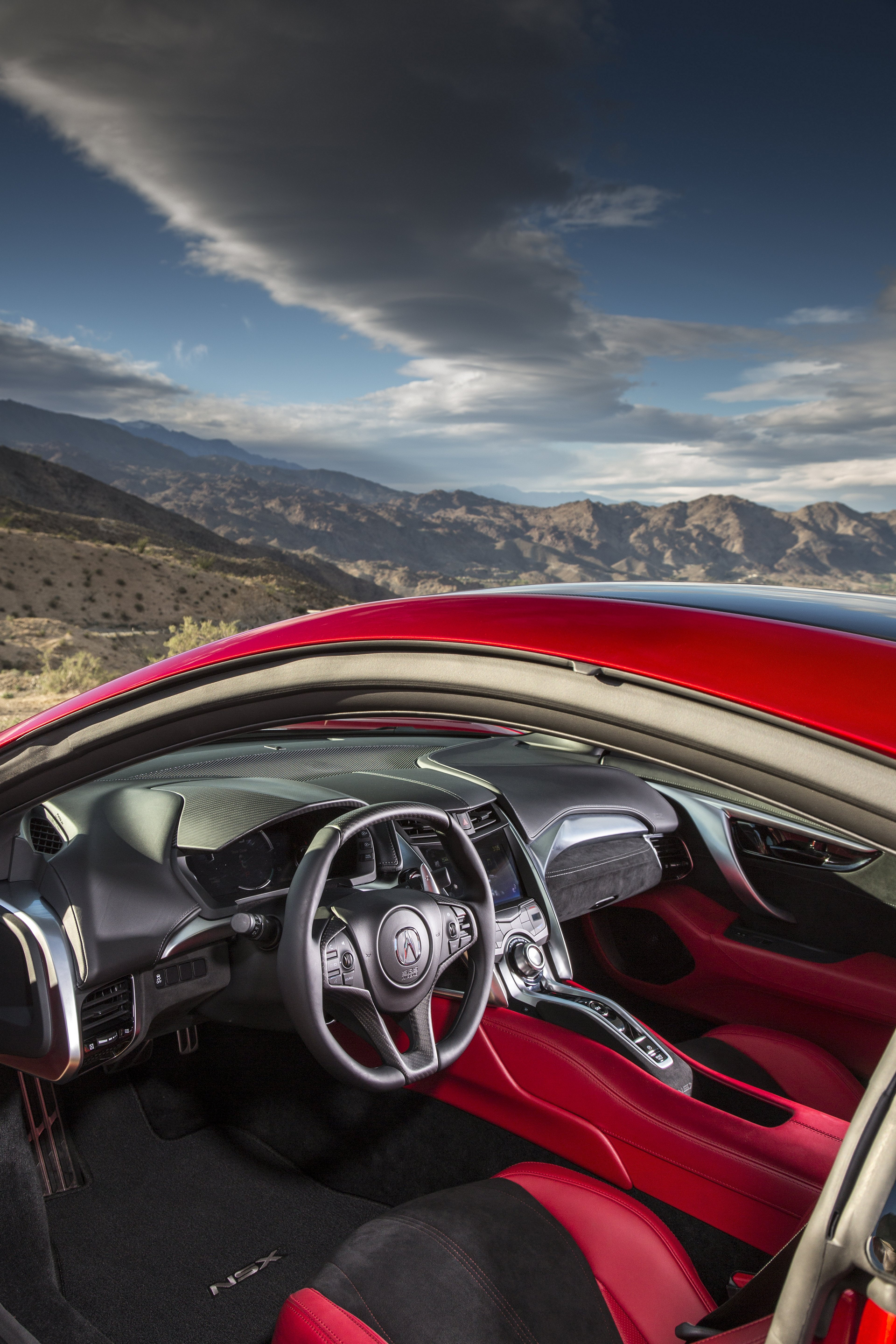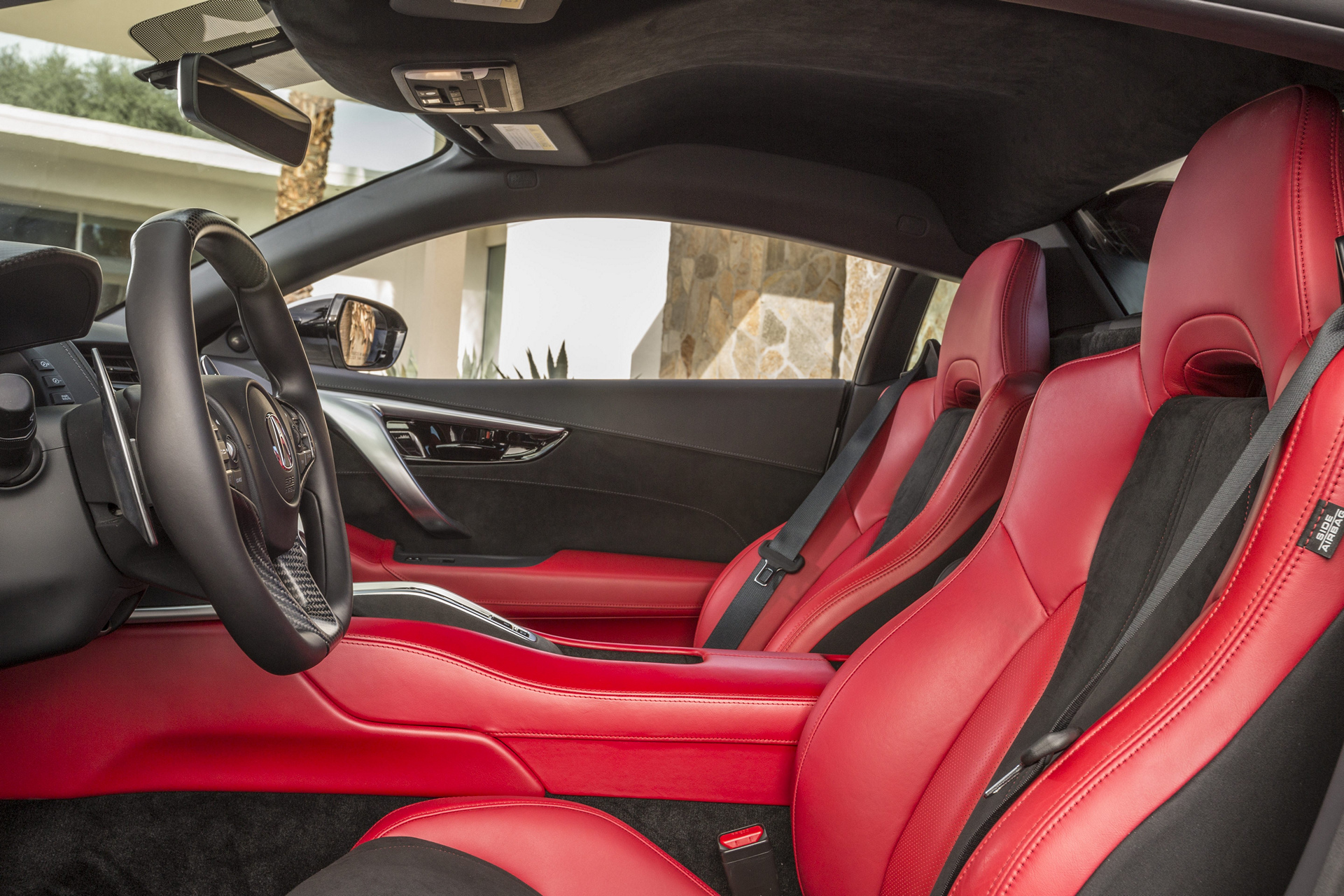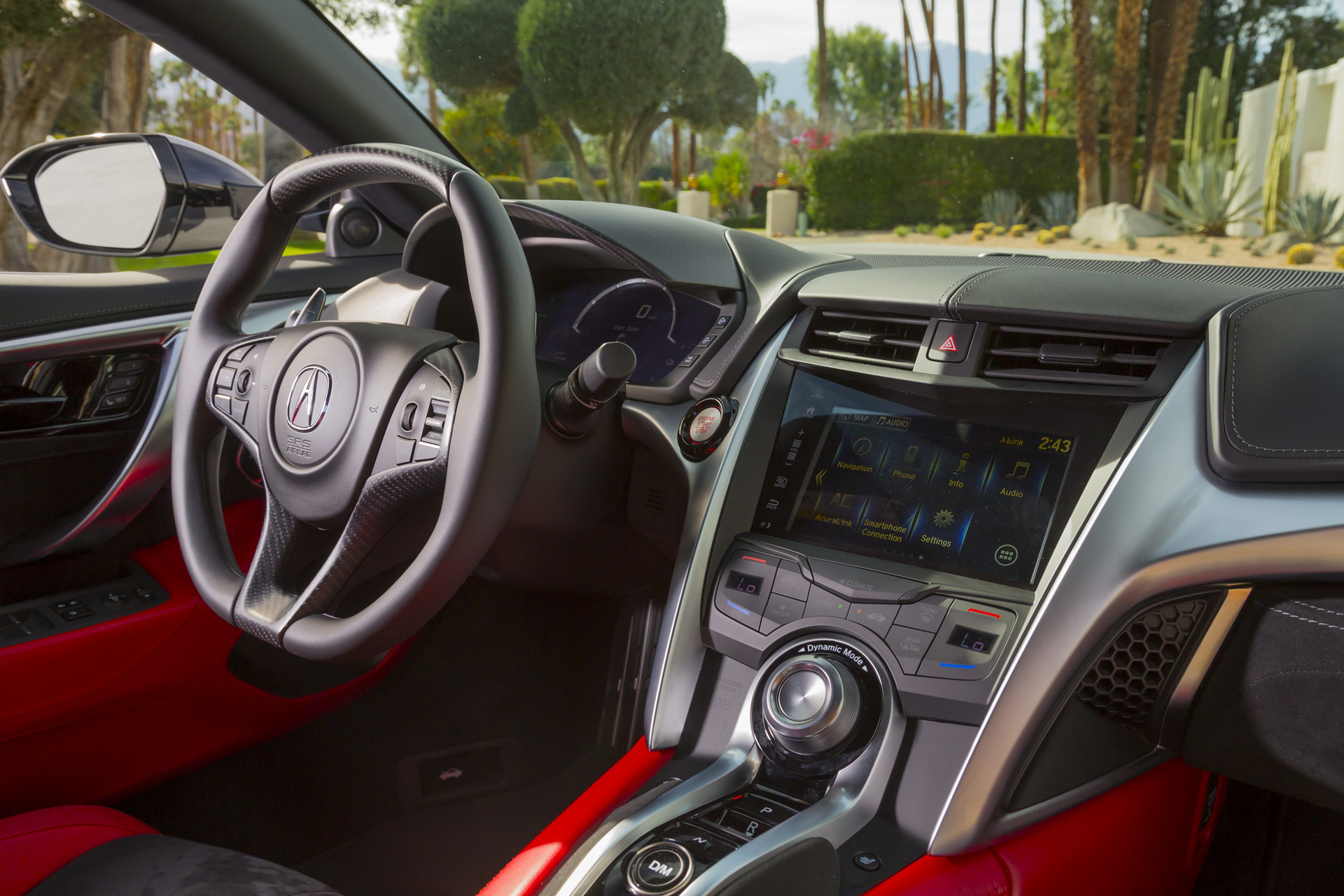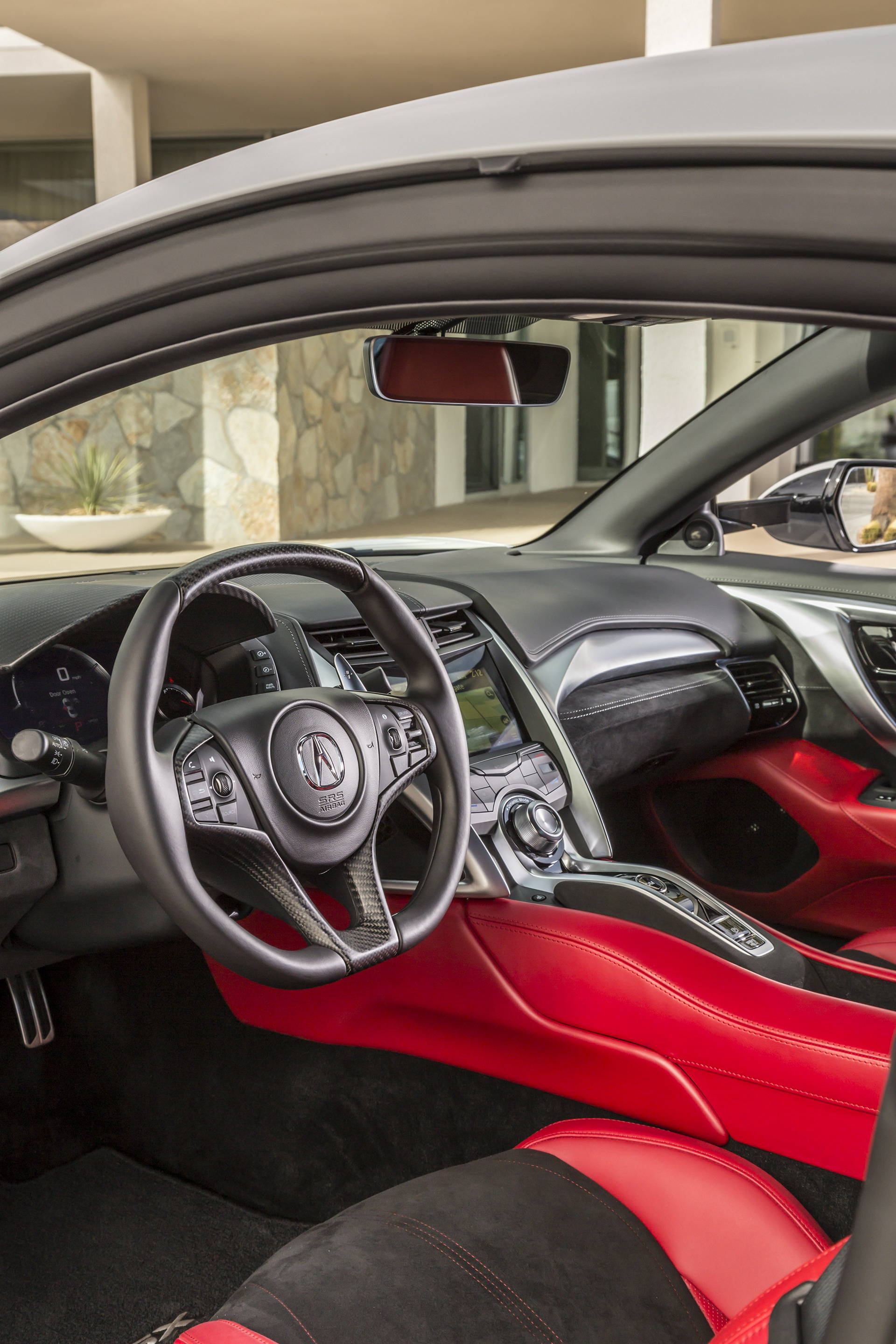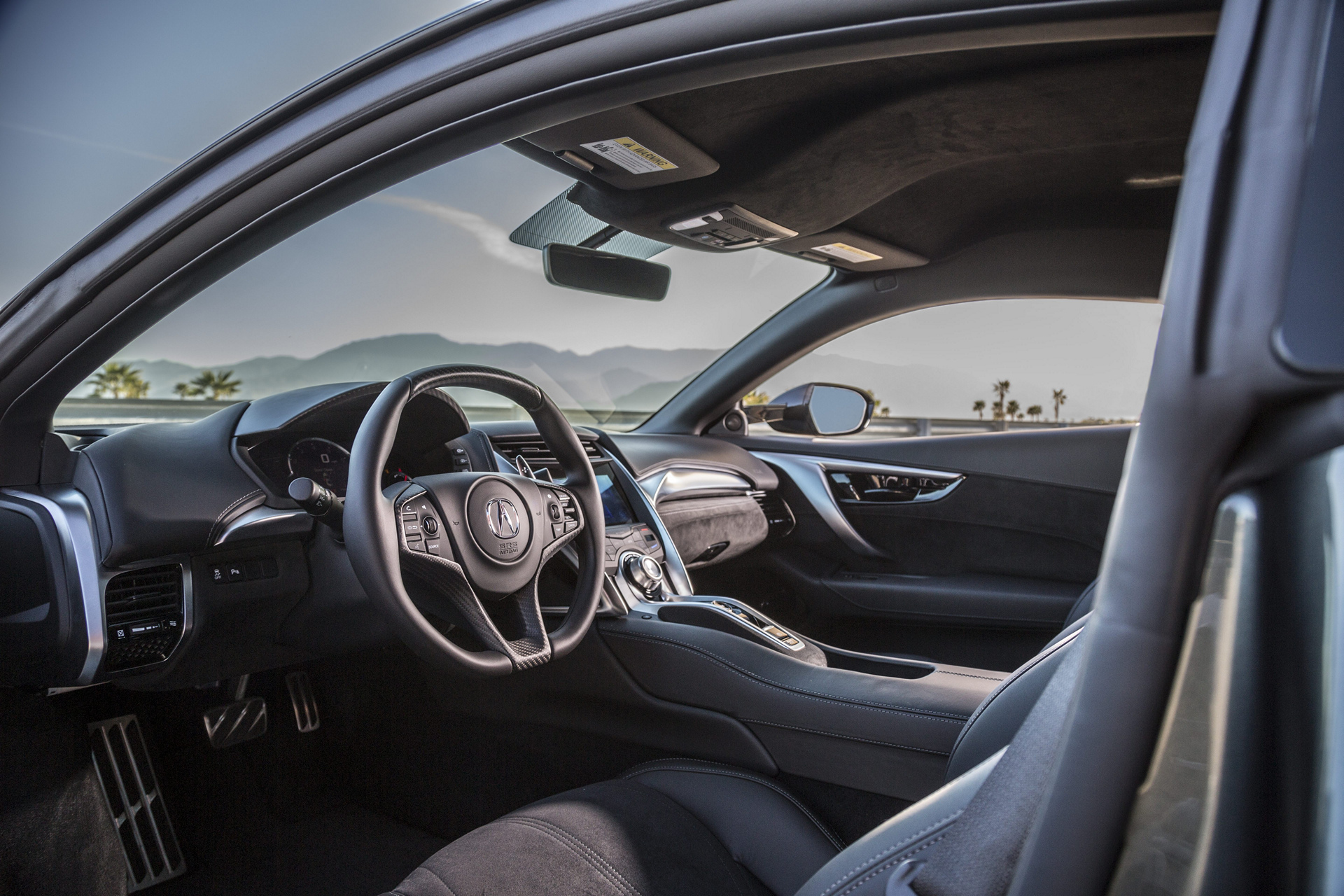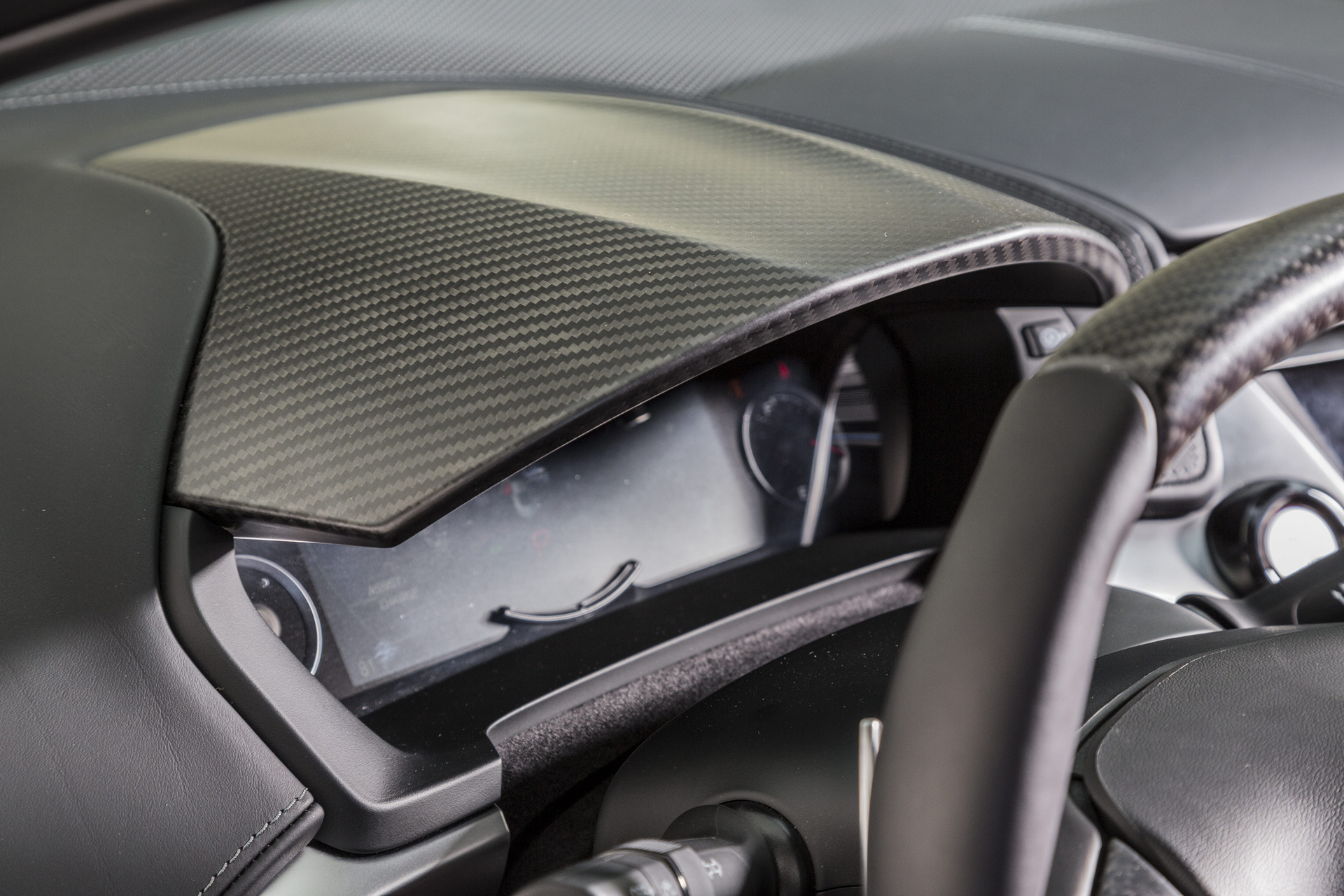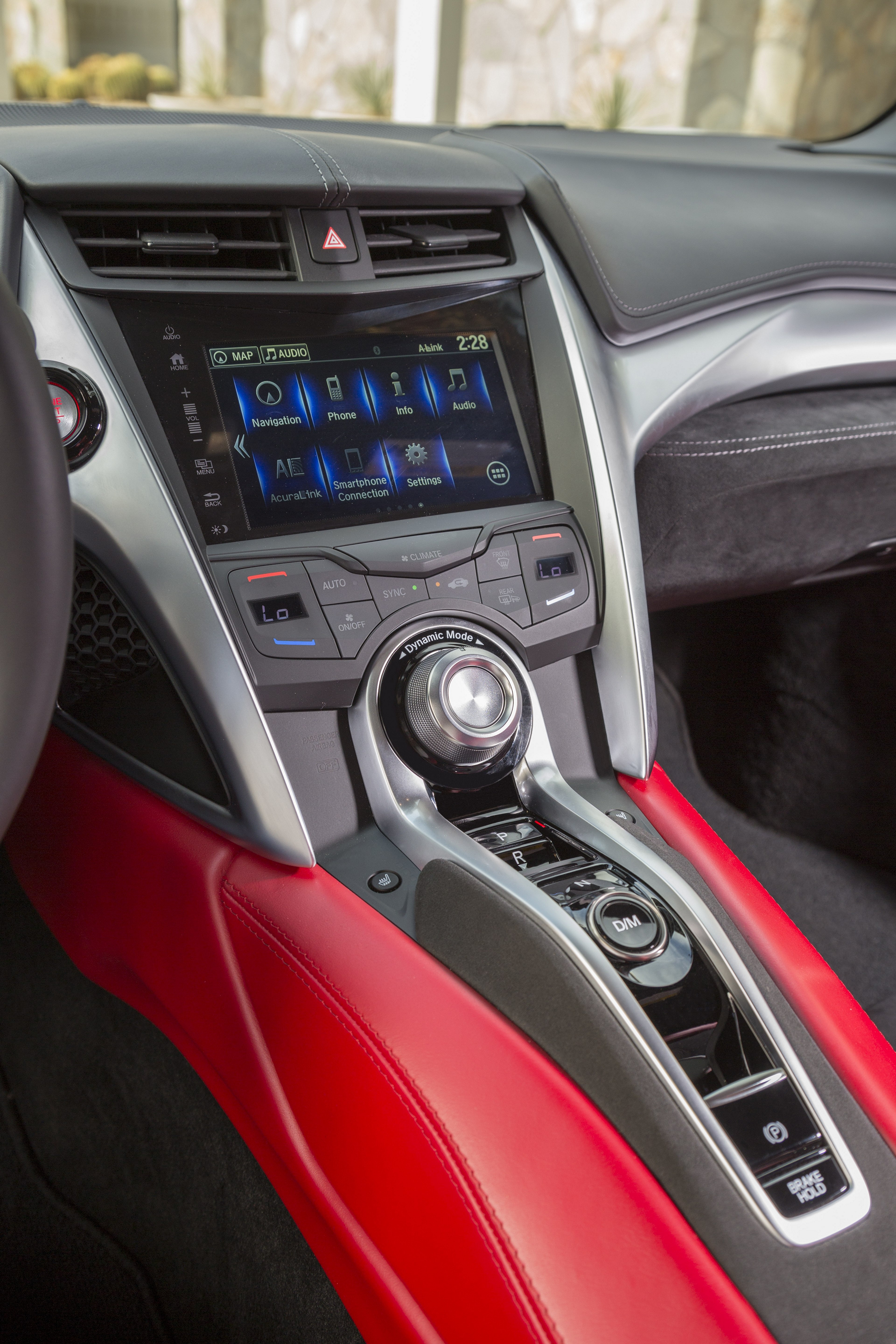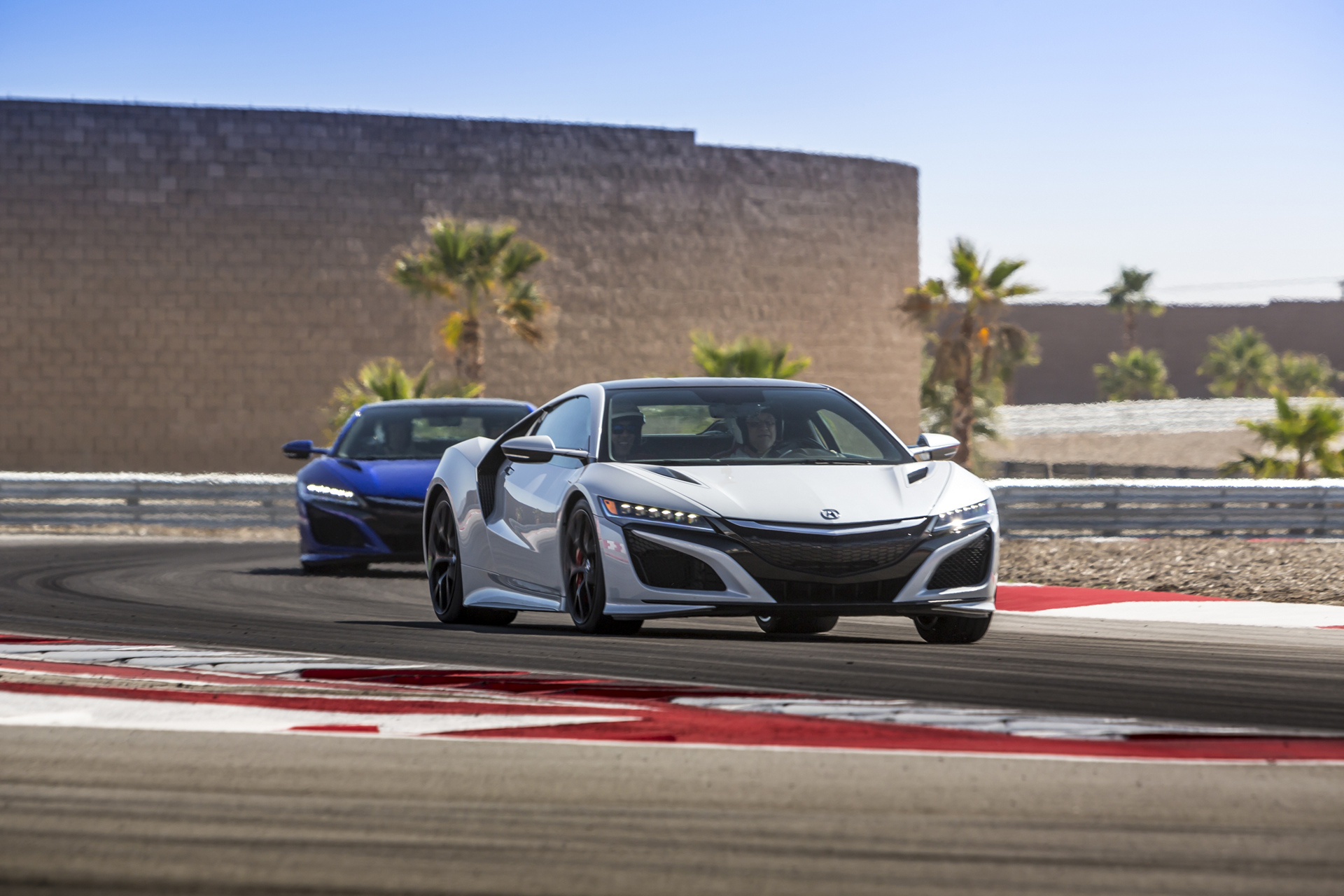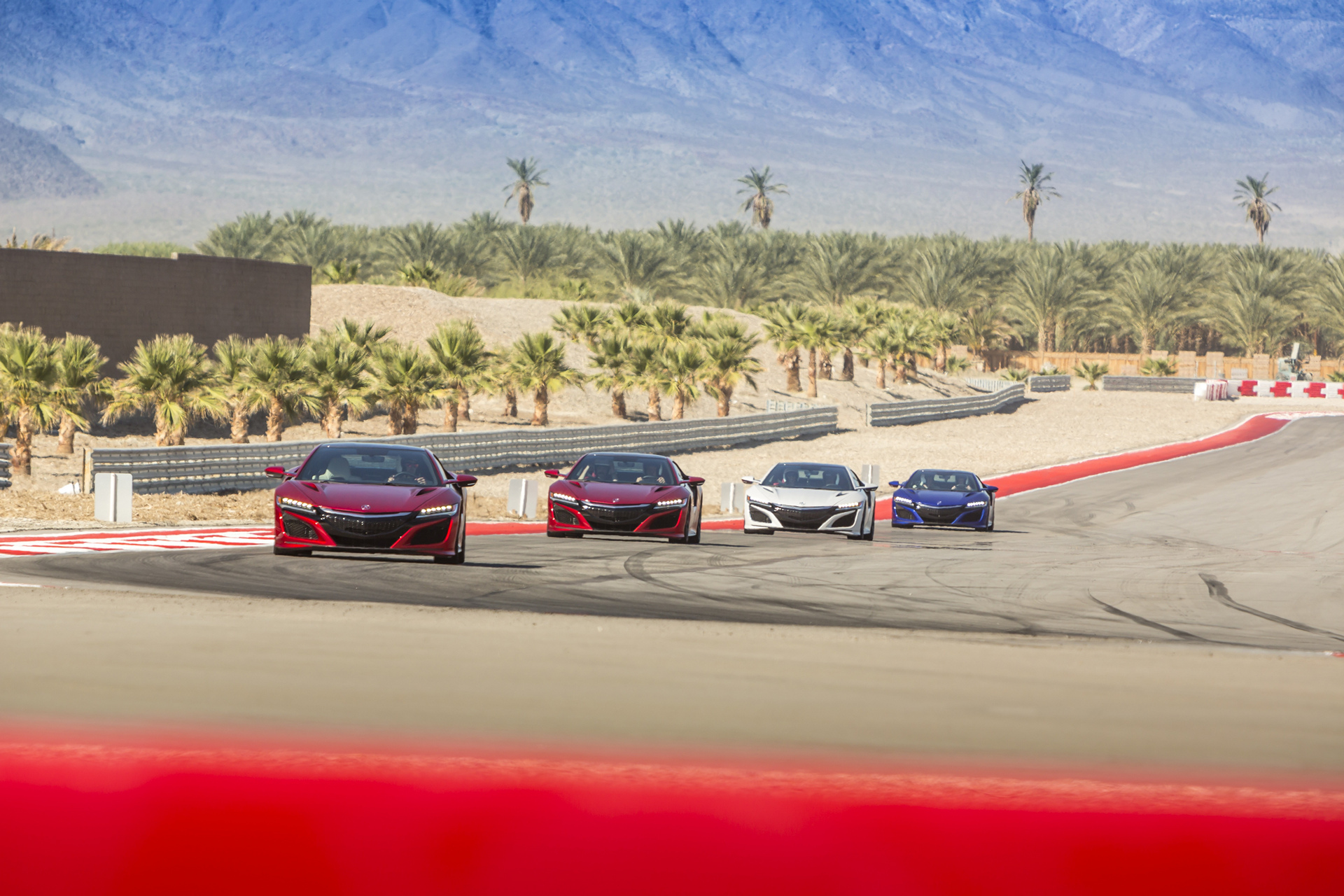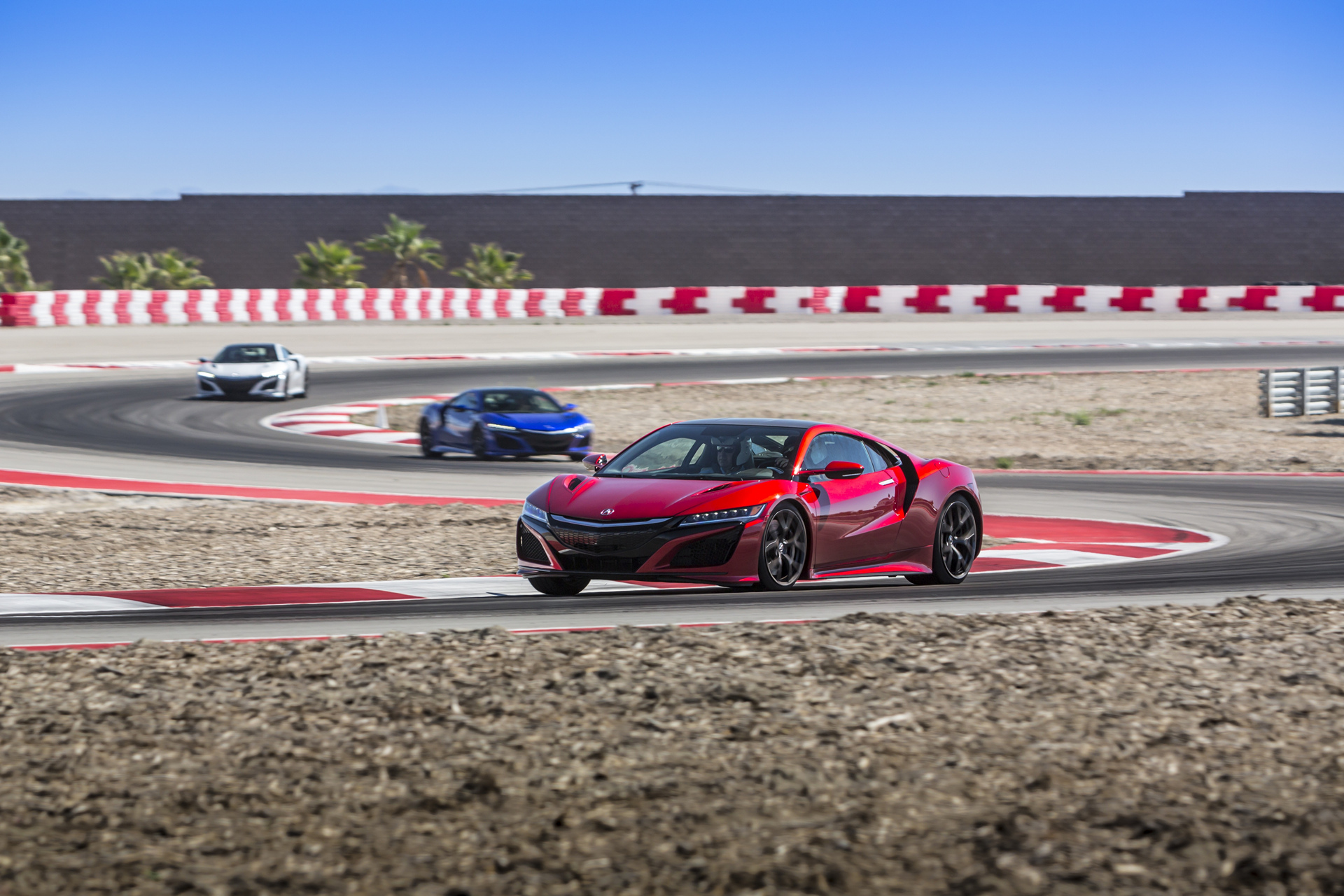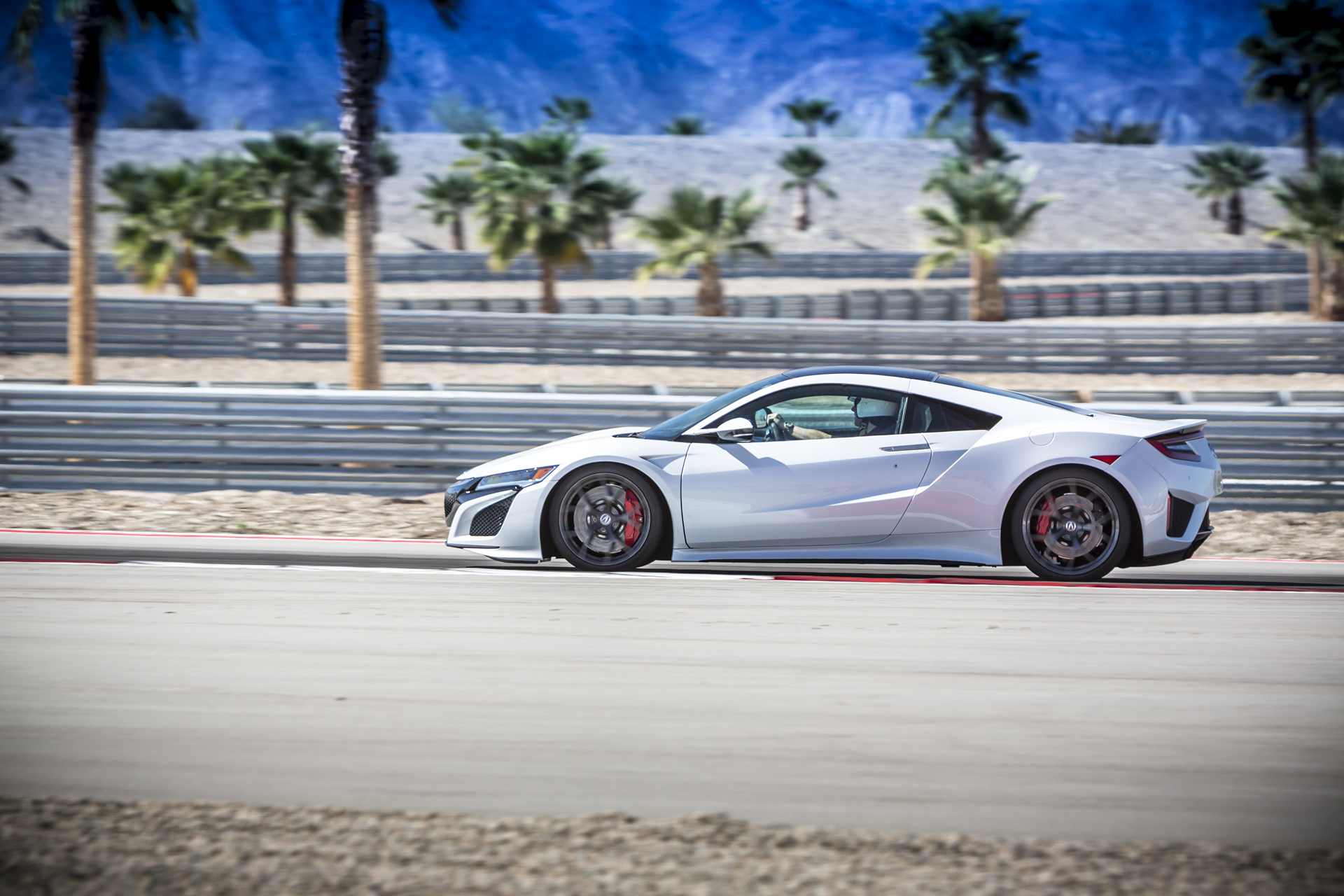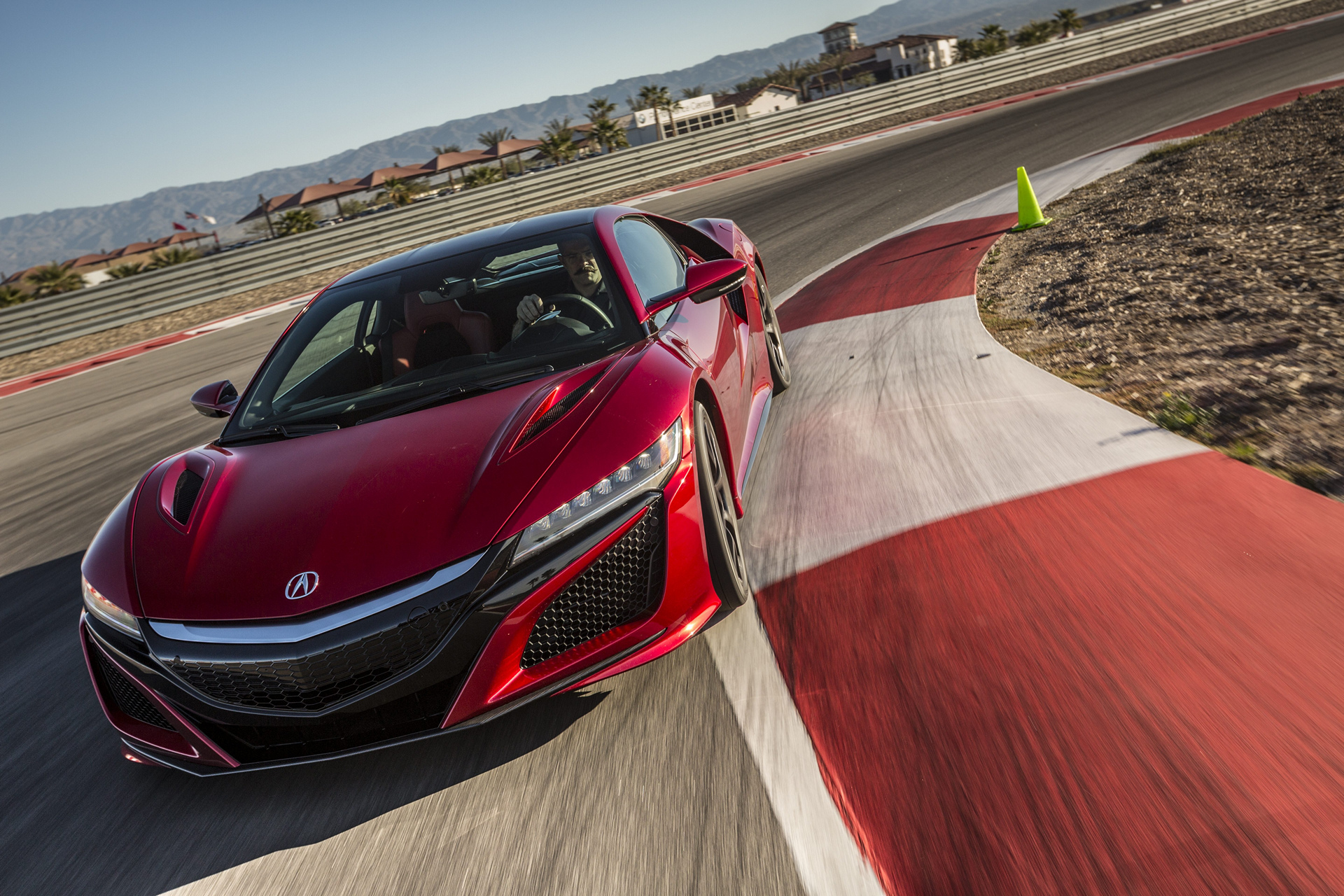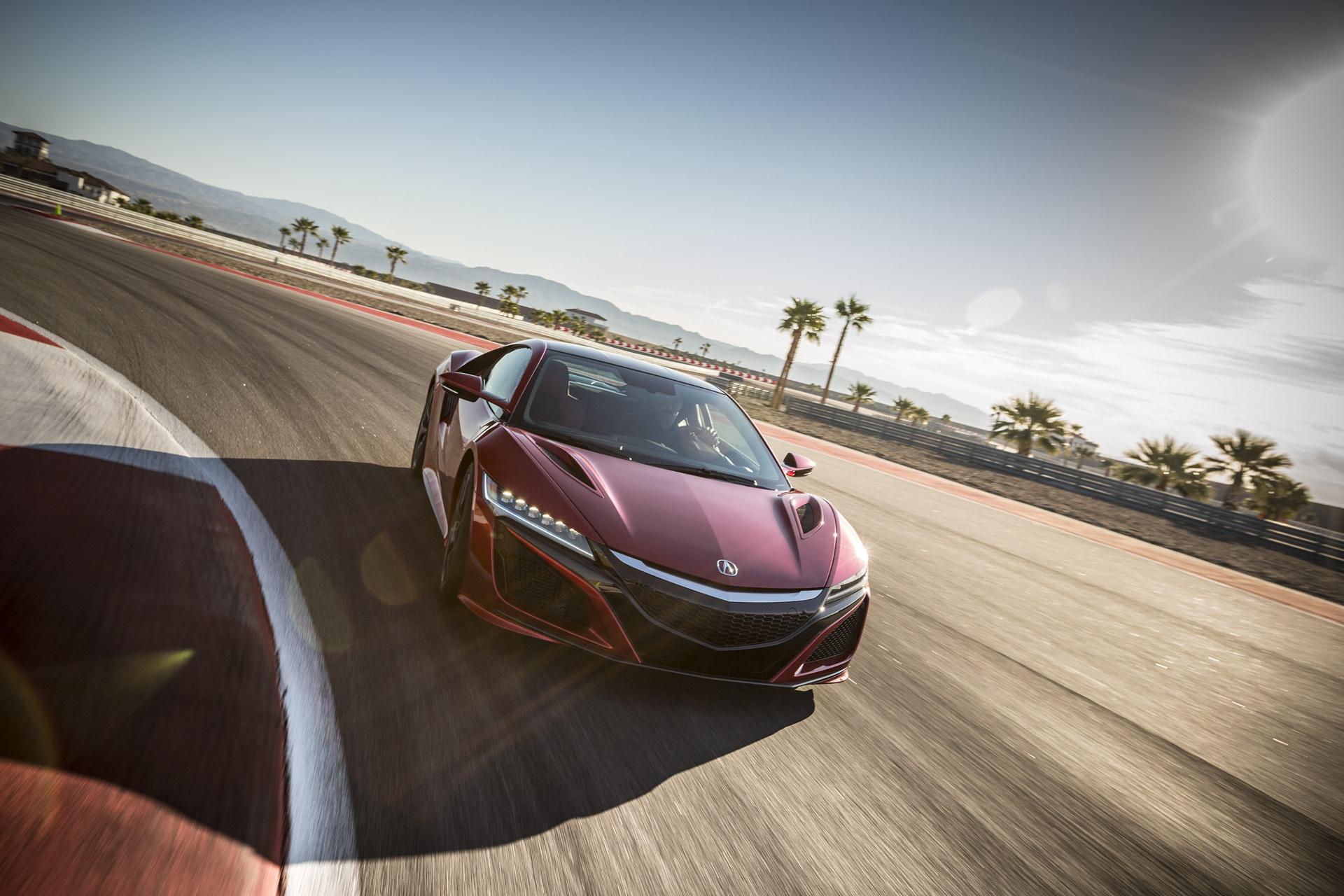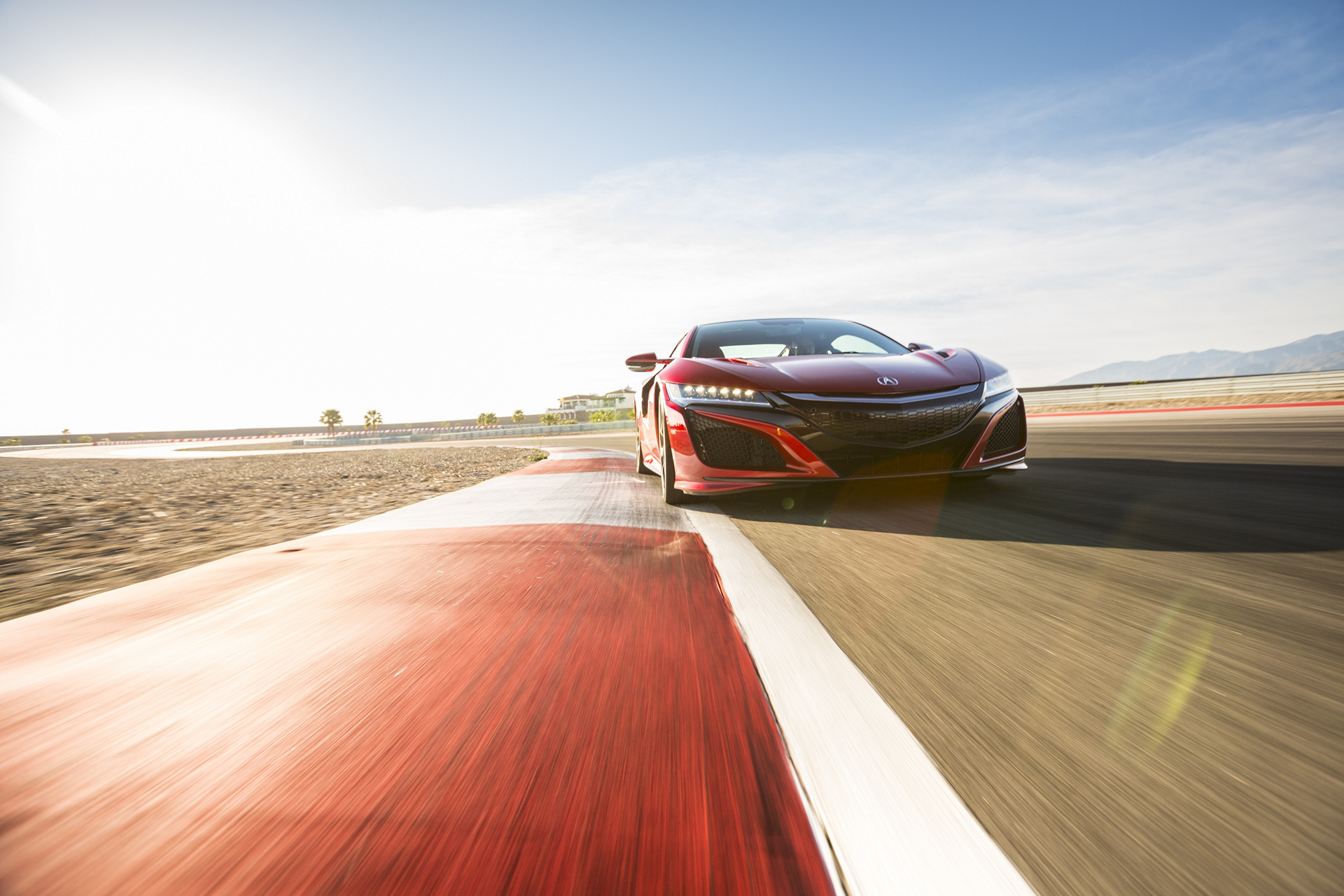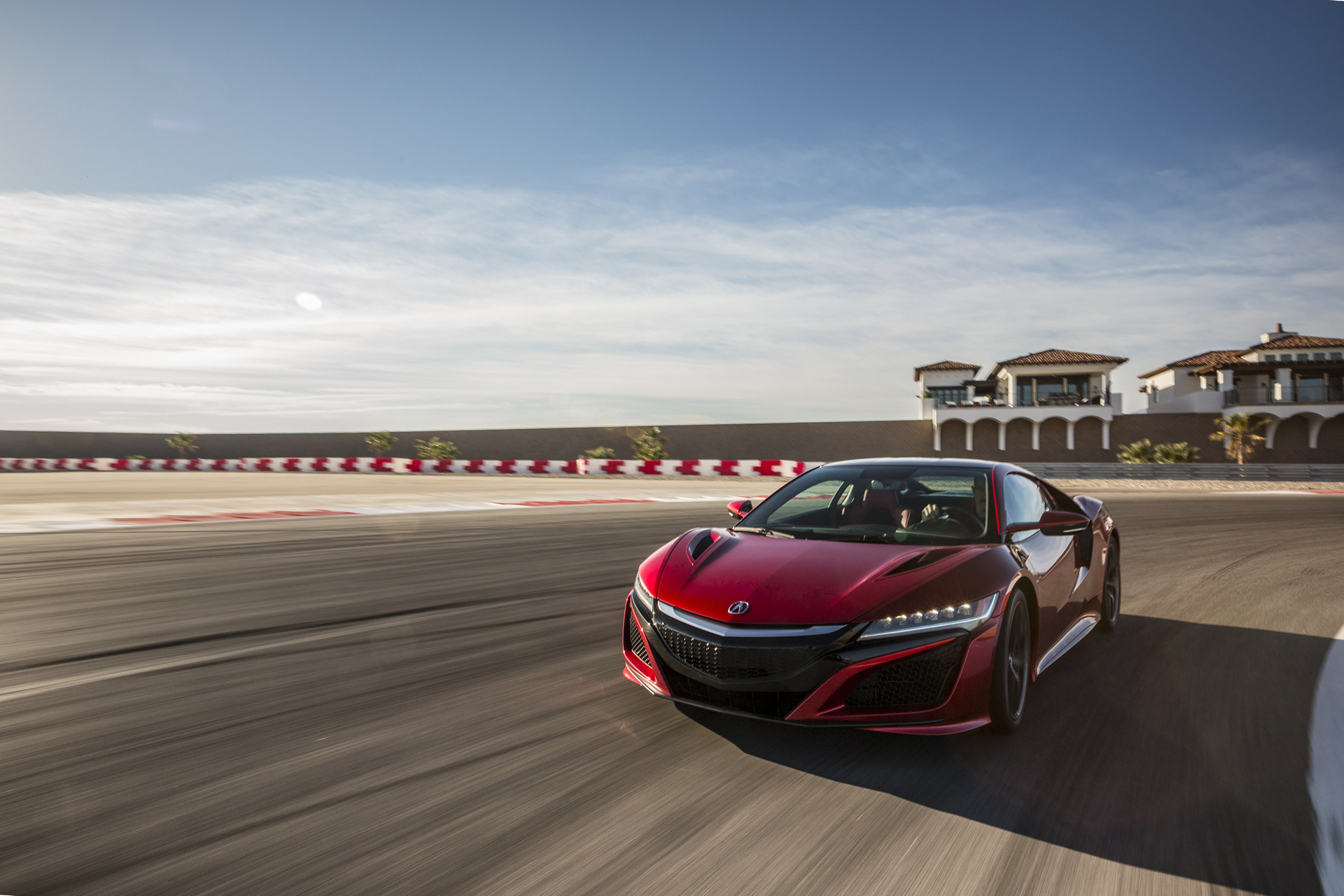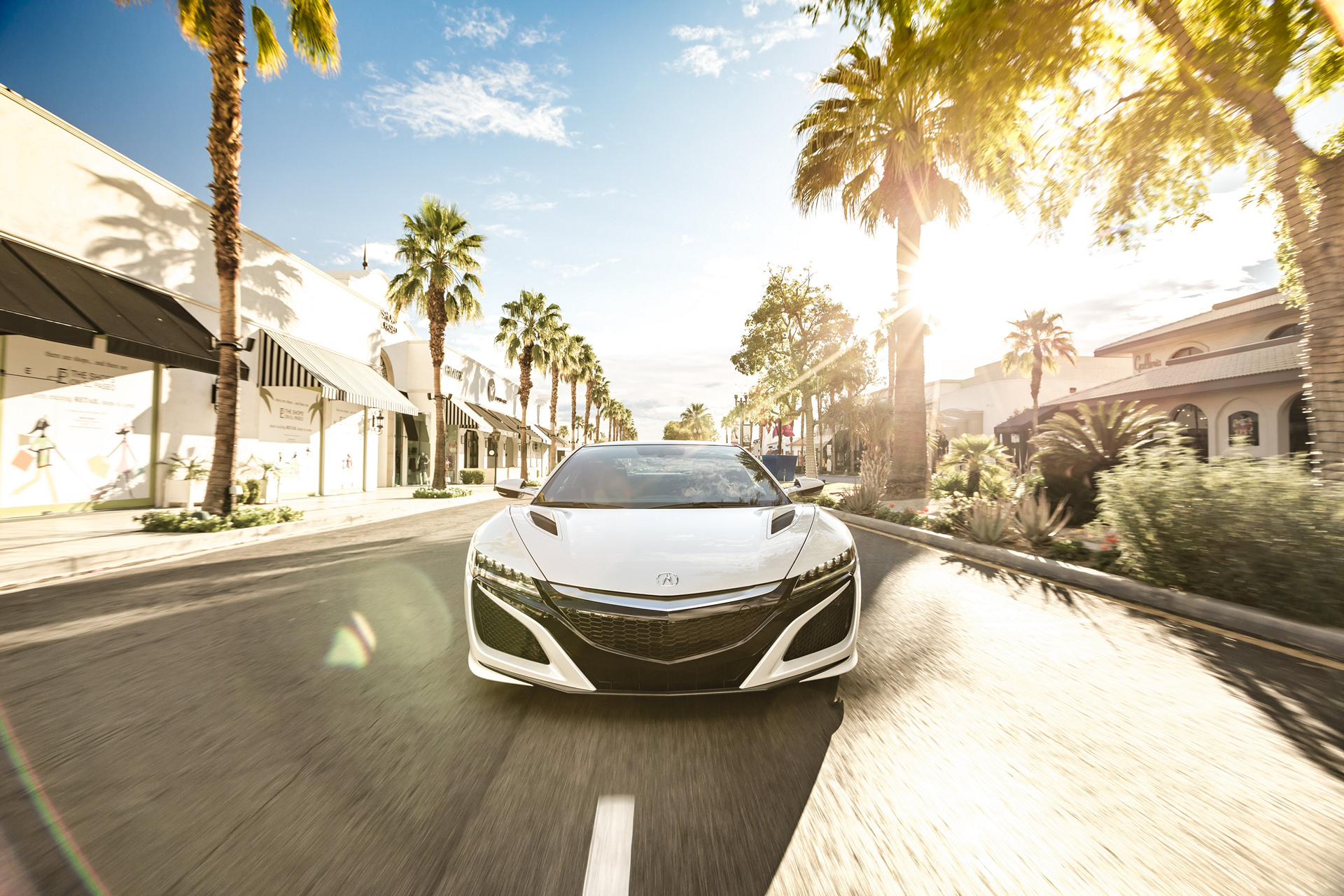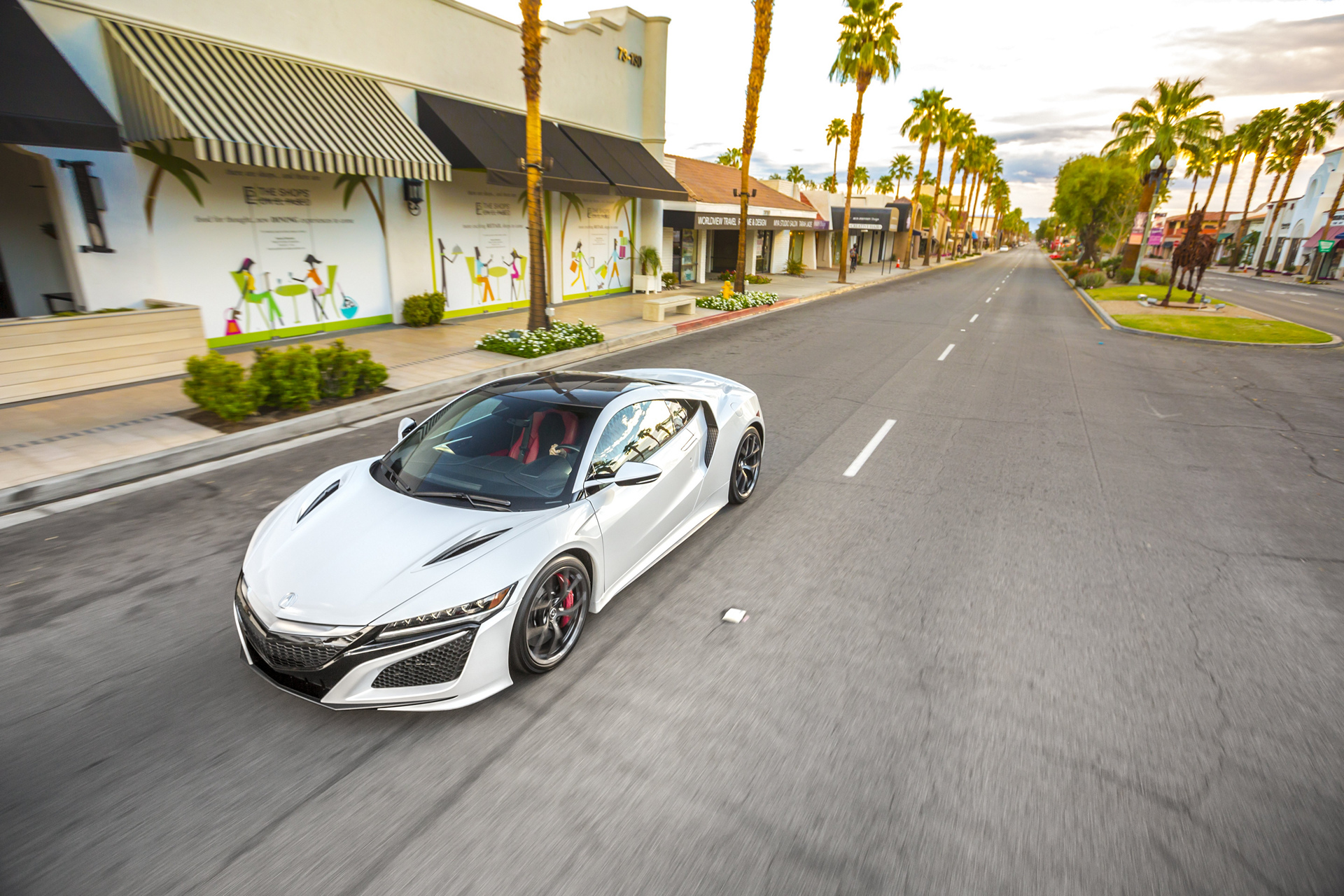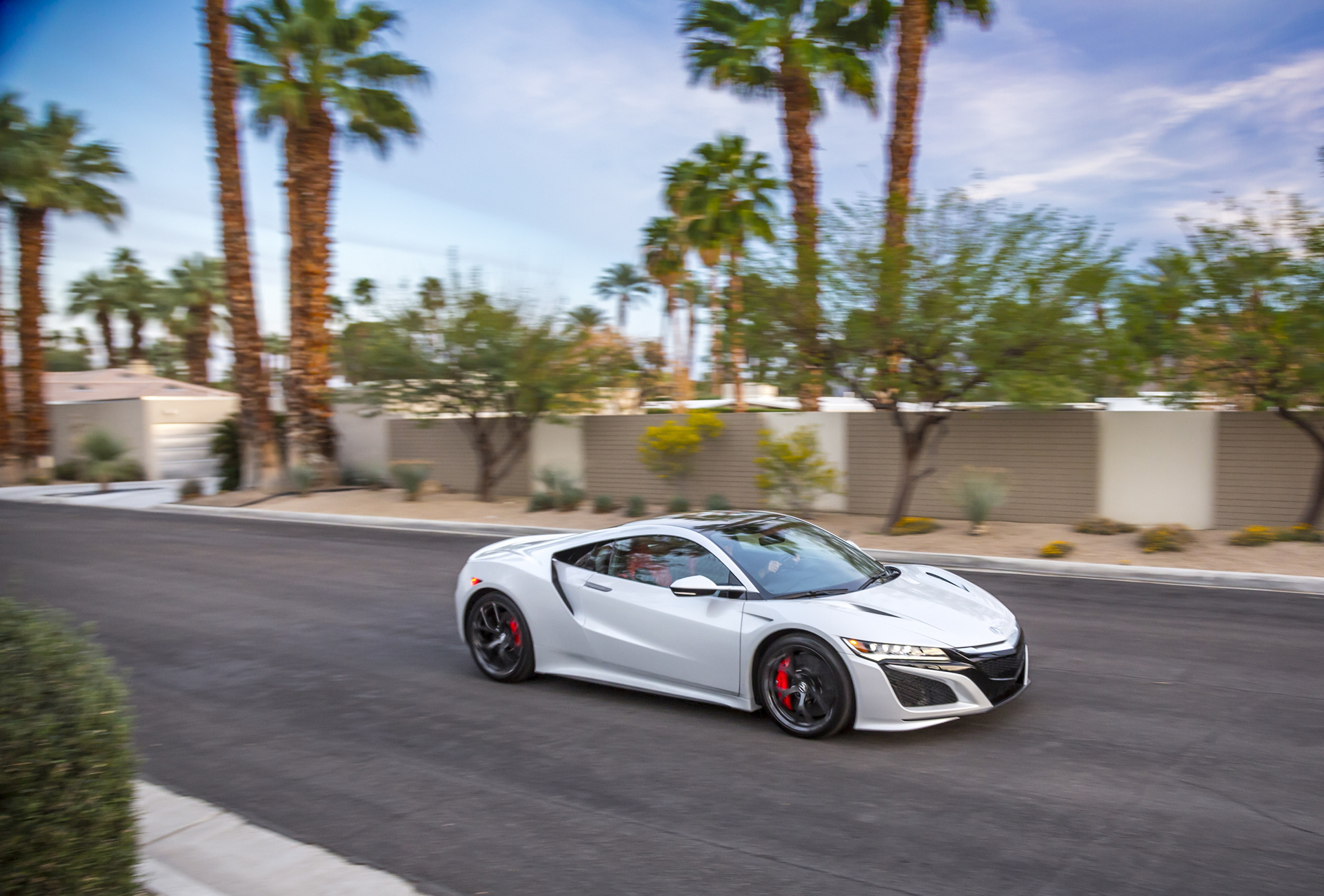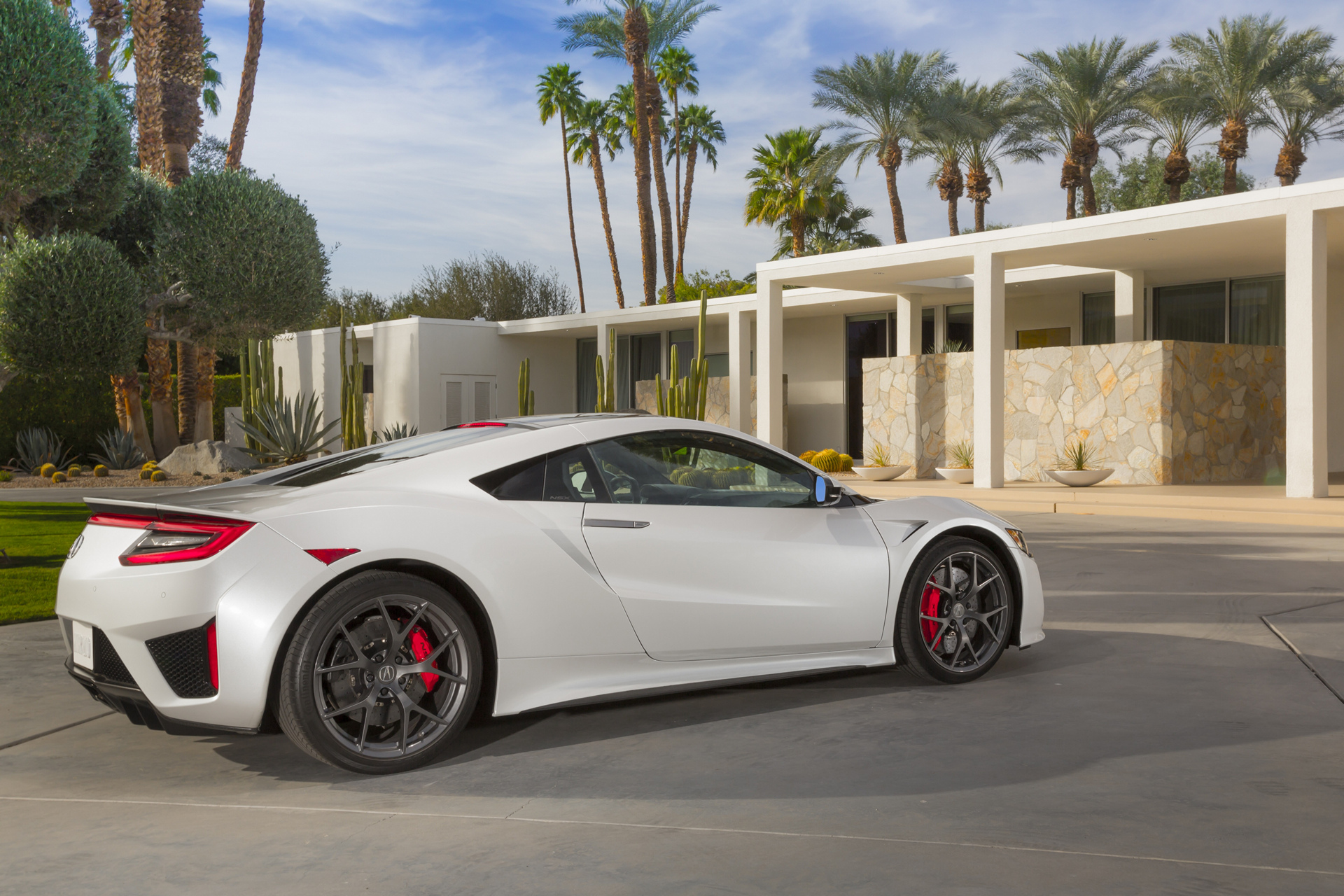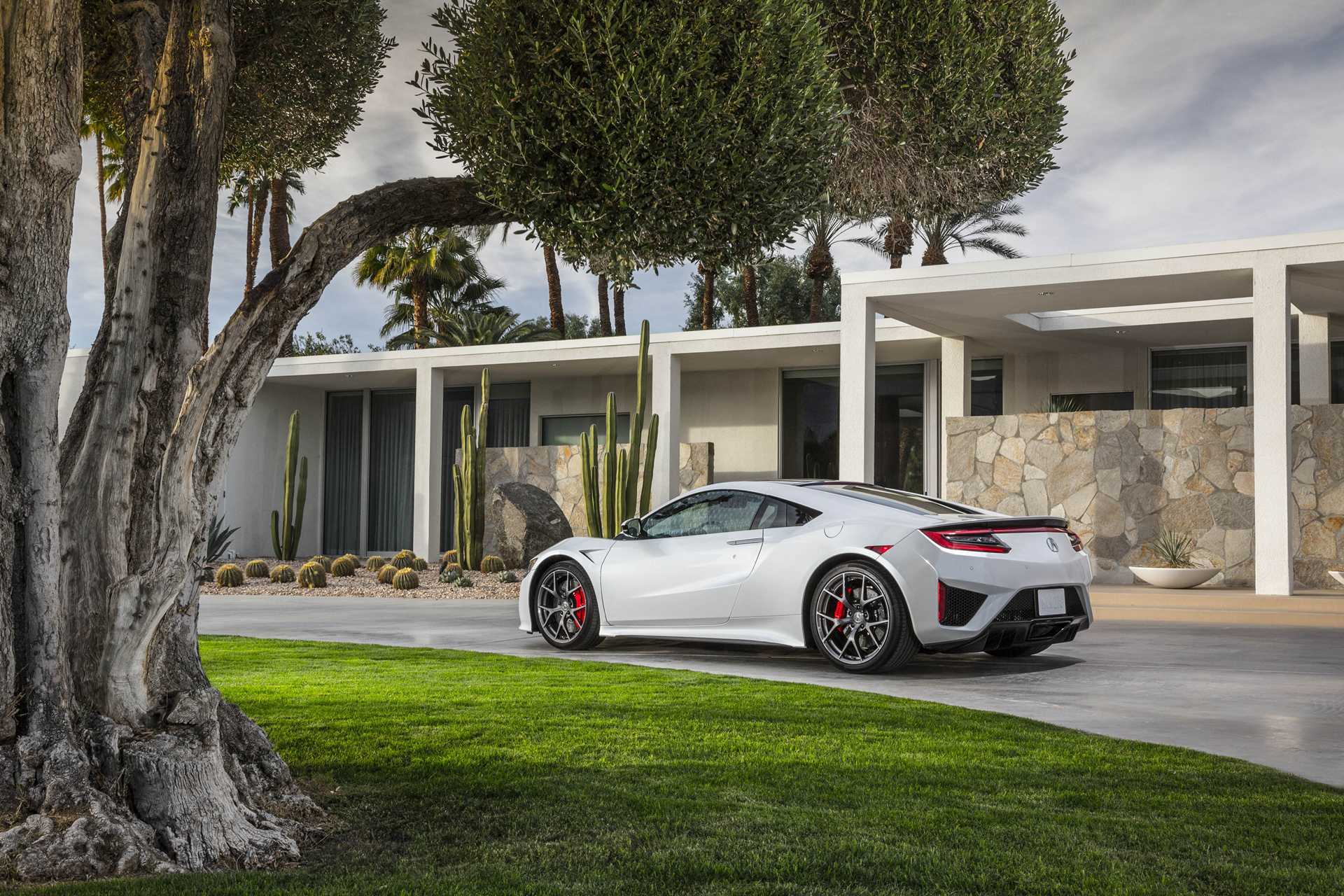A History of Innovation
When the original Acura NSX made its debut over 25 years ago, it forever changed sports car world by combining exotic car styling and performance with a new dimension of quality, exceptional ergonomics and dynamic poise. The NSX introduced and defined Acura’s approach to “Precision Crafted Performance” with its cutting edge design and innovative technology that provided accessible exotic car performance for real drivers in the real world.
By making use of advanced new technologies such as a lightweight yet rigid all-aluminum monocoque body/chassis mated to a mid-mounted transverse V-6 engine, the original NSX challenged conventional wisdom for an exotic car. Its high-revving V6 engine featured a number of innovative production-car technologies, including forged pistons, titanium connecting rods and VTEC valvetrain.
Moreover, the NSX sought a more intimate connection between the car, the driver and the road, pursued through essential design elements – low vehicle mass and high power-to-weight ratio, a rigid body supporting a performance-focused chassis, outstanding visibility, exceptional ergonomics, and accessible performance—creating a paradigm shift in what it meant to be an exotic car.
Importantly, the first generation NSX also exemplified Acura’s high standards of quality, durability and day-to-day reliability without compromising performance—something rarely found in exotic sports cars of the day.
Next-Generation Acura NSX Concept
Respecting these foundational concepts of the original NSX, the 2017 Acura NSX pursues an altogether new and revolutionary idea for Acura supercar performance, melding timeless sports car values with next-generation technologies to create a New Sports eXperience. And much like Acura’s Precision Crafted Performance DNA guided the creation of the original NSX, every aspect of this new NSX is a next-generation expression of those same values.
Based on the “man-machine synergy” approach that guides the development of all Acura vehicles, the company has created a driver-centered supercar where every part of the vehicle is respectful of the smartest part of the car—the driver.
Foremost among its many innovations is Sport Hybrid Super Handling All-Wheel-Drive (Sport Hybrid SH-AWD), a first-of-its-kind technology in the supercar realm. Marrying this cutting-edge and electrified new expression of Acura Super-Handling performance with new approaches to vehicle design—including advanced body construction, component packaging and aerodynamic optimization—results in a supercar that faithfully translates the acceleration, steering and braking inputs of the driver with incredible fidelity and virtually zero delay, thus amplifying the capabilities of every driver while greatly elevating the dynamic experience in every driving situation—qualities that define the New Sports eXperience.
Sport Hybrid SH-AWD utilizes its electric motors to assist acceleration, braking and cornering. With electrically-powered torque vectoring provided by the front-mounted Twin Motor Unit, the NSX takes Acura Super Handling All-Wheel Drive technology to a new dimension—using the dynamic, instantaneous and continuous distribution of electric motor torque to enhance handling precision and cornering performance in all driving situations.
The revolutionary NSX Sport Hybrid SH-AWD power unit and its advanced dynamic capabilities are supported by new concepts in supercar design and body construction. The NSX’s multi-material body/frame is a clean-sheet design, utilizing a multitude of materials and joining technologies, each chosen for its unique capability to deliver ultimate global and local body rigidity in combination with low mass, outstanding visibility and world-class occupant crash protection. The NSX’s multi-material body integrates several world-first technologies, including three-dimensionally bent and quenched ultra-high-strength steel A-pillars and ablation cast aluminum frame nodes.
Likewise, the design and packaging of the Sport Hybrid power unit’s components—engine, transmission, motors, batteries and control systems—is optimized to support and enhance its dynamic capabilities by lowering the center of gravity and centering the mass within the car.
GENERAL DIMENSIONS, CAPACITIES & WEIGHTS | |
|---|---|
Wheelbase | 103.5 in. |
Length | 176 in. |
Height | 47.8 in. |
Width | 87.3 in |
Track (front/rear) | 65.2 in. / 63.7 in. |
Fuel Tank Capacity | 15.6 gal |
Curb Weight (without options) | 3,803 lbs. |
Weight Distribution (front / rear without options) | 42% / 58% |
Sport Hybrid Super Handling-AWD Power Unit
The next-generation Sport Hybrid SH-AWD power unit consists of an all-new twin-turbocharged mid-mounted V6 engine paired with an all-new 9-speed dual clutch transmission (DCT) and Direct Drive Motor that supplements the engine with instant torque response. The Direct Drive Motor also operates as a generator, maintaining the state of charge of the hybrid batteries to consistently support driver demands.
These systems, which comprise the rear power unit, are supplemented by the revolutionary capabilities of the front-mounted Twin Motor Unit (TMU). Containing two electric motors that independently drive the left and right front wheels, the TMU provides “active AWD,” increasing forward acceleration and continuously varying torque—both positive and negative—supplied to the front wheels. The resulting “direct yaw control” effect enhances agility, stability, performance and response—it is true torque vectoring, available at any speed. Finally, the TMU also provides regenerative braking force, supporting braking demands while also recharging the hybrid battery.
By taking advantage of the immediate and precise torque response of the power unit’s three electric motors, the Sport Hybrid SH AWD system can elevate any driver’s confidence and performance while extracting more performance than could be obtained without it.
POWER UNIT SPECIFICATION OVERVIEW | |
|---|---|
Sport Hybrid SH-AWD Power Unit | Front wheels: mechanically independent from rear power unit components, two electric motors (Twin Motor Unit); Rear wheels: Twin-turbocharged V-6 gasoline engine with one Direct Drive Motor and 9-speed DCT |
Maximum Total System Power | 573 HP |
Maximum Total System Torque | 476 lb.-ft. |
ENGINE | |
Type | Twin-turbocharged DOHC V6 |
Layout | Longitudinally mid-mounted |
Displacement | 3493 cc |
Horsepower - SAE Net | 500 HP @ 6500-7500 rpm |
Torque | 406 lb.-ft. @ 2000-6000 rpm |
DIRECT DRIVE MOTOR | |
Type | Water-cooled motor/generator |
Layout | Direct drive motor attached directly to crankshaft |
Horsepower @ rpm | 47 HP @ 3000 |
Torque @ rpm) | 109 lb.-ft. @ 500-2000 |
TRANSMISSION & REAR AXLE | |
Type | 9-Speed Dual Clutch Transmission (9DCT) |
Differential | Limited slip with wet multi-plate clutch |
FRONT TWIN MOTOR UNIT (TMU) | |
Type | Water-cooled motor/generator |
Layout | Independent twin motors in a single package with a planetary gear set, one-way clutch and brake |
Horsepower @ rpm | 36 + 36 HP @ 4000 |
Torque @ rpm | 54 +54 lb.-ft. @ 0-2000 |
Multi-Material Body
Like the original Acura NSX—the world’s first all-aluminum exotic car—the all-new NSX has a cutting-edge structure. Its multi-material body utilizes new materials and construction methods to achieve unprecedented dynamic rigidity, outstanding outward visibility, and world-class collision performance. Making use of a space-frame design, the new NSX is composed primarily of lightweight aluminum, with the strategic use of steel and carbon fiber in select areas.
- Unmatched dynamic torsional rigidity – The NSX directly responds to the driver’s cornering demands, instantly transmitting those inputs to the chassis while maintaining perfect connection between front and rear axles, communicating both the driver’s action and any changes in the road surface with the utmost fidelity.
- Ultra-high local chassis rigidity – Each chassis component is mounted to a rigid casting supported by extruded aluminum frame members that act like “truss structures” such that high local attachment-area stiffness is ensured in all directions—thus maintaining the precisely-designed chassis geometry at all times.
- World’s first automotive application of ablation casting technology – Used both at front and rear, these ablation cast aluminum frame nodes service as ultra-rigid mounting points for the suspension. Applied in key crash zones, these nodes link frame sections together and uniquely deform in a manner similar to a forged component but with lower weight, enabling shorter front and rear overhang, reduced vehicle mass and superior collision performance.
- A-pillars: Super strong, yet slender – In another world’s first, a new three-dimensional bent and quenched frame member was employed to create thin yet sturdy A-pillars. The resulting ultra-high strength material allows a slender cross section to maximize forward visibility while meeting structural demands, including roof-crush requirements.
Other advanced construction and manufacturing techniques employed in the all-new Acura NSX include the world’s first use of all-robotic MIG welding of the space frame for uniform and precise joining of its aluminum components.
As with the space frame, NSX designers utilized a multitude of lightweight materials for the exterior body that are ideal for the task. Sheet hydro-formed aluminum is used for the outer door panels; aluminum stampings are used for the hood and roof (a carbon fiber roof is optional); sheet molding compound (SMC) is used for the fenders and trunk lid; and a high-temperature-resistant ABS plastic is used near the engine. This optimized material strategy is key to achieving desired panel rigidity with low weight, pedestrian safety performance, desired aesthetic design and exceptional surface finish.
BODY / FRAME | |
|---|---|
Body/Frame Construction | Multi-material space frame with cast aluminum nodes, and a mix of light aluminum and low-density SMC outer panels |
Ablation Cast Aluminum Nodes | Complex high performance aluminum castings for crush zones; World's first automotive application |
A-Pillar Structure | 3-D Bent and Quenched ultra high-strength steel (1500 MPa); World's first application |
Front Floor Panel | Carbon fiber |
NSX Chassis
The next-generation NSX chassis combines best-practice fundamental sports car design with advanced new technologies to elevate and enhance the NSX driving experience. Mounted directly (without subframes) to the ultra-rigid space frame, the NSX’s all-aluminum front and rear suspension systems—augmented by third-generation active magnetorheological (MR) dampers and a rigidly-mounted dual-pinion variable-ratio electric power steering (EPS) system—elevate the NSX’s dynamics performance while supporting the breakthrough capabilities of its Sport Hybrid SH-AWD system.
Front double ball joint suspension eliminates torque vectoring steering disturbances. The rigidly mounted EPS provides high fidelity steering feedback. The rear suspension’s high lateral rigidity is key to minimizing lateral acceleration response delay, and maintaining proper response phasing of the rear axle with respect to the front, to achieve stable cornering beyond 180 mph.
Deceleration capability is also enhanced with a next-generation electro-mechanical super sports braking system that combines the effectiveness of a high-performance mechanical (friction) braking system with a seamlessly integrated regenerative braking system. This next-generation “super sports brake” concept delivers class-leading braking performance virtually fade free, while recovering what would otherwise be wasted energy to help keep the hybrid battery charged and ready to support other dynamics demands.
Another important element of the chassis design includes the power unit mounting system, which utilizes a rigid aluminum subframe and the ultra-rigid space frame to firmly anchor the power unit; strategically-located mounts minimize engine and transmission movement (pitch and roll) within the body/frame.
CHASSIS SPECIFICATIONS | |
|---|---|
Front Suspension Type | Double-wishbone, double lower control arm; aluminum |
Rear Suspension Type | Multi-link; aluminum |
Dampers | Active Gen III magnetorheological coilovers |
Brakes | Vented disc with Brembo aluminum mono block calipers and iron rotors; optional carbon ceramic rotors |
Steering Type | Variable ratio rack & pinion; Dual-pinion EPS |
Steering Wheel Turns, Lock-to-Lock | 1.91 |
Steering Ratio | Variable progressive; Range: 12.9:1 (on center) to 11.07:1 |
Front Wheels | 19x8.5J forged aluminum |
Front Tires | 245/35ZR19 93Y high performance summer tires; optional ultimate handling performance tires |
Rear Wheels | 20x11J forged aluminum |
Rear Tires | 305/30ZR20 103Y high performance summer tires; optional ultimate handling performance tires |
Advanced Sports Package
The new Acura NSX’s “advanced sports package” is a design philosophy that seeks to optimize the packaging and layout of major vehicle systems—including the Sport Hybrid power unit (engine, Direct Drive Motor and 9DCT) and key hybrid components such as the Intelligent Power Unit (containing the lithium-ion battery pack)—to lower the CG, centralize the mass of the vehicle, and achieve desired weight distribution for optimal handling.
- The design of the bespoke all-aluminum twin-turbocharged V6 engine, including its 75 degree cylinder bank angle, dry sump lubrication system and compact valvetrain, is optimized for a low center of gravity and overall compact design.
- Likewise, the purpose-built 9DCT utilizes a new design, with the clutch and the differential situated side-by-side in a common housing, and a parallel shaft gear set arrangement—both of which help reduce the length of the powertrain.
- The Intelligent Power Unit, located in front the rear bulkhead, contains a new, compact lithium-ion battery pack with high power and energy density, and featuring a new “caseless” design for reduced mass. The twin fuel tanks are mounted behind the rear bulkhead, in front of the engine.
- The hybrid system’s Power Control Unit (PDU) uses a compact “three-in-one” design (converting direct current to alternating current to supply all three electric motors) allowing it to be packaged neatly in the vehicle’s center tunnel.
- Vehicle design also prioritizes small overhangs for a small footprint, helped by the aforementioned ablation cast nodes, while preserving comfortable cockpit headroom for 95th percentile male drivers.
Aerodynamics: “Total Airflow Management”
The NSX’s design and development team utilized a “total airflow management” approach to give the NSX the superlative aerodynamics one expects of a next-generation supercar, while simultaneously providing the effective and efficient thermal management required for its hybrid power unit. Six different heat sources must be managed: The twin-turbo engine, the 9-speed DCT, the PDU, and the three electric drive motors. To provide efficient cooling, airflow is managed through 10 heat exchangers situated to efficiently use airflow through the front grill area, side air intakes, and through the engine compartment.
The NSX effectively manages air flowing through the front motor room and rear engine room as well as around the body, while still maintaining the increased stability of properly distributed downforce. In fact, stability at speed is a hallmark of the new NSX, with unprecedented balance and confidence to enhance the driving experience.
Through extensive research and development, the NSX aerodynamics team determined that a 3-to-1 downforce ratio—placing three times as much downforce at the rear of the vehicle relative to the front of the car—would provide the optimal downforce distribution for high-performance driving.
Through the extensive use of computational fluid dynamic (CFD) simulations as well as testing of 40-percent scale model testing in the company’s advanced wind tunnel facility in Ohio, the team fine-tuned the various body shapes, intake and exhaust vents and vehicle strakes to reduce aerodynamic drag, create downforce, maximize cooling and efficiently exhaust unwanted heat.
The innovative aerodynamic developments were continuously verified at the company’s full-scale, moving ground plane wind tunnel in Sakura, Japan.
NSX Cockpit
From the intuitive instrumentation and simple control layout to the careful application of materials and padding in the sports seats, steering wheel and center console, the NSX provides exceptional, driver-centric ergonomics that supports and clarifies the driving experience.
To develop an interior with exemplary ergonomics, the Acura design team utilized a number of test drivers with wide-ranging driving experience and skill sets to gather information to improve all aspects of driver feedback and support in the NSX.
Attractive as well as structurally rigid and lightweight, the seats in the new NSX are designed to offer superlative comfort and support, with the lateral and fore/aft support needed for a supercar. Developed through extensive testing and pressure mapping measurements, these seats offer more comfort than those in competing high-performance vehicles while providing the torso and thigh bolstering needed in a high-limit vehicle such as the NSX. Seat materials such as leather and Alcantara were carefully selected for the perfect combination of dynamic driving support and comfort, including ease of ingress-egress.
Likewise, the center console/controls have been designed to minimize distractions from the most important function—driving—ultimately serving as a “simple sports interface.”
Integrated Dynamics System
The unique nature of the NSX’s Sport Hybrid power unit enables a higher degree of flexibility to customize the driving experience and dynamic performance to suit the needs and desires of the driver and the driving environment. This capability is provided by the Integrated Dynamics System, controlled by the Dynamic Mode dial on the NSX’s center console.
The NSX Integrated Dynamics System features four selectable dynamic modes – Quiet, Sport, Sport+ and Track – integrating all of the vehicle’s dynamic systems: steering, brakes, throttle, Vehicle Stability Assist, dampers and Sport Hybrid SH-AWD control systems, as well as providing a customizable auditory experience via new Intake Sound Control and Active Exhaust Valve technologies. (See Dynamics and Performance Management for additional detail).
Design, Development and Manufacturing
Design and development of the next-generation NSX involved a global team of engineers and designers. Design and development work on the Sport Hybrid power unit was centered in Tochigi, Japan, while design and development of the body, chassis, electrical and interior, along with total vehicle integration was concentrated in Raymond, Ohio. Initial design for the NSX was conducted at the company’s Wako, Japan design studio and was fully evolved and matured for production by the Acura Design Studio in Los Angeles.
Throughout its roughly four-year development, the fundamental concepts for a New Sports eXperience remained clear and consistent. However, the technologies and means by which the R&D team would realize their concept underwent a process of continual improvement and evolution, most notably in the area of engine design. Whereas the original direction called for a transverse-mounted, normally aspirated V6, the NSX development concept evolved to a new and more challenging approach—an all-new bespoke twin-turbocharged, longitudinally-mounted V6 engine. This radical re-imagination of the engine design had profound implications for every element of the NSX design, especially the package, cooling systems and aerodynamics.
The NSX has been tested and tuned on streets and race circuits around the world. In addition to the Transportation Research Center in Ohio and on-road testing, primary development tracks were Virginia International Raceway, the famed Nürburgring in Germany and at Honda’s own Takasu test circuit in Hokkaido, Japan.
The NSX is manufactured at the new Performance Manufacturing Center (PMC) in Marysville, Ohio using domestic and globally-sourced parts. The PMC was designed to innovate new means and methods of producing low-volume specialty cars and to realize challenging new ideas for next-generation craftsmanship and quality established by the NSX manufacturing team. The Performance Manufacturing Center employs approximately 100 associates, including 70 highly skilled manufacturing technicians engaged in body construction, painting, assembly and quality confirmation of the NSX. Among its many innovative processes is the world’s first use of all-robotic MIG welding for the construction of the NSX’s aluminum space frame.
The NSX’s bespoke twin-turbocharged V6 engine is meticulously hand assembled by expert technicians at the company’s engine plant in Anna, Ohio, using techniques and processes benchmarked against the company’s world-class race engineering programs. Each engine is bench tested and broken in to the equivalent of 150 miles of service. The NSX’s 9-speed dual clutch transmission, Direct Drive Motor and engine are machine balanced and assembled at the Anna Engine Plant. The Twin Motor Unit (TMU) and other hybrid system components are built in Japan and sent directly to the Performance Manufacturing Center for fitment in the NSX.
Exterior
Design Concept
The exterior design of the all-new 2017 Acura NSX reflects the integration of exotic supercar aesthetics and exceptional supercar performance. The “Interwoven Dynamic” overarching design theme for the exterior architecture epitomizes the concept of “form following function,” as every character line, body panel shape or crease, air flow inlet/outlet, and even the vehicle’s overall proportions have been designed to create a New Sports eXperience. Accordingly, each aspect of the NSX’s exterior architecture has been optimized to support the dynamic capabilities of the NSX while advancing Acura design into the future.
EXTERIOR DIMENSIONS | |
|---|---|
Wheelbase | 103.5 in. |
Length | 176 in. |
Height | 47.8 in. |
Width | 87.3 in |
Track (front/rear) | 65.2 in. / 63.7 in. |
Ground Clearance (unladen) | 3.7 in. |
Approach/Departure Angles | 9.2° / 12.9° |
Key Exterior Features
- Optimization of exterior design for aerodynamic efficiency (drag and downforce), power unit intake air and cooling, and brake cooling using a “total airflow management” approach
- Composite and aluminum body panels
- Aluminum or optional exposed-weave carbon fiber roof panel
- Acura Jewel Eye™ LED headlights with auto-on/off
- Smart Entry/Push Button Start keyless access system
- Flush-mounted automatic power pop-out door handles
- Body-colored power heated side mirrors with reverse auto tilt-down and integrated LED turn indicators
- LED brake lights
- Acoustic glass windshield and rear windscreen
- Capless fuel filler
Exterior Styling
Every square inch of the Acura NSX’s exterior body panel surfaces, fluid shapes, air inlets/exhaust outlets and even the positioning/shaping/thickness of the floating C-pillars serves a distinct purpose—one that has been carefully calculated through thousands of hours of complex computational fluid dynamics (CFD) in combination with extensive wind tunnel testing in the company’s advanced facilities in the United States and in Japan.
“The idea that form follows function is fundamental to Acura design, and this philosophy is interwoven in the core of NSX, which is why our exterior concept is called “Interwoven Dynamic,” said Michelle Christensen, exterior design project leader in the Los Angeles based Acura Design Studio. “The NSX is a visual expression of beautiful design and performance working together, influencing every decision we made—every surface, every millimeter, every design element of the new NSX is focused on enhancing performance.”
From the acutely angled slope of the chiseled aluminum hood to the rakishly shaped Acura Jewel Eye™ LED headlights and tapered front grille, the front is supercar sleek. The distinctive headlights are bisected by massive mesh-covered air inlets from below and the front fenders are highlighted by a sharply creased character line running all the way from the grille towards thinly sculpted A-pillars.
Remarkably compact overhangs, fore and aft, foretell the design and engineering team’s exemplary packaging of mechanical and electrical components, while the vehicle’s overall sleek yet muscular stance conveys a sense of purpose and power. The hood line, roofline, floating C-pillars and rear quarter appear as one distinctive and unified curve. The massive yet lightweight high- performance wheel and tire package fit within the arching wheel wells with minimal gap and perfect proportion.
The rear of the vehicle is equally striking, highlighted by the signature floating C-Pillars, which cascade gently from the roofline to just forward of the integrated spoiler at the trailing edge of the rear deck lid, flanking an expansive glass panel that reveals the twin-turbocharged V-6 engine.
Further accentuating the exterior architecture of the new NSX are a choice of eight paint schemes, each color in the rich palette carefully selected and engineered to accentuate the exterior’s bold design while ushering in a new level of paint quality within the supercar segment (see Colors and Options for additional detail).
Floating C-Pillars
The floating C-pillars integrated into the exterior architecture of the all-new NSX are as purposeful as they are distinctive, supporting efficient body-side airflow. The C-pillars extend outward from the sloping rear roofline so that, as air flows down the sides of the vehicle, it is efficiently rerouted into the side-mounted engine air intakes. The floating C-pillars also aid engine cooling by creating a negative pressure zone around the rear heat exhaust vents, along the outside edges of the rear windscreen, improving the efficiency of hot air exhaustion. The portion of air that flows down the side of the vehicle toward the outside section of the buttress is conditioned to reduce turbulence as it passes with minimal disruption over the rear fender and spoiler.
Door Handles & Trunk Access
The flush-fitting exterior door handles are both aesthetically pleasing and functional, providing a welcoming “handshake” with the driver/passenger as they extend outward from the door upon approach while at the same time supporting clean airflow along the body side.
Smart Entry with keyless access is enabled by both proximity sensors, tied to the remote key fob, and capacitive touch sensors in the exterior door handles. A proximity sensor actuates the door handles upon approach, extending them outward for easy operation. Grasping either door handle activates a capacitive touch sensor, which initiates door unlocking. Once the driver/passenger releases the handle, it returns to the flush position. The doors can also be unlocked using the remote key fob—a single push of the unlock button extends the driver’s door handle and simultaneously unlocks the driver’s door, while a double push of the button extends both door handles and unlocks both doors.
Upon exiting the vehicle, the driver/passenger can lock the vehicle by simply touching a button positioned just forward of the handle or by depressing the lock button on the remote key fob.
The exterior door handle mechanism is both a mechanical and electrically operated system. As is the case with an electronically operated system on a vehicle such as an EV, the driver/passenger can sometimes be locked out of the vehicle due to an onboard power failure; this is impossible with the NSX thanks to a redundant mechanical system that allows the driver/passenger to manually operate the door handle without electrical assistance. Automatic door handle extension can be disabled by a switch in the glove box for shipping or long-term storage.
The trunk is accessed by means of the remote key fob, by a button located on the driver’s interior door panel, or by a button discretely located under the trailing edge of the trunk lid. In the event of a loss of power, both the driver’s door and the trunk also feature a traditional key cylinder for manual locking/unlocking of the doors and trunk.
Supercar Wiper/Washer system
The wiper/washer system, engineered specifically for the new NSX, has been designed to operate effectively even at maximum vehicle speeds. Tested in the wind tunnel at airflow equivalent of over 180 mph, the spoiler-shaped wiper blades generate downforce on the wiper blade, while the speed-controlled wiper motor maintains a constant wiping speed, ensuring effective wiper performance in all driving conditions. Likewise, the windshield washer system utilizes a three-nozzle system for superior coverage in all conditions and driving environments, including high-speed travel.
In a further nod to improving forward visibility and providing an unobstructed view of the road, the windshield wiper arms are placed as low as possible at the base of the windshield/lower cowl section so that they remain completely out of the driver’s view when not in operation. Placing the wipers below the hood also helps mitigate wind noise.
Door Mirrors
Featuring a two-tone paint scheme that accentuates the NSX’s low-slung look and wide stance, the door mirrors include a thin blade arm to minimize air turbulence as air flows along the side of the vehicle. This reduces local airflow noise, prevents disruption of air flowing to the side intakes, and minimizes aerodynamic drag. And like the ultra-high-strength A-pillars, the thin blade arm design improves visibility when parking and cornering. Each mirror housing includes an LED turn signal.
LED Lighting
The exterior design of the 2017 NSX features a variety of light-emitting diode (LED) lighting, including Acura Jewel Eye™ LED headlights, LED daytime running lights (DRL), and LED taillights.
Acura Jewel Eye LED Headlights
Acura Jewel Eye LED headlights are a standard feature on every NSX. Designed to complement the aggressive low and wide exterior appearance, each headlight assembly contains six individual LEDs, with the four outer LEDs in operation when using the low beam setting, and all six at work when the high beams are activated.
Acura Jewel Eye LEDs provide superior down-the-road illumination with outstanding light distribution and light characteristics and a wavelength close to the human eye’s luminosity curve. With their lower electrical power consumption, the NSX’s Jewel Eye LED headlights also have a longer operational life compared to traditional halogen or high-intensity discharge (HID) lamps.
LED Daytime Running Lights (DRL)
Utilizing the top half of each LED headlamp that makes up the Acura Jewel Eye™ LED headlight assembly are the NSX’s LED daytime running lights (DRL). Located just beneath the LED headlamps are the LED position lights, composed of a series of small and tightly packed LEDs that run in a thin continuous line along the bottom of the headlight assembly. LED lighting is also used for the turn signals at both the front and rear of the vehicle.
LED Taillights
Similar in character to the Acura Jewel Eye LED headlights at the front of the vehicle, the LED taillights have a compact and narrow appearance with a uniquely freeform shape. The LED taillight array starts off wider, toward the center portion of the rear of the vehicle, then gently tapers as it wraps around towards the outside corners/rear fender arches.
Exterior Body Construction
The NSX’s multi-material body design concept extends throughout the entire body construction. By employing sheet molding composite (SMC), aluminum stampings and high temperature-resistant plastic in key locations of the body, the NSX design team takes advantage of each material’s unique characteristics to create exterior body panels of the highest finish quality while also minimizing vehicle mass, optimizing weight distribution and center of gravity, and helping to ensure outstanding longevity and durability.
Composite Panels
Used extensively in the construction of high-end exotic cars in key exterior componentry, SMC is a high-grade specialty glass-fiber reinforced polyester, its shape formed while heated under pressure within a compression molding. By utilizing special resins as well as high-strength fiber composite matting, NSX exterior design engineers have developed SMC material for specific applications on the vehicle’s exterior.
Specially engineered SMC material is used in the fender sections at all four corners. Designed to possess high structural rigidity, this unique SMC paneling makes an important contribution to optimizing the NSX’s overall center of mass by minimizing weight at all four corners. The rear trunk skin is also made of lightweight SMC, with structural support provided by a stamped aluminum inner frame structure.
A special, high temperature-resistant plastic is used in the small body panel sections just below the floating C-pillars (forward of the rear fenders) due to the body panels’ close proximity to the turbo intercoolers.
A rigid, structural SMC material has been developed for the NSX’s trunk internal structure. This highly rigid construction allows the trunk structure to serve as a mounting point for the rear fenders and rear bumper for a sturdy and precise fit. An added benefit of the trunk compartment design is that it allows for easy removal when the vehicle is brought into an Acura dealer for service; after removing the rear fascia, the entire trunk structure can be removed for easy access to the engine room. This design also simplifies replacement of the rear section should the NSX be involved in a rear-end collision.
Aluminum Panels
The NSX door skins are made of sheet hydroformed aluminum. Sheet hydroforming is the ideal means to shape the one-piece aluminum panels that make up each door, as the process supports the construction of complex shapes that cannot be formed by conventional stamping techniques. Moreover, the aluminum door skins can be relatively thin and light as they are naturally supported by the inner door structure.
The hood, roof panel and the engine compartment/trunk frame are composed of high-grade stamped aluminum. A carbon fiber roof panel is optional. Like the other composite materials utilized in the exterior, the use of aluminum in these areas offers light weight with excellent structural rigidity and surface quality.
Body Panel Fitment
As the near final step in the vehicle assembly process at the Performance Manufacturing Center, the exterior body panels are attached to the vehicle’s space frame, starting with the roof, then the doors, etc., working from the top down. This process, along with the high degree of dimensional accuracy for the underlying space frame, allows for fine adjustment of panels to achieve consistent and symmetrical panel gaps.
Aerodynamics: A “Total Airflow Management” Approach
To support the NSX’s ambitious performance targets, innovative packaging design and exotic styling, the development team completely reimagined the exterior engineering for this modern supercar so that maximum energy is extracted from the flow of air around and through the NSX with the highest efficiency. This “total airflow management” strategy supports complete power unit cooling and air intake, brake system cooling, and aerodynamic performance—drag and downforce—at a very high level.
Computational fluid dynamics (CFD) was used extensively during development to maximize the performance of the power unit cooling systems: First, for the proof-of-concept in establishing heat management strategy at the earliest development stage; and second, for continuous thermal performance improvement as the vehicle matured through development.
Along with the use of advanced CFD, wind tunnel and real-world testing, the development team employed computerized lap-time simulation models of some of the world’s most legendary proving grounds that could then be run on chassis-dynamometers allowing testing and validation of computer models for thermal management.
Aerodynamic Design Highlights:
- Efficient cooling openings at the front of the vehicle maximize cooling airflow across the key heat exchangers located within the front section (front engine radiators, Twin Motor Unit cooler, condenser, the transmission gear cooler, hybrid Power Distribution Unit).
- Optimized front exit flow paths consider total flow, maximum downforce, low coefficient of drag, and downstream flow structure to feed the engine air intakes.
- Wheel wake management vents work in conjunction with fender vents to stabilize airflow down the side of the vehicle, allowing the air to smoothly enter the signature side intakes for efficient cooling. The air that enters the side intakes is distributed to three areas: engine intake, engine room cooling, and turbo intercoolers.
- Air flowing over the roof and down the rear glass is captured to feed the transmission clutch cooler and introduce engine-room cooling flow.
- Airflow across the rear deck lid works in concert with the taillight slots and rear diffuser to generate significant downforce and effectively manage the air wake generated behind the vehicle. It also minimizes the low-pressure wake coming off the rear of the vehicle and therefore minimizes drag.
- Optimization of front/rear downforce distribution for improved handling and stability
- Rear brake cooling air ducts designed into the hollow sub-frame direct cooling air to the rear brakes using specially tuned air deflectors located on the rear suspension arms.
Supercar Aero
NSX achieves top-class aerodynamic balance and supercar aerodynamic downforce. Aerodynamic drag is minimized, even while moving large airflows through the vehicle to cool the power unit. Aerodynamic downforce is created by utilizing airflow through each vent, as the NSX “exhales,” and through more traditional aerodynamic shape optimization.
The NSX has undergone extensive testing at the company’s state-of-the-art wind tunnel in Raymond, Ohio, using ultra-detailed 40-percent-scale models that replicate the suspension, wheel/tiire, intake and exhaust vents, heat exchangers and major under-hood components. The NSX has also been verified and further refined through testing at full scale in the company’s wind tunnel in Tochigi, Japan and on real and simulated proving grounds throughout the world.
Airflow management vents and precision ducting were tuned to optimize forms with aerodynamicist and designer input during wind tunnel test sessions. A 3-to-1 downforce ratio—placing three times as much downforce at the rear as at the front of the car—provides the optimal balance for high-performance driving as well as everyday functionality.
Six vortices flow at the rear of the NSX, including those that support the highest downforce across the rear deck lid. Air flowing from below the car and exiting through carefully optimized rear diffuser fins is a critical vortex that further anchors NSX to the ground. Uniquely, the fins are not parallel to each other, but are narrower toward the front of the car and wider at the rear. This design amplifies negative pressure, enhancing diffuser efficiency which further maximizes downforce.
Of note, the NSX aerothermal team worked to evaluate thermal loading in racetrack conditions using a chassis dynamometer. In addition to simulating key performance parameters, such as engine speed and braking, the test included varying wind speeds based on real-world track data. Simulations included Sebring International Raceway and Virginia International Raceway, the latter serving as one of the primary development tracks for the new NSX.
NSX Exterior Finish/Paint
The NSX paint team at Acura’s innovative new Performance Manufacturing Center targeted the highest levels of paint quality with reduced environmental impact, consistent with their target of next-generation quality and craftsmanship.
NSX Body Panel Paint Process:
Because the NSX’s exterior body panels are not attached to its space frame until the conclusion of the vehicle assembly process, body panels are treated and painted separately from the frame (see Body for more detail) and are finished to an exceptional level of quality and luster by expert technicians at the Acura Performance Manufacturing Center.
- NSX body panels enter the paint process attached to a specially designed fixture that locates the panels in a position and angle similar to how they are oriented once installed on the vehicle.
- All body panels are covered with a high-quality primer coat and, depending upon the specific color application, then receive between five and seven coats of paint. Each layer of colored paint applied to the body panels is allowed to fully cure prior to the next application.
- A high-quality/long-lasting clear coat is then applied.
- To help minimize the potential for “orange peel,” which occurs when the clear coat on vertical body panels is pulled down by gravity during the curing process, the body paint fixture has hinges that allow the vertically oriented body panels—doors and fenders—to be rotated to a near-fully horizontal position during the curing process.
- Once cured, the panels undergo careful inspection in a newly designed inspection booth utilizing high-intensity LED lighting to help associates identify and address even the smallest irregularities.
- Body panels are then hand finished after the first layer of clear coat, and again after the second clear coat.
Interior
Concept
A complementary and essential component of the all-new Acura NSX’s New Sports eXperience is its driver-centered interior design, where every element—materials, shapes, technology and layout—are optimized to enhance the driving experience. Exceptional ergonomics, a hallmark of the original NSX, have been further advanced. Moreover, as a pinnacle representation of Acura Precision Crafted Performance, the NSX is designed to provide outstanding comfort, quality and advanced, intuitive technologies, all presented in clean and modern aesthetic.
“The interior of the all-new Acura NSX is highlighted by what we call ‘Interwoven Dynamic’ design,” said Michael Cao, interior project leader. “It combines the best attributes of intuitive, easy-to-use functionality and superior ergonomics with a clean and modern design aesthetic worthy of a next-generation supercar. It’s the ultimate testimony to the beautiful simplicity of form following function.”
Artfully sculpted and ergonomic seats are enhanced with supportive yet comfortable bolstering, firmly yet comfortably supporting the driver and passenger and clarifying the driving experience. Strategically placed console and door padding further elevate the driver and passenger lateral support. Materials such as leather and Alcantara® were carefully selected for the ideal combination of craftsmanship and dynamic driving support.
The driver’s instrument cluster and center console have been designed to enhance the driving experience with intuitive layout and simple operation, creating a “simple sports interface” for the driver.
The next-generation NSX interior also supports the idea of a customizable driving experience, employing a trifecta of advanced sound modulation technologies—Active Sound Control, Intake Sound Control and Active Exhaust Valve—that work in concert with the NSX’s Integrated Dynamics System to deliver a tunable cabin sound experience commensurate with the desires of the driver and the driving environment.
INTERIOR DIMENSIONS | |
|---|---|
Seating Capacity | 2 |
Headroom | 38.3 in. |
Legroom | 42.8 in. |
Shoulder Room | 57.6 in. |
Hip Room | 54.5 in. |
Passenger Volume | 44.0 cubic feet |
Cargo Volume | 4.4 cubic feet |
Interior Features
- Perforated Milano Leather and Alcantara-trimmed heated and 4-way adjustable sport seats (optional 4-way power seats with 4-way power lumbar and 2-position memory; semi-aniline leather/Alcantara or semi-aniline full leather trim)
- Push Button Start
- Active Sound Control
- Intake Sound Control
- Dynamic TFT gauge cluster
- Leather-wrapped sport steering wheel (available carbon fiber trim)
- Illuminated steering wheel-mounted controls (for cruise/audio/phone/MID info)
- Tilt and telescopic steering column
- Leather-trimmed instrument panel
- Leather-trimmed door panels
- LED interior ambient lighting
- 7-inch capacitive touchscreen Display Audio system
- Dual-zone automatic climate control
- Electronic cruise control
- HomeLink® remote system
- Frameless automatic-dimming rearview mirror
- Center console storage
- Power windows with auto-up/down operation
- Power side mirrors
- Power door locks
- Power remote operated fuel filler door
- 12-volt power outlet
- 1-amp USB interface port in glove box
- 1.5-amp USB interface port in rear console storage box of center console
- Rear cargo area light
- Rear engine compartment window defroster
- Cargo area tie-down anchors
Visibility
To maximize forward visibility, the NSX employs a new technology—three-dimensionally-bent and quenched ultra-high tensile strength steel—to create highly rigid yet very thin A-pillars that offer exceptional strength and roof-crush protection while providing the vehicle’s occupants with a panoramic view of the road ahead. (See Body section for additional information)
In addition to the tremendous visibility offered by the streamlined A-pillar construction, the heights of the instrument panel and gauge cluster hood are minimized for enhanced forward visibility.
Interior Illumination
The driver’s gauge cluster and Display Audio touchscreen illuminate upon vehicle entry and progressively brighten to full strength with the start of the Power Unit. The display screen of the driver’s gauge cluster presents rich and brightly colored typeface with information that is easy to read against a black background.
Additional interior lighting includes blue-tinted LED lighting for the foot wells and center console and twin LED map lights located in the overhead console.
Sport Seats
Superbly supportive for spirited driving adventures on the road or track, while offering all-day comfort for the hours in between, the NSX sport seats were developed with exemplary ergonomics.
To maximize support and comfort, the four-way manually adjustable driver and passenger seats include tall bolsters with integrated support structures for improved lateral hold, as well as an appropriate balance of ingress/egress and freedom of shoulder movement. The Alcantara center panels in the seat bottom and seatback enhance lateral grip, while the leather outer surfaces improve ease of ingress/egress.
The seat bottom structure is composed of stamped aluminum for reduced weight. Both the seat and seatback are of sturdy construction to hold the driver/passenger in place and for longevity and crash performance considerations, and the headrest is designed to accommodate a helmet for track outings.
Seating options include four-way power-adjustable heated sport seats with 4-way power lumbar and 2-position memory (driver) in either full leather or leather with Alcantara inserts (see Options & Colors for additional detail).
To facilitate ease of ingress and egress, the optional power driver’s seat automatically moves rearward when the ignition is turned off.
Steering Wheel
As the centerpiece of the driver’s tactile and dynamic driving experience, the NSX steering wheel has been painstakingly designed to provide a seamless connection between the car and driver, providing superior grip, comfort and control.
- The interior frame of the steering wheel is composed of magnesium
for strength and low mass. - The leather wrapped outer surface is crafted to be entirely seamless
with ergonomically designed shapes for optimum grip, control and comfort. - The wheel shape optimally supports both nine and three o’clock and ten
and two o’clock hand positions and is complemented by extended-length
paddle shifters. - A flattened top section offers improved forward visibility and a flattened
bottom enhances driver leg space. - A manual tilt/telescope steering column is provided.
Steering wheel-mounted controls put critical features and functions at the driver’s fingertips. On the left side are the audio volume wheel and source selection button as well as phone controls; to the right are the Multi-Information Display (MID) controls and cruise control functions.
While leather is standard, hand-wrapped carbon fiber trim for the steering wheel is available as a factory-installed option (see Options & Colors section for more detail).
Instrument Panel/Center Console Design
With its contemporary styling and free flowing curves, the NSX instrument panel melds authentic refined materials and surface textures and the easy-to-use and ergonomically designed systems that make up the simple sports interface (driver instrumentation and center console), offering intuitive and stress-free operation and functionality.
Visually, both driver and passenger are treated to a clean and minimalist design aesthetic across the entire instrument panel. Uncluttered with easy access to controls for all primary systems, both the instrument panel and center console feature hand-crafted materials including genuine leather atop the instrument panel, Alcantara across the top of the driver’s gauge cluster hood, with additional Alcantara trimming for the center console and glovebox. Critical surfaces of the console have been fortified with additional padding for optimal knee and elbow comfort and support.
Dynamic Thin-Film Transistor (TFT) Gauge Cluster
Front and center of the instrument panel is an 8.0-inch Dynamic Thin-Film Transistor (TFT) gauge cluster, overlaid with a digital analog tachometer dial that gives the appearance of a traditional tachometer. Within the tachometer is the digital speedometer readout and full-color Multi-Information Display (MID). The TFT center meter is flanked by digital gauges displaying the SH-AWD system motors state of charge/assist (left) and battery state of charge (right), with an analog engine coolant temperature gauge on the left and a fuel gauge to the right.
Multi-Information Display
The customizable Multi-Information Display (MID) displays a wide variety of functions and information and is controlled by a thumb dial on the right side of the steering wheel. The MID also incorporates the Acura Maintenance Minder™ system, which alerts the driver of upcoming maintenance needs via the MID. Should a fault occur, specific warning information will appear on the MID.
MID information categories include:
- Integrated Dynamics System mode
- Elapsed time
- Average speed
- Average fuel economy
- Instant fuel economy
- Estimated fuel range
- Maintenance Minder™
- Tire pressure monitoring system (TPMS)
- Engine oil life
- Engine oil level
- Turn-by-turn navigation (with Technology Package featuring embedded Acura Satellite-Linked Navigation System)
- Turn-by-turn navigation for integrated Apple CarPlay® and Android Auto™
Transmission Information Display
The TFT gauge cluster relays important information to the driver relating to the current state of transmission operation in a clear and concise graphical format, depending on the transmission’s mode of operation:
- Auto – Signals the driver that the car is currently in automatic mode.
- D-Paddle – Signals that although Auto is still selected, the car is in a temporary manual mode, with the driver manually selecting gears via the steering wheel-mounted paddle shifters. The display returns to Auto when manual shift activity stops for a certain period of time.
- Manual – The meter displays only the gear selected (e.g. “3”) when the car is in the fully manual mode.
Integrated Dynamic System Meter Modes
The driver’s center meter is tied into the Integrated Dynamics System to provide a visual compliment to the customizable dynamic and auditory elements of the NSX driving experience.
- In Quiet mode, the meter glows a cool blue
- In Sport mode, the meter takes on a grey hue with red highlights.
- In Sport+ and Track mode, the tachometer adopts a yellow hue with red highlights and the tachometer “rotates” to place the lower and upper RPM limits at the six o’clock and three o’clock positions, respectively.
When driving, as engine speed increases, the outer ring of the tachometer will flash red once the engine speed exceeds 7,000 rpm to alert drivers that they are approaching the 7,500 rpm redline. Also, when a new Integrated Dynamics System mode is selected, the MID displays a graphic representation of Integrated Dynamics System component systems—powertrain, SH-AWD, VSA, suspension and steering.
Push Button Start
Once seated, the driver simply depresses the brake pedal and pushes the Start/Stop button located to the right of the steering wheel to start the vehicle. To start the vehicle in accessory mode without engine startup, the driver can press the Start/Stop button without the depressing the brake pedal. At the conclusion of driving, the driver presses the Start/Stop button again to turn the engine and electrical accessories off.
Center Console Displays and Controls
An integral part of the NSX’s elegantly simple driver interface, the center console contains the Display Audio touchscreen, Dual-Zone Climate Control, the Integrated Dynamics System control knob, three-position heated seat controls, Electronic Gear Selector, Electronic Parking Brake and two storage compartments.
Display Audio System Interface
A 7-inch high-resolution WVGA capacitive Display Audio touchscreen is included as part of the standard equipment package. Access to the audio system controls, telematics and customizable vehicle features is provided through this bright and clear interface.
When the driver first opens the door, the Display Audio touchscreen will illuminate and display a custom NSX animation at vehicle startup. At the conclusion of driving the vehicle, the Display Audio touchscreen, the MID display and instrument lighting will dim progressively into darkness (see Audio and Connectivity for additional information).
Dual-Zone Automatic Climate Control System with Humidity Control and Air Filtration
Every Acura NSX includes a dual-zone automatic climate control system with humidity control and air filtration. The system allows the driver and passenger to pre-select their preferred temperature settings, and then automatically adjusts airflow volume, direction and temperature to maintain a comfortable climate within the vehicle. Push-button defrost helps to clear up fogged or icy windows quickly and conveniently for improved outward visibility.
With its micron air filtration system, the dual-zone automatic climate control system is capable of filtering particulate as small as 0.3 microns. Humidity control further improves the vehicle’s interior air quality and driver/passenger comfort levels by using a sensor within the cabin to detect temperature and moisture levels and regulating airflow to maintain a comfortable humidity level.
Integrated Dynamics System: Dynamic Mode Dial
Located at the base of the instrument panel/center console juncture, the driver can easily reach the large Dynamic Mode dial to make Integrated Dynamics System drive mode changes (Quiet, Sport, Sport+ and Track) without taking their eyes off the road ahead.
Electronic Gear Selector
The Electronic Gear Selector allows the driver to select a vehicle gear setting with the simple touch of a button:
- Park (P) – Pressing the button places the vehicle in Park (indicator light illuminates red)
- Reverse (R) – pulling back engages the Reverse gear (indicator light illuminates green)
- Neutral (N) – pressing the button places the transmission in Neutral (indicator light illuminates red)
- Drive (D/M) – pressing the button puts the vehicle in Drive; pressing again puts the transmission in Manual mode (indicator light turns green)
Electronic Parking Brake (EPB) with Automatic Brake Hold
The NSX adds the convenience of an Electric Parking Brake (EPB), allowing the driver to engage the parking brake by simply pulling on a rocker switch located on the center console.
The parking brake also includes the convenience of Automatic Brake Hold which once activated, can maintain rear brake hold even after the brake pedal has been released. With the driver’s seatbelt on and the vehicle in Drive with a foot on the brake pedal, Automatic Brake Hold can be initiated by pressing the Brake Hold button located near the Electric Parking Brake rocker switch on the center console. A “brake hold” message will appear on the instrument panel to alert the driver that the system is currently activated. The foot can be removed from the brake and the vehicle will remain stationary; pressing down on the throttle pedal will deactivate the brake hold feature and the vehicle will start moving.
Multi-Function Center Console/Interior Storage
The new NSX offers a number of convenient storage areas for both driver and passenger. At the base of the center console is a handy inset console front pocket. An additional storage pocket located along the top of the center console between the seats is designed to accommodate a smart phone.
The center console also includes a roomy rear console storage box that contains a 1.5-amp USB interface port that can sync a smartphone to the Display Audio touchscreen for operation of Apple CarPlay and Android Auto and a phone cord management device located underneath the rubber mat that lines the bottom of the rear storage box.
Additional storage is offered by the glovebox, which also includes a 1.0-amp USB interface port that can be used for audio devices such as MP3 players.
Rear Cargo Area
The rear cargo area of the new NSX is pleasantly spacious and versatile for a mid-engine high-performance supercar. With 4.4 cubic feet of space and 100 lbs. of capacity, the NSX trunk can conveniently accommodate weekend luggage for two, or even a golf bag—all easily accessed through the rear cargo area’s wide opening. A set of four rear cargo area tie-down anchors are included to help secure items placed in back, and an accessory cargo net for the rear area is also available. The trunk can be opened using the remote key fob, a button located on the driver’s interior door or by depressing a discretely located button under the trailing edge of the trunk lid.
A valet lock-out switch is located in the NSX’s glovebox. The driver can activate the valet lock-out switch and lock the glovebox to prevent access to the locked rear cargo area.
Safety and Driver-Assistive Technology
Providing for the safety of Acura customers and other road users has been a point of paramount importance for the Acura brand from its inception. Like all Acura vehicles, the 2017 Acura NSX starts with stable, precise and predictable driving dynamics—steering, handling and braking—as the foundation for active safety performance and collision avoidance. To provide a high-level of occupant protection in the event of a collision, the NSX employs its advanced multi-material body design along with both primary and supplemental restraint systems, which work as a system to effectively manage the energy in a collision, minimizing cabin intrusion and mitigating occupant injury.
The NSX’s innovative multi-material space frame utilizes cast aluminum nodes—including a world’s first application of ablation casting technology—and highly rigid extruded aluminum frame members for superior crashworthiness and occupant protection with light weight and high rigidity. The NSX also utilizes the world’s first application of a three-dimensionally formed and water jet-quenched ultra-high-strength steel for its A-pillar construction, which offers robust structural rigidity including roof-crush performance.
Furthermore, the multi-material space frame design and the packaging of hybrid componentry, including the vehicle’s lithium-ion batteries and high-voltage systems, have also been optimized for both occupant protection and for the safety of emergency personnel (first responders).
Standard primary and supplemental restraint systems include:
- Single-stage driver and dual-stage passenger multiple-threshold front airbags (SRS)
- Driver knee airbag
- Side airbags
- Side curtain airbags with rollover sensor
- Three-point seatbelts with a load-limited equipped automatic tensioning system
Accompanying these passive safety technologies, an additional level of safety performance is afforded by these advanced active and passive safety technologies:
- Vehicle Stability Assist™ (VSA®) with Traction Control
- Anti-Lock Braking System (ABS) with Electronic Brake Distribution (EBD) and Brake Assist
- Multi-Angle Rearview Camera with Dynamic Guidelines
- Tire Pressure Monitoring System (TPMS) with Location and Pressure Indicators
- LED Daytime Running Lights
- Multi-Material Space Frame – Occupant and Component Protection
The NSX’s aluminum-intensive multi-material space frame utilizes a combination of materials throughout the platform for high strength and rigidity in the event of a collision. The NSX’s space frame construction consists of highly rigid aluminum extrusions, aluminum stampings, high-strength steel stampings, and ablation cast aluminum frame nodes (integrated with front and rear frame rails) which serve as critical components in the absorption and dispersion of energy in both front and rear impacts.
Additional platform fortification and occupant safety performance is provided by the world’s first automotive application of 3-dimensional bent and quenched ultra-high-strength A-pillars, which support the overall safety performance of the body, including roof-crush performance, while providing for outstanding forward visibility (see below and Multi-Material Body section for additional detail).
Strength and Energy Absorption with Ablation Cast Nodes
To achieve improved occupant protection and crashworthiness, the NSX’s body/chassis engineering team opted to use an all-new material technology—ablation cast nodes—over the design and fitment of traditional aluminum castings within the crumple zones of the multi-material space frame. The Acura NSX represents the world’s first automotive application of this new casting technology.
Ablation cast nodes have been fitted at key junctures within the front of the space frame to help optimize impact protection for the vehicle’s occupants in the event of a collision. Strong and stout, these ablation cast nodes help to minimize overall vehicle weight while offering superior strength and tremendous ductility to facilitate energy absorption in a collision. An added benefit in the ablation casting process is the flexibility to tune the component’s wall thickness for optimal weight, strength and deformability (see Multi-Material Body section for more information).
The space frame’s front nodes are designed to deform and in the process to absorb energy in a frontal collision, helping to minimize the transfer of kinetic energy to the cabin. Additionally, two ablation cast nodes in the rear frame are designed for ultimate rigidity to transfer crash energy into the extruded aluminum rear frame rails in order to mitigate the potential for forward movement of the rear power unit in the event of a rear collision.
Ultra Thin, Ultra Strong A-Pillars Use World First Technology
Another innovative new technology application designed into the platform of the NSX is the implementation of A-pillars composed of three-dimensionally formed, ultra-high-strength steel members. The fabrication method allows the pillars to be substantially smaller in cross section than conventional methods, greatly improving visibility while exceeding federal roof crush standards. This is the world’s first application of the fabrication technology within the automotive industry.
The A-pillar cross section, at 89 millimeters, is approximately 35 millimeters narrower than a part using a traditional stamped-steel construction method (see Multi-Material Body section for more information).
Fuel Tank Design/Packaging
The NSX’s 15.6 gallon fuel reservoir is a twin-tank system designed to enhance safety performance in the event of a rear-end collision. By using a twin-tank configuration, the design team was able to package the fuel tanks in the safest location possible—tucked neatly between the rear bulkhead and the engine.
Intelligent Power Unit (IPU) Packaging
The Intelligent Power Unit (IPU), containing the vehicle’s lithium-ion hybrid battery, is strategically packaged inside the cabin in front of the rear bulkhead, optimizing protection in the event of a frontal or rear collision. Further, the location helps protect the IPU from damage in a side impact by the use of highly rigid B-pillars and cross-car extrusion members. In testing the performance of this system, engineers went beyond standard government crash safety protocols for side impact performance, which engage the vehicles door structure (forward of the IPU) and tested a side pole impact occurring directly on the vehicle’s B-pillar with no damage to the IPU/battery.
Three-Point Seatbelts with Automatic Tensioning System
Both the driver and passenger seatbelts are equipped with an automatic tensioning system to help protect the vehicle’s occupants in the event of a collision. When an impact occurs, the automatic tensioning system tightens the seatbelts (shoulder and lap) to help position the occupant firmly in the seat within the first few milliseconds of the collision. In the event of a severe, high-speed collision, if deceleration forces rise above a predetermined level, the automatic tensioning system will release a small length of seatbelt webbing to reduce the seatbelt retention force on the occupant, limiting peak restraining forces.
Single-Stage Driver, Dual-Stage Passenger, Multiple-Threshold Front Airbags
Single-stage driver and dual-stage passenger, multiple threshold front airbags (SRS) offer superior safety performance for the vehicle’s occupants. The SRS system is able to detect crash severity, seatbelt usage, and additional factors that allow for optimized deployment timing as well as the capability to inflate the dual-stage passenger airbag at different rates of expansion.
The single-stage driver’s airbag promotes early restraint while maintaining constant pressure by reducing airbag volume early and maximizing volume later in the deployment. Along with proper seatbelt use, the single-stage driver and dual-stage passenger multiple threshold front airbag system helps to reduce the chance for head/neck and upper body injuries in the event of a frontal collision. The front airbag system is neatly concealed, with the driver’s airbag housed within the center of the steering wheel and the passenger’s airbag seamlessly contained and hidden out of view within the dashboard. A great deal of time and effort was put into eliminating the seam around the passenger airbag in keeping with the quality execution and design aesthetic throughout the entire cabin.
Depending upon the severity and direction of a collision, activation of the multiple threshold front airbags may occur independently of the deployment of side airbags or the side curtain airbags. In addition, the airbag system also uses sensors in the seat to assess the weight of the front passenger. The passenger airbag is shut off if the weight sensors indicate that an infant or small child is occupying the passenger seat, although the NSX is not recommended for passengers age 12 or younger.
Driver Knee Airbag
The driver’s knee airbag is designed to supplement the driver’s single-stage airbag in the event of a frontal collision by helping keep the driver in proper position. The driver’s knee airbag also provides improved packaging benefits. By utilizing an airbag instead of a knee bolster, the design team was able to provide improved knee clearance for the driver, aiding comfort and ease of vehicle ingress/egress.
Side Airbags
Packaged within the driver and passenger seat side bolsters, the side airbags are designed to deploy and inflate quickly to maximize potential protection for properly-seated occupants, helping to protect the occupants’ upper body (thorax and pelvis) from injury, or evacuate (vent) expanding gases before fully inflating if an occupant is positioned in the airbag deployment path, helping to mitigate the potential for occupant injury from the airbag deployment.
Side Curtain Airbags with Rollover Sensor
Mounted in the outboard roof area nearest to the door, side curtain airbags provide additional head and upper torso protection for the NSX’s occupants in the event of a moderate-to-severe side impact or vehicle rollover. The side curtain airbags effectively cover the window area from the A-pillar back to the C-pillar.
In the event of a rollover, a roll-rate sensor and multiple G sensors determine the rate of roll and deploy side curtain airbags at the correct moment for optimum protection. In the case of a rollover, the side curtain airbags on both sides of the vehicle will deploy. However, in the event of a moderate-to-severe side impact that does not result in a rollover, only the side-curtain airbag on the impacted side of the vehicle will deploy.
Vehicle Stability Assist (VSA) with Traction Control
Active vehicle safety and driving dynamics are enhance by the implementation of an advanced Vehicle Stability Assist™ (VSA®) with Traction Control system that can minimize traction loss or correct vehicle dynamics prior to it occurring, often before the driver even realizes.
By continually monitoring key dynamic parameters and driver inputs such as steering angle, throttle position, yaw rate, lateral G-force, vehicle speed, and individual wheel speeds to detect an oversteer or understeer condition, the VSA with Traction Control system—working in conjunction with the Sport Hybrid SH-AWD system and the power unit—is able to instantaneously and unobtrusively redirect torque and/or invoke the ABS braking system at each wheel as needed to help stabilize the vehicle. What’s more, it provides an additional level of safety performance by increasing tractability/reducing wheel spin in conditions with reduced traction such as while driving in wet, icy or snowy conditions.
Developed through extensive testing on both road and track, the NSX engineering team has created a vehicle stability system that is highly effective while minimizing intrusion on the driving experience. In most instances, the VSA response is so quick and seamless that vehicle instability is likely to be corrected absent the driver’s involvement or awareness.
VSA is fully functional in the Quiet, Sport and Sport+ drive mode of the Integrated Dynamics System, but its dynamic performance is tuned accordingly, with progressive variations in its threshold of engagement and level of intervention. If desired, the driver can disable the VSA with Traction Control when operating the NSX in the “Track” mode setting of the Integrated Dynamics System. Disabling VSA requires that the driver first select Track mode, which requires a deliberate, five-second holding of the Dynamic Mode dial, after which the driver must depress the VSA button on the left side of the instrument panel for an additional six seconds. Shutting off and restarting the vehicle will return the system to its default setting, with the VSA enabled.
Anti-Lock Braking System (ABS) with Electronic Brake Distribution (EBD) and Brake Assist
The superlative deceleration performance offered by the Acura NSX’s next-generation super sports brake system seamlessly melds both mechanical (friction) and regenerative braking systems for exceptional braking performance. Braking is further enhanced through a sports-oriented Anti-Lock Braking System (ABS) with Electronic Brake Distribution (EBD) and Brake Assist.
By varying the amount of force of a vehicle’s brakes at each individual wheel, Electronic Brake Distribution (EBD) acts as an extension of the ABS by applying the optimal amount of braking force at each wheel to maximize vehicle stability while optimizing stopping power.
As a further supplemental technology to the ABS and EBD, the Brake Assist system on the NSX provides an additional level of supplemental braking pressure when the driver attempts a hard or emergency stop.
Multi-Angle Rearview Camera with Dynamic Guidelines
When Reverse gear is selected, the convenient Multi-Angle Rearview Camera with Dynamic Guidelines automatically displays one of three different real-time views—Normal, Wide-Angle and Top-Down—behind the vehicle on the Display Audio screen, allowing the driver to more precisely navigate when backing up. The driver can choose whether to display dynamic guidelines (lines that articulate with movement of the steering wheel to show the arc the vehicle will travel while backing up), fixed guidelines or no guidelines at all. The dynamic and fixed guidelines settings help indicate the clearance required while maneuvering.
- Normal View – helpful for surveying the area directly behind the vehicle while backing up or parking
- Wide-Angle View – displays a nearly 180 degree perspective behind the NSX, perfect when backing out of a parking spot where it is difficult to see cross traffic or when parked between two tall vehicles
- Top-Down View – offers a highly-detailed and close-up view immediately behind the vehicle, ideal for backing into tight confines
If the last view mode used was Normal or Wide-Angle, that same mode will appear the next time the Reverse gear is selected. If Top-Down View was last used, it will revert to Wide-Angle View when used next.
Tire Pressure Monitoring System (TPMS) with Location and Pressure Indicators
Every Acura NSX includes an onboard Tire Pressure Monitoring System (TPMS) with Location and Pressure Indicators that display the current tire pressure in pounds per square inch (psi) of each individual tire in a visual graphic shown on the center gauge cluster (in the Multi-Information Display)—an important safety feature for an ultra-high-performance supercar such as the new NSX.
Of note, the TPMS has different warning thresholds for both low- and high-speed operation, as track driving requires an elevated tire pressure.
LED Daytime Running Lights (DRL)
The NSX’s LED daytime running lights (DRL) offer improved safety when driving the vehicle during daylight hours by allowing the vehicle to be seen earlier and more conspicuously by other drivers/pedestrians on the road.
Front and Rear Parking Sensors
Available with the optional Technology Package, a front and rear parking sensor system, located on the outer front and rear perimeter of the vehicle, can alert the driver to an approaching obstacle. The parking sensors function in both Reverse as well as with forward vehicle motion at low speeds.
Dynamic Performance
The NSX was created to revolutionize supercar performance, delivering a more vivid, immediate and intuitive dynamic experience with instant acceleration, ultra-powerful yet easily controlled brakes, and exceptional handling—making the most of the driver’s capabilities in every type of driving environment and rewarding the most skillful drivers with its extraordinary at-the-limit dynamic capabilities.
To achieve these qualities, the 2017 NSX enjoyed a design and engineering approach leveraging Acura’s global development muscle while using the company’s latest simulation and development techniques, with every aspect designed to deliver a New Sports eXperience. Here are the primary attributes contributing to the NSX’s superlative dynamics:
- Ultimate Body/Frame Rigidity – Unparalleled structural rigidity transmits the full feeling of the power unit, suspension, and steering directly to the driver with no delay, while maximizing the effectiveness of direct yaw control to improve vehicle dynamics.
- Low Center of Gravity and Centralized Mass – The NSX’s “advanced sports package” prioritizes design and packaging of all major vehicle systems to lower and center the mass of the vehicle for incredible handling and dynamic response.
- Aerodynamic Balance – Optimized front-to-rear downforce balance for outstanding high speed handling stability
- Mechanical Grip and Poise – Advanced, lightweight suspension and steering systems are carefully calibrated to work with street and track-ready tire options, and all other dynamic systems.
- Super Sports Brakes – Powerful, linear, predictable and virtually fade-free braking performance in all driving conditions via the seamless integration of high-performance mechanical (Brembo hydraulic) and regenerative braking.
- Direct Yaw Control – Sport Hybrid SH-AWD provides “active” all-wheel drive and enhanced handling capability via the dynamic apportioning of TMU motor torque. The “direct yaw control” of this electrified torque vectoring system creates a yaw moment under any driving condition to achieve the driver’s desired cornering line.
- Instant, Powerful and Controllable Acceleration – Immediate and powerful acceleration G force from the moment the driver engages the throttle, enhanced by the instant torque response of three electric motors working in concert with the bespoke, twin-turbocharged V6 and lightning fast 9-speed dual clutch transmission (9DCT)
- Integrated Dynamics System – To better access NSX’s ability to serve the driver’s desires, the Integrated Dynamics System uses 11 systems in four distinct settings that encompass the widest range of driving needs.
Ultimate Structural Rigidity
Like the original Acura NSX—the world’s first all-aluminum supercar—the all-new NSX has a cutting-edge structure: its multi-material body and space frame utilize new materials and construction methods to create a structure with unprecedented dynamic rigidity.
- Unmatched dynamic torsional rigidity – Directly responds to the driver’s cornering demands, instantly transmitting those inputs to the chassis while maintaining perfect connection between front and rear axles, communicating both the driver’s action and any changes in the road surface with the utmost fidelity.
- Ultra-high local chassis rigidity – Each chassis component is mounted to a rigid casting supported by extruded aluminum frame members that act like “truss structures” such that high local attachment area stiffness is ensured in all directions, helping to maintain the precisely-designed chassis geometry at all times.
Low and Centered Mass
The new Acura NSX “advanced sports package” is a design philosophy that seeks to optimize the design and packaging of all major vehicle systems—the body, chassis, interior, Sport Hybrid power unit (engine, Direct Drive Motor and 9DCT) and key hybrid components including the Intelligent Power Unit (containing the lithium-ion battery pack), PDU and the TMU—to lower and center the mass of the vehicle for optimal handling and dynamic response. The new NSX has the lowest center of gravity (CG) among its core competitors.
The low CG and centered mass pay dividends in handling and response. Biasing the mass toward the center of the NSX reduces the polar moment, making the car respond (yaw rate) faster to steering inputs and reducing its rotational kinetic energy. In other words, it’s easier to initiate a turn, and easier to stop the rotation. The low CG also reduces the dynamic load transfer, thus stabilizing the vertical load on the tires.
The payoffs are quick and precise response to driver inputs, minimal unwanted body movement, and stable tire grip—thus raising the performance levels.
A Tight Grip on the Road
The NSX’s front double wishbone and rear multi-link suspension systems were designed to support the extreme dynamic needs of this unique supercar, and work in perfect harmony with SH-AWD and all other systems.
An advanced double-joint front suspension design eliminates torque steer and steering kickback. The rear multi-link suspension provides high lateral rigidity to react faithfully to driver inputs and maintain stability.
Third-generation magnetorheological (MR) dampers continuously adjust damping forces in fractions of a second, instantaneously adapting to the driving situation, driver inputs and road conditions.
The system maintains the precise design geometry to extract the maximum grip and control from the tires. Agile at low speeds, yet supremely stable and predictable at high speeds, the NSX faithfully translates the driver’s inputs and always changing road surfaces for ultimate handling performance.
Forged light alloy wheels with high lateral stiffness wrapped in 245/35ZR19 front and 305/30ZR20 rear tires provide the NSX’s interface with the road. Standard high performance summer tires (Continental Conti-Sport Contact) provide excellent dry and wet weather handling and traction. The combination was tuned extensively in a joint effort with Continental to work in unison with the NSX chassis and SH-AWD systems to offer superior traction and grip.
Track-focused ultra-high performance summer tires, with elevated grip levels and even higher response characteristics are available as a dealer installed options.
Intuitive Steering
The NSX employs a sophisticated dual-pinion (with rack-mounted assist motor) electric power steering (EPS) system with a variable gear ratio. When on center, the ratio is tuned for optimal high speed control and stability. Off center, the gear ratio becomes progressively quicker for improved turn-in and maneuverability at low and mid speeds. The overall quick ratio effectively eliminates the need for driver’s hand-over-hand steering inputs.
High mounting and component stiffness minimize lost motion to help realize high steering accuracy and faithful road feedback. Steering assist levels are modified with the Integrated Dynamics System in concert with the MR dampers to provide appropriate effort and road feel for the desired level of performance.
Aerodynamic Balance & High Speed Stability
NSX’s body shape was effectively designed to minimize aerodynamic drag while creating specifically balanced front-to-rear downforce through a total airflow management approach that focuses on utilizing airflow through each vent, while extracting maximum energy from the airflow field to cool the brakes and power unit.
Extensive research and development revealed that placing approximately three times as much downforce at the rear of the vehicle relative to the front of the car provides the optimal downforce balance for high-performance driving as well as everyday functionality.
Sport Hybrid Super Handling All-Wheel Drive
Sport Hybrid SH-AWD is a further evolution of Acura’s highly regarded Super-Handling All-Wheel Drive (SH-AWD) system in vehicles like the Acura TLX sports sedan and MDX sport-utility vehicle. This pinnacle new system electrifies the torque vectoring ability and provides this capacity to all drivers in all driving conditions.
The NSX’s revolutionary Sport Hybrid SH-AWD uses torque vectoring-enhanced vehicle dynamics—and specifically direct yaw control—to ultimate advantage by utilizing the instantaneous and “always-on” capacities of its electric motors to directly create a yaw moment at any speed, under power, and in off-throttle driving maneuvers—with greater immediacy and precision.
Supported by the advanced yaw-control capabilities of Sport Hybrid SH-AWD, the NSX driver is able to execute super-precise line tracing when aiming for the apex out on the track or on a favorite winding road. What’s more, the driver can do so with superb vehicle stability as well as a low workload, thus expanding the capabilities of all drivers, ranging from novice clubman to professional racer in virtually any driving scenario.
When accelerating the system provides instantaneous torque response via its three electric motors—the Direct Drive Motor and front Twin Motor Unit.
While braking, the NSX employs both its muscular mechanical braking system and its regenerative braking capabilities to deliver powerful, precise and virtually fade-free brake performance with very natural and progressive pedal feel while also recapturing kinetic energy to charge the system’s lithium-ion hybrid battery.
When cornering, the NSX’s Twin Motor Unit and Vehicle Stability Assist (VSA) work cooperatively to enhance cornering precision (line traceability). If desired, VSA can be disabled by simply selecting the Track mode setting of the Integrated Dynamics System, and then holding the VSA “Off” button, located on a panel to the left of the steering wheel, for at least six seconds.
By taking advantage of the immediate high-torque response of the system’s three electric motors to heighten control, the Acura NSX Sport Hybrid SH-AWD system elevates any driver’s confidence and performance driving capabilities while extracting more performance from the car than is possible with conventional methods.
Next-Gen Supercar Power
At the heart of any supercar lies a powerful and responsive powertrain. The 2017 NSX raises the game by making its tremendous power instantly accessible and finely controllable.
Primary power is supplied by the twin-turbo 3.5-liter V6 engine, with peak engine output of 500 hp and 406 lb.-ft. of torque at the driver’s disposal. Broad power and torque bands mean that this massive motive force is available when the driver really wants it. Dual electric waste gates help manage boost regulation for smooth throttle transitions.
The new NSX’s 9-speed dual clutch transmission also plays a crucial role. Lightning-fast up and downshifts delivered seamlessly make the NSX a joy to drive—the faster the better. The wide total ratio range coupled with closely spaced individual ratios supports maximum extraction of the twin-turbo V6 power. And the transmission programming selects the right gear at the right time, or lets drivers select as they wish.
But the real secret to the NSX’s virtually zero-delay acceleration lies in the seamless integration of the instant and substantial torque from the front TMU and Direct Drive Motor. This right now electric power pushes the NSX’s total output to 573 hp and allows fine adjustment of power for maximum performance—on the street or track.
Importantly, the NSX’s control systems manage the collective system power and torque smoothly while allowing scintillating response and acceleration. Responses can also be progressively quickened via Integrated Dynamics System settings.
Launch Mode Control
For ultimate, high-G acceleration from the standstill, the NSX driver can invoke Launch Mode Control. With the 9-speed DCT set in either Drive (“D”) or Manual (“M”) and the Integrated Dynamics System set to “Track” mode, the driver depresses the brake pedal with the left foot while simultaneously pushing the accelerator pedal all the way to the floor with the right foot. When the brake pedal is released, the NSX will perform a perfectly executed launch that utilizes peak power from the TMU, twin-turbocharged V-6 engine and Direct Drive Motor.
Super Sports Brakes
Seamlessly integrating both mechanical (friction) brakes with electro-servo control and a regenerative brake system, the NSX provides exceptionally precise, linear and virtually fade-free braking performance in almost any driving condition. To support the driver in high-speed driving scenarios as well as at low-speeds, the powerful brake system has been painstakingly tuned for easy, predictable modulation in any condition.
The Brembo mono block brake calipers have been designed with high rigidity to provide even pressure distribution and superior pedal feel. Ultra-high performance and lightweight carbon ceramic brake rotors are available as a factory-installed option. Both the carbon ceramic and the standard iron rotors use a two-piece floating design to maintain consistent stopping power under severe braking.
Dialing Up Dynamic Pleasure: The Integrated Dynamics System
The NSX Integrated Dynamics System provides the driver with four selectable dynamic modes—Quiet, Sport, Sport+ and Track. The system integrates all of the vehicle’s dynamic chassis and powertrain systems—steering, brakes, throttle, vehicle stability assist, magnetorheological dampers, engine, transmission, and Sport Hybrid SH-AWD control systems. From the available all-electric operation of Quiet mode to the closed circuit, maximum performance capacities of Track mode, the Integrated Dynamics System progressively dials up the dynamic characteristics of the vehicle based on the needs of the driver and the driving environment.
In addition to dynamic system variations, the Integrated Dynamics System varies cabin sounds via Active Exhaust Valve and Intake Sound Control to fine-tune sound quality and volume to match the dynamic character of the vehicle in Quiet, Sport, Sport+ and Track modes. Notably, there is a full 25 dB sound level difference between Quiet and Track modes—a tremendous variance in audible sensation.
The NSX Integrated Dynamics System also has the world’s first custom setting menu that allows the driver to configure the vehicle’s mode for startup. For example, drivers can program the car to always start in Quiet, or Sport mode, along with the ability to schedule the NSX to operate exclusively in Quiet mode during a specified time period, such as the early morning to avoid waking the neighborhood.
Integrated Dynamics System mode characteristics:
- Quiet Mode. Quiet mode prioritizes electric-only driving at lower speeds, maximizing energy efficiency and minimizing both cabin and exterior noise. The vehicle uses the TMU for initial launch from a standstill. When power demand requires the engine, it starts more quietly than in other modes and maximum engine speed is limited to 4,000 rpm, while the Active Exhaust and Intake Sound Control valves are closed for a more hushed operation. The transmission shift map also prioritizes lower engine speeds. The driver interface (tachometer and center console information display screen) features a cool and quiet blue color.
- Sport Mode. Sport mode takes advantage of the Sport Hybrid system to offer the driver a direct responsive vehicle or a more relaxed vehicle according to their driving inputs. Compared to Quiet Mode, it eliminates the 4,000 rpm limit on the engine and quickens throttle response. A more aggressive transmission shift map holds gears longer and allows higher rpm shift points. The Intake Sound Control system and the Active Exhaust Valve are activated, allowing additional intake and exhaust sound to permeate the cabin for a more emotional driving experience. Like Quiet mode, Sport mode provides idle stop function. The Sport mode is the default setting in normal vehicle operation.
- Sport+ Mode. Sport+ further prioritizes drivetrain response and dynamic performance with faster up- and down-shifts of the 9 DCT and still more aggressive throttle mapping. Maximum use of the electric motor torque provides more explosive acceleration. Increased agility is achieved by harmonizing a more aggressive Direct Yaw Control setting that works in concert with the magnetorheological dampers, Agile Handling Assist, and the Electric Power Steering system—perfect for a spirited drive on a winding road. It also transmits a higher degree of steering feedback, while intake and exhaust note sounds are further increased for an even more exhilarating driving experience. The TFT Meter sports an aggressive yellow “con-trail” along the tachometer needle supporting easy recognition of engine RPM. Red highlights for the center console information display also reinforce that the driver is in now in Sport+ mode.
- Track Mode. Optimized for circuit driving, Track mode invokes the most aggressive settings and parameters to assist the driver in capturing the fastest and most consistent lap times possible, along with maximum acceleration from a standstill when utilizing Launch Mode Control. The braking system offers enhanced performance-oriented pedal feel. Up/down gearshift execution of the DCT and performance of the Super Hybrid SH-AWD and active driver aids (VSA, AHA) are programmed to support circuit limit driving, and an even greater amount of engine intake sound permeates the cabin for a heightened driving experience offering enhanced driver feedback even when wearing a helmet. Track mode also prioritizes the lithium-ion battery state-of-charge to maintain a consistent level of torque delivery and direct yaw moment from the three electric motors.
Of note, the VSA operation is progressively “loosened” from the Integrated Dynamics System Quiet mode up to Track mode, enabling an increasingly higher degree of freedom for the driver in exploring the dynamic capabilities of the NSX. In “Track” mode, the VSA system can also be completely disabled by the driver.
Options, Colors & Pricing
As the first build-to-order vehicle for Acura, the all-new NSX will feature an extensive array of factory options, allowing NSX customers to customize their vehicle to their particular preference.
NSX customers can choose among three available packages: Carbon Fiber Interior Sport Package, Carbon Fiber Exterior Sport Package and Technology Package. Standalone factory options include a carbon fiber roof, rear spoiler and engine cover; carbon-ceramic brake rotors (with three brake caliper color choices); exclusive interwoven wheels; Alcantara® headliner, semi-aniline leather and Alcantara power sport seats, semi-aniline full leather power sport seats and upgraded Pearl/Metallic or Andaro® paint.
The full complement of packages and individual options for the 2017 Acura NSX are detailed below.
Factory Option Packages
Carbon Fiber Interior Sport Package
The Interior Carbon Fiber Sport Package features a carbon fiber-covered meter visor atop the driver’s gauge cluster, carbon fiber steering wheel garnish, plus aluminum sport pedals, and footrest.
Carbon Fiber Exterior Sport Package
The Exterior Sport Package adds competition-inspired exterior enhancements with the addition of a carbon fiber front spoiler, carbon fiber side sills, carbon fiber rear diffuser, plus dark chrome exhaust finisher.
Technology Package
The available Technology Package integrates Acura’s renowned ELS Studio Audio System, next-generation AcuraLink®, Acura Satellite-Linked Navigation System™ with Voice Recognition and HD Digital Traffic, and front and rear parking sensors, and is available with SiriusXM Radio. (See Audio & Connectivity section for additional details)
Individual Factory Options
Carbon Fiber Engine Cover
The hand-crafted carbon fiber engine cover adds a distinctive design aesthetic—especially when viewed through the rear window glass.
Carbon Fiber Roof
The available competition-inspired carbon fiber roof is a complement to the other available interior and exterior carbon fiber trim accessories.
Carbon-Ceramic Brake Rotors
A fixture on racing cars competing in the highest levels of motorsport in events such as the 24 Hours of Le Mans, carbon-ceramic brake rotors offer exceptional braking performance and unsprung weight reduction—nearly 52 lbs. (23.5 kg) lighter than the standard iron brake rotor package. The carbon ceramic brake rotor package comes standard with black brake calipers but can also be ordered with Red or Silver calipers.
Carbon Fiber Rear Decklid Spoiler
Composed entirely of carbon fiber, this subtle yet stylish aerodynamic device adds a dose of attitude while providing additional downforce at the rear of the vehicle.
Exclusive Interwoven Wheels
Like the lightweight and highly stylish Y-spoke forged aluminum wheels that are included as standard equipment on the 2017 Acura NSX, the available exclusive Interwoven aluminum alloy wheel package meets all of the performance metrics set forth by Acura while featuring a distinctive finish – available with a machined, painted or fully polished finish.
Alcantara Headliner
The available black Alcantara headliner is a highly durable suede-like material to complement the other standard Alcantara parts.
Semi-Aniline Leather and Alcantara Power Sport Seats
The NSX is available with semi-aniline leather seating surfaces with black Alcantara inserts with four-way (fore-aft and reclining adjustable) power sport seats, available in Ebony, Red, Saddle or Orchid color schemes (see Interior Color Options below). Power lumbar, seat heaters and a two-position driver seat memory system are also included.
Semi-Aniline Full Leather Power sport Seats
The four-way power seats can also be custom dressed in full, premium semi-aniline leather (eliminating the Alcantara inserts). This option is available with the Ebony and Orchid interior color schemes (see Interior Color Options below). Power lumbar, seat heaters and a two-position driver seat memory system are also included.
Exterior Andaro Colors (two available)
PPG’s Andaro paint chemistry utilizes a premium dye pigment mid coat technology that provides an exceptionally high level of color saturation (chroma) that is typically used on high-end concept cars. The effect further accentuates the NSX’s exterior design by increasing the contrast between the surfaces, changing the color value slightly when viewed at different angles. Andaro color schemes for the 2017 Acura NSX are Valencia Red Pearl and Nouvelle Blue Pearl.
Exterior Pearl/Metallic Colors (three available)
Paint schemes that add an exquisite scintillating sheen through the incorporation of tiny mica (pearl) or metallic particulate within the paint. Pearl/metallic color schemes for the 2017 Acura NSX are Casino White Pearl, Source Silver Metallic and Nord Gray Metallic.
Exterior Color Choices
All 2017 NSX trim levels are available in eight dynamic and distinct exterior colors.
Like the vehicle itself, the names given to the NSX’s exterior paint colors evoke a deep passion for the highest level of automotive performance. As a fitting tribute to the NSX’s superlative performance capabilities, evolved in part from Acura’s sports car racing heritage, many of the names for the vehicle’s colors pay tribute to some of the most famous corners of well-known racetracks around the world. These names will be easily recognized for anyone with a passion for top-level motorsports.
- Valencia Red Pearl
- Nouvelle Blue Pearl
- Casino White Pearl
- Source Silver Metallic
- Nord Gray Metallic
- Curva Red
- 130R White
Named for the difficult 130R corner on the Suzuka International Racing Course in Suzuka City, Mie Prefecture, Japan - Berlina Black
Black is never out of fashion—this dark and sporting color is carried over from the original Acura NSX
Interior Colors
The NSX can be equipped in one of four available interior colors:
- Ebony
- Red
- Saddle
- Orchid
Color-matched leather surfaces include the driver and passenger seats, outboard arm rests and lower door panels, and center console. The black Alcantara seat inserts feature stitching color-matched to the leather.
PRICING, PACKAGES AND INDIVIDUAL OPTIONS | ||
|---|---|---|
Vehicle Price Without Options (MSRP) | $156,000 | |
Carbon Fiber Interior Sport Package | $2,900 | |
Carbon Fiber Exterior Sport Package | $9,000 | |
Technology Package | $2,800 | |
Technology Package with SiriusXM Radio | $3,300 | |
Carbon Fiber Engine Cover | $3,600 | |
Carbon Fiber Roof | $6,000 | |
Carbon-Ceramic Brake Rotors | With Black Brake Calipers | $9,900 |
With Silver Brake Calipers | $10,600 | |
With Red Brake Calipers | $10,600 | |
Carbon Fiber Rear Decklid Spoiler | $3,000 | |
Exclusive Interwoven Wheels | $1,500 | |
Semi-Aniline Leather and Alcantara Power and Heated Sport Seats with memory for driver | $1,500 | |
Semi-Aniline Full Leather Power and Heated Sport Seats with memory for driver | $2,500 | |
Black Alcantara Headliner | $1,300 | |
Exterior Pearl/Metallic Color (three available) | $700 | |
Exterior Andaro Color (two available) | $6,000 |




































